Happy National Rescue Dog Day!
20.05. – National Rescue Dog Day! We would like to use this special date to address animal welfare, shelters, the hard work they have to face every day and of course everything about the topic of adoption.
Every year, approximately 3.3 million dogs enter animal shelters nationwide in the US and are in dire need of being adopted. With this warning number, it’s important we consider our local pet shelters when welcoming a new family member. We’ve interviewed an animal shelter which has a tough job to do. Let’s find out more about this work and the process!
The “Einfach Tierschutz e.V.” is a German non-profit animal welfare association founded in 2016 with the aim of helping street dogs where the need is greatest. This is particularly the case in Eastern and Southern European countries, where street dogs have no rights and face harsh times. Einfach Tierschutz stands up for those animals in need, in areas such as Romania.
“Everyone has a purpose in its life, a reason for being in the world. My purpose is to save dogs.”
Jens Waldinger, Head of Einfach Tierschutz
1. Omlet: Can you please tell us a bit about the company: how many pets do you care for? What does the work at an animal shelter involve and what does a typical day at your shelter look like?
 Einfach Tierschutz: Einfach Tierschutz e.V. is the owner and operator of two animal shelters in Braila, Romania. In our “Phoenix Shelter”, where we take care of about 400 street dogs, just recently also cats, and try to find them a new home. They get medically treated and socialized every day in our spacious sanctuary.
Einfach Tierschutz: Einfach Tierschutz e.V. is the owner and operator of two animal shelters in Braila, Romania. In our “Phoenix Shelter”, where we take care of about 400 street dogs, just recently also cats, and try to find them a new home. They get medically treated and socialized every day in our spacious sanctuary.
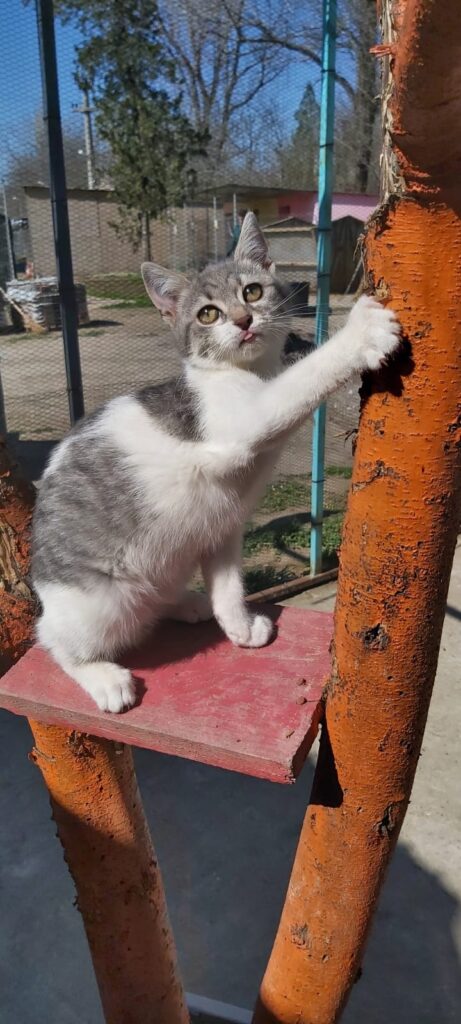 Since spring 2020, we have been running our second shelter specifically for puppies, the “Phoenix Puppy Shelter”, where up to 50 puppies and young dogs are fostered, cared for and prepared for placement in a family on an area of 2,000 m≤. In addition, we were able to move forward with a long-time wish in 2020 with the construction of the cat house on our premises. With the completion of this product, we can also provide our cats with safe and species-appropriate accommodations.
Since spring 2020, we have been running our second shelter specifically for puppies, the “Phoenix Puppy Shelter”, where up to 50 puppies and young dogs are fostered, cared for and prepared for placement in a family on an area of 2,000 m≤. In addition, we were able to move forward with a long-time wish in 2020 with the construction of the cat house on our premises. With the completion of this product, we can also provide our cats with safe and species-appropriate accommodations.
We have employed an average of 6 staff members in the shelters of Romania, who work in shifts so that someone is present at all times. Additionally, we have a driver and an office worker as well as the shelter manager on site. The tasks of the staff are mainly the support and maintenance of the dogs as well as night watch and administrative activities.
Our team consists of trained and certified dog trainers, professionals, and experienced fosters. We are also in contact with vets/veterinary assistants. In addition, we work closely with the local veterinary office, registering both our transports and our foster homes at this office, and can provide proof of the correct written documentation on transports, dogs and adopters at any time.
Our office is located in Germany, from where we coordinate all of the association’s activities. Various volunteer teams work under our guidance in the areas of social media, pre- and post-inspections, placements, adoptions, flea market and planning of the shelter travels.
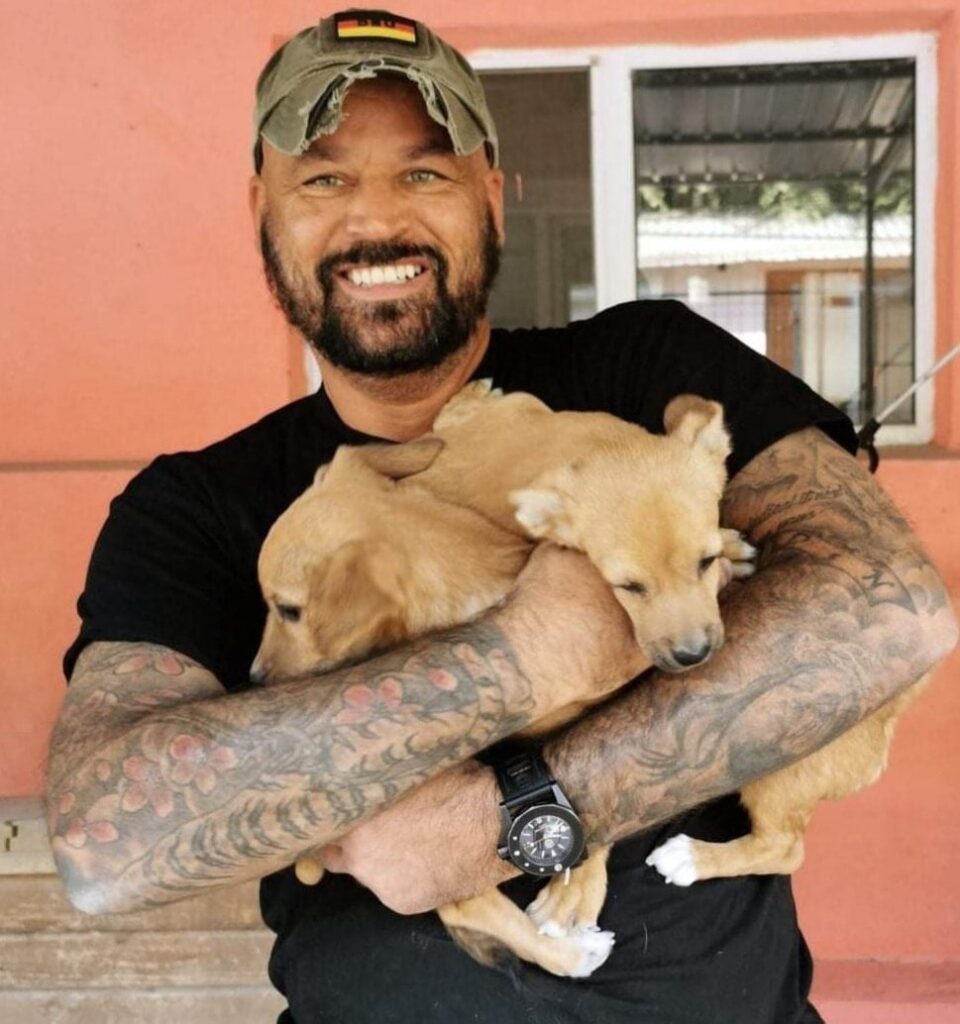
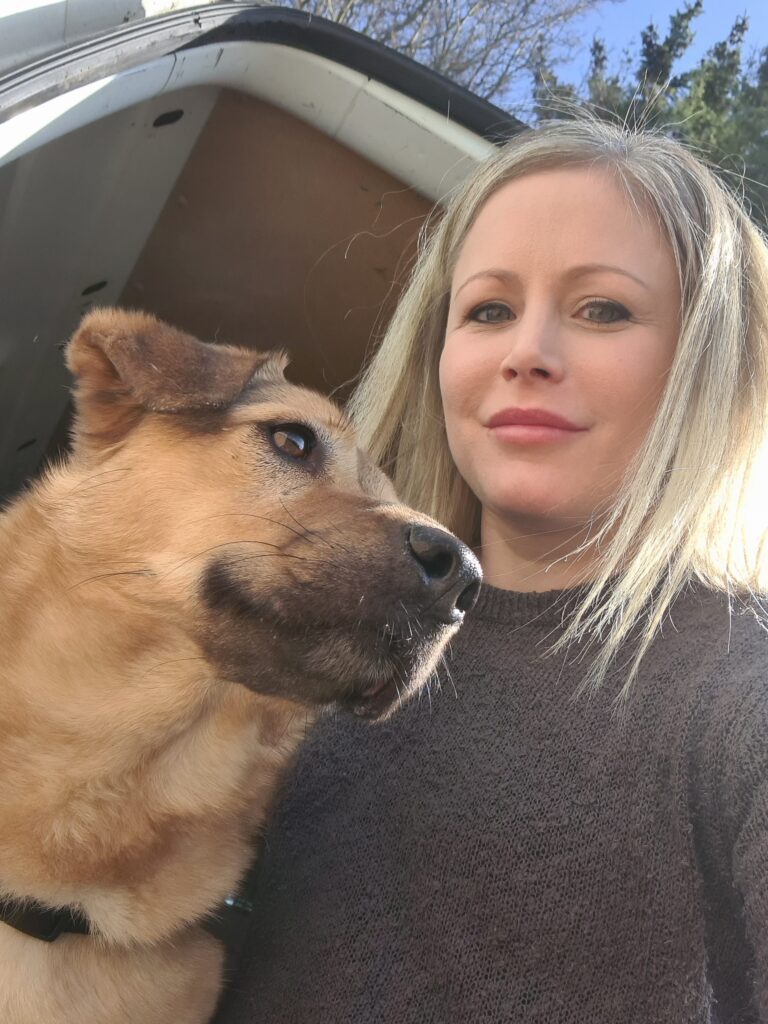
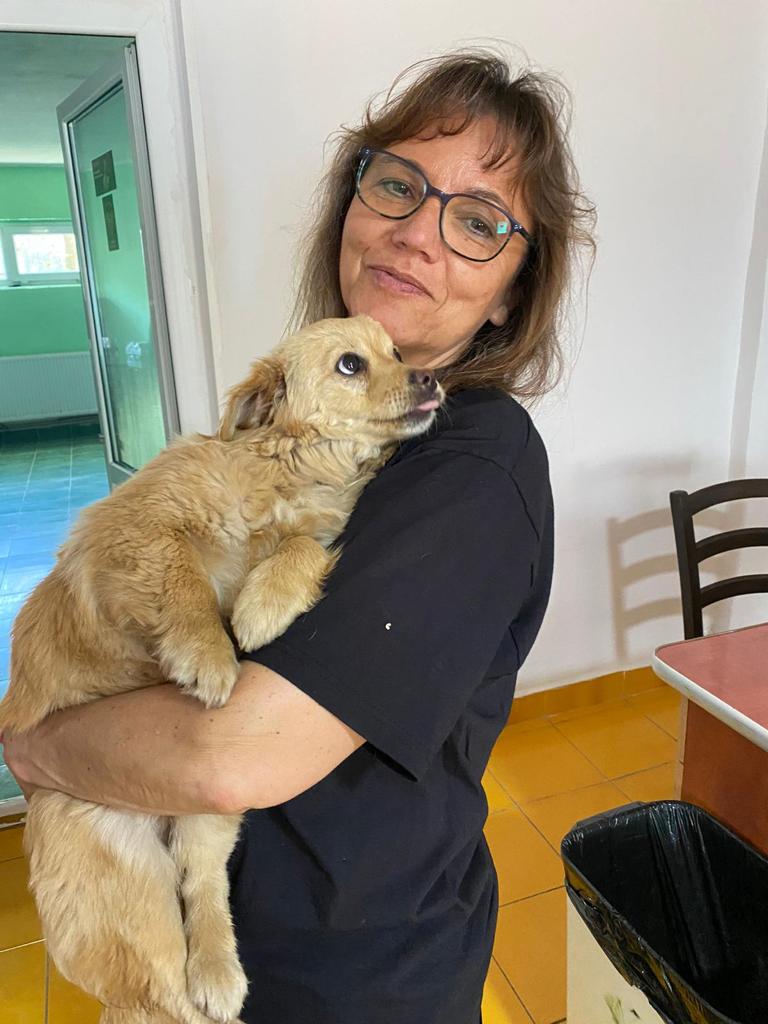
Jens Waldinger Sarah Goetschel Carmen Salcedo
Head and Manager of the shelter Head and Manager in DE of the placement Dog Management in Braila
A primary goal of our work is to relocate and find new homes for as many dogs as possible and place them into loving and safe families. We also provide a licensed transporter in order to transport our dogs and cats in our own equipped vehicles from Romania to their future families in Germany, Austria or Switzerland.
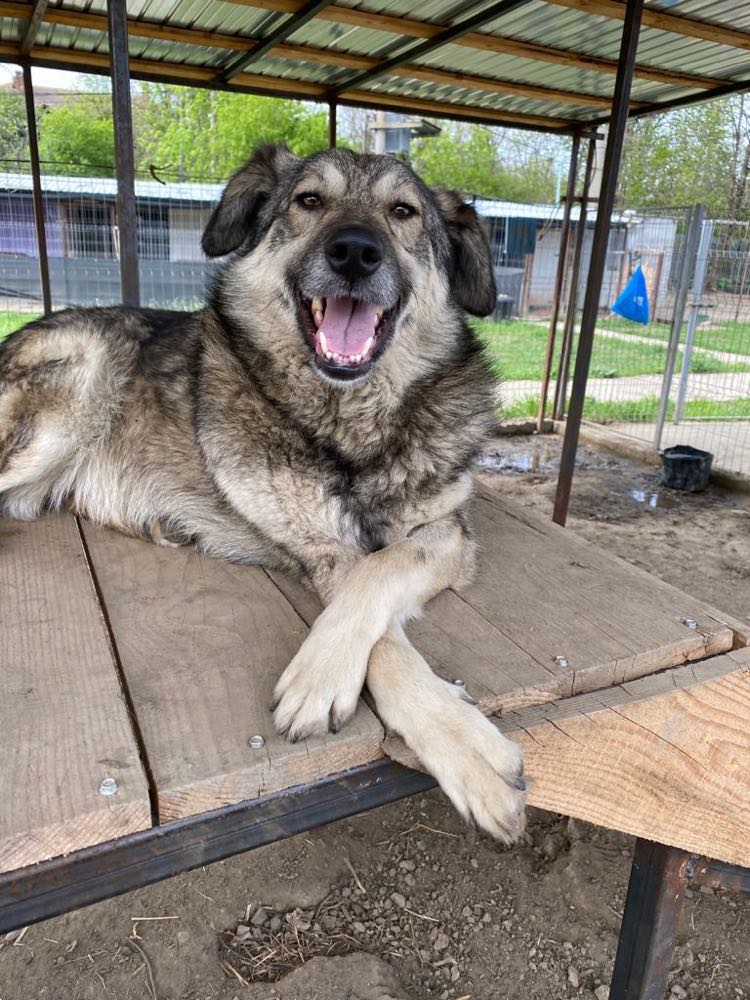
Lutz (top model, top dog)
We provide dogs, which are not suitable for a life as a family dog or for any other owner, a permanent safe refuge in our shelter. Here, they will have a better life without hunger and diseases, and are not exposed to the bad and cold weather conditions in Romania, especially during the winter season – just a stable and stress-free life.
Another goal for us is to make an important contribution by helping to control the reproduction of street dogs and cats through regular spay/neutering campaigns at our expense, and to bring about a change in the way the local population thinks about handling this issue. Due to the uncontrolled multiplication of street as well as house and yard dogs of the inhabitants, thousands of unwanted puppies end up on the streets or in the municipal animal shelters every year, which are allowed to euthanize these dogs after a period of two weeks if they are overcrowded. We also intervene here and are happy if we can take some of these dogs with us.
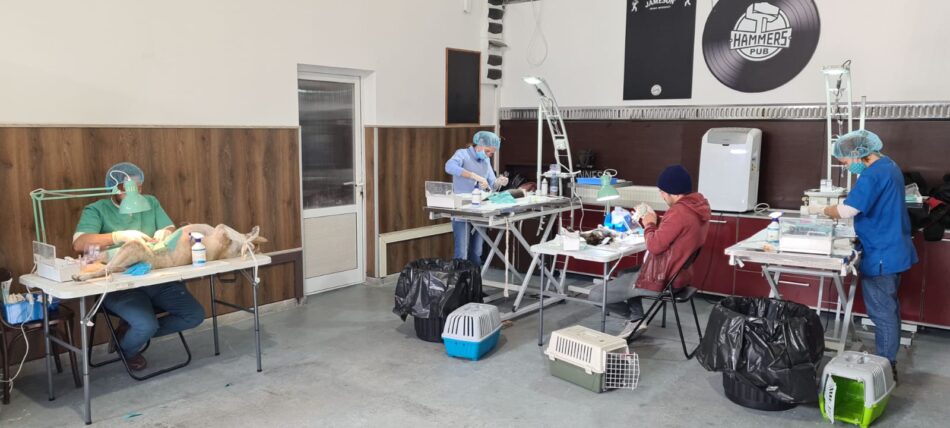
Spay/Neutering Marathon in Baraila, Romania
2. Omlet: What differs Einfach Tierschutz from other animal rescue organizations?
Einfach Tierschutz: First of all, the Einfach Tierschutz is a German association which is not only active abroad, but also runs its own animal shelter abroad. We do not solely relocate our dogs in Germany, but also in Switzerland and Austria. Mostly, we stand out because of our size: since we have started this organization, we now have over 8,000 members who support us. We have succeeded in convincing many people of our projects and know-how in just a few years, and with their support through donations, memberships, sponsorships, etc. we have been able to invest wisely.
We also offer our members the experience of traveling to our Phoenix Shelter in Romania. Our members then get to see first-hand what our team’s workload is on a daily basis. They also get to see what we have achieved in this short period of time with all the donations and membership fees we receive from them.


“There is a before and an after in my life: Before the trip to the Phoenix Shelter and after the trip, because since then I know what it is worth living and fighting for every day: “my” dogs there in the shelter. I may be back in Germany, but my heart has stayed there with the dogs.”
– Association member a few weeks after returning from a shelter trip
We offer our members the opportunity to follow our work on a daily basis via our Facebook members’ group. We provide pictures and video material from our shelter and thus allow every member to participate in current events. We also offer the opportunity to network with other members at more than 40 regulars’ tables and to plan joint activities such as information booths or fundraising campaigns.

We recently had our first big fundraiser where our members purchased lots from us in order to have the chance to win many great prizes from generous donors. The proceeds went directly to the shelter.
We are constantly working to improve our standards and ourselves professionally, in line with our ideas of good, sustainable animal welfare so that we can continue to grow and help as many animals as possible. In this way, we are always trying to maintain a balance between possible improvements and new projects or extension of our activities. We are very motivated and hungry to go further, to achieve even more.
3. Omlet: What do you like about your work? What is most rewarding?
Einfach Tierschutz: Every little success reminds us why we do all this. For example, the rescued dogs that we are able to bring into the safety of our shelter or animals that are brought back to life by our team after serious illness or injury make the work that much more rewarding! Also, seeing fearful and shy dogs that we have been able to socialize to such an extent that they can now enjoy their lives in a family makes the work worthwhile for us. All of these animals that are given a chance for a better life through our work is what makes the work priceless for us!
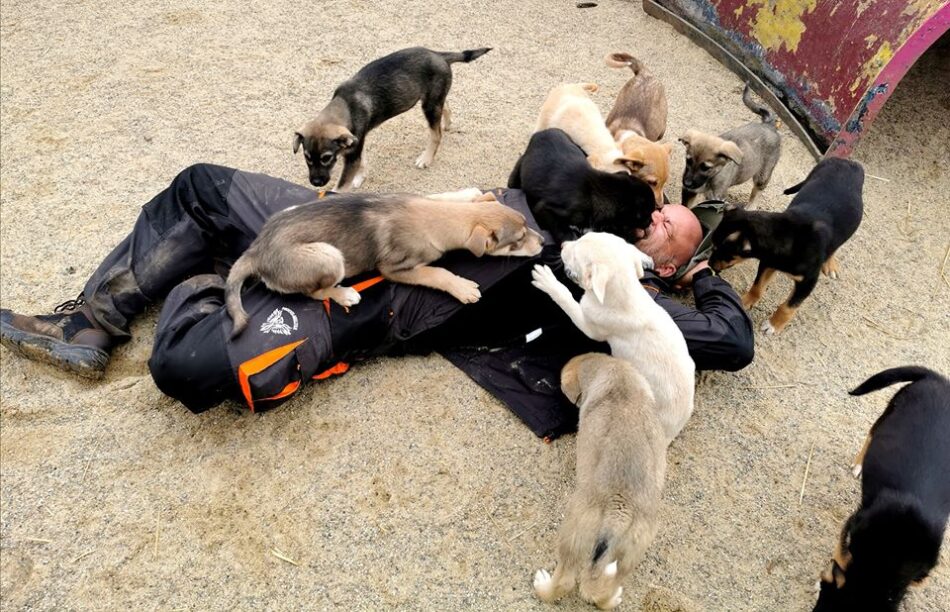
4. Omlet: Adoption vs. Purchase: what is the biggest challenge?
Einfach Tierschutz: From our point of view, the biggest problems are the mass breeding of pedigree dogs, while thousands of dogs are waiting for a loving home in the animal shelters. In particular, the illegal breeding and illegal transfer of puppies from abroad, which are then sold cheaply via various online portals by professional traffickers posing as private individuals, is a thorn in the flesh. As humans, we have a responsibility towards our fellow creatures and as long as the streets are full of unwanted animals that reproduce uncontrollably, suffering from hunger and diseases, we believe it is irresponsible to continue with breeding dogs.
Unfortunately, many people lack a sense of responsibility and foresight. Many hardly think about what it means to give an animal a home for the next 10 to 20 years and also give up far too quickly when the animal becomes “uncomfortable” for whatever reason. The decision to give up an animal is taken ever more quickly and lightly these days…

Floki (left) has also found a new best friend for life through his new home
5. Omlet: Speaking of adoption: What is important to you when looking for the right adopters, what expectations should a potential adopter fulfill ? What challenges or difficulties can you face when a shelter dog moves into its new home?
Einfach Tierschutz: It is very important to us that the family and the dog are well matched, which is why we work with the dogs on site to get to know them better and assess them as well as possible. Our employees in Romania also help with socializing the dogs when we are not around. Nevertheless, though we try our best here, we cannot predict what the dogs’ behavior will be like when they arrive at their new homes. Several factors will play a role. With the new environment, new people and maybe other companions it is hard to make a binding statement about it but so far, we mostly received positive feedback from the adopters.

Annett has finally found her family after waiting for such a long time
A dog from another country is always a bit of a “surprise package”. They are not familiar with our everyday lives and need time to get used to it. Through plenty of interaction with volunteers, outdoor runs and play sessions as well as walks, we try to keep the dogs as busy as possible and introduce them to new things. However, there is no comparison with the life they will experience with their future families. Some of them have never seen a leash or worn a collar or harness before, they are often unfamiliar with stairs, cars, bicycles, pedestrians etc. Some dogs are already house-trained when they move in, others need days, weeks or even months to train. Domestic or human smells and noises are often unfamiliar to them, and while one dog may be happy and react inquisitively, another may still feel anxious and need more time to realize that all of these changes are leading to a better quality of life.
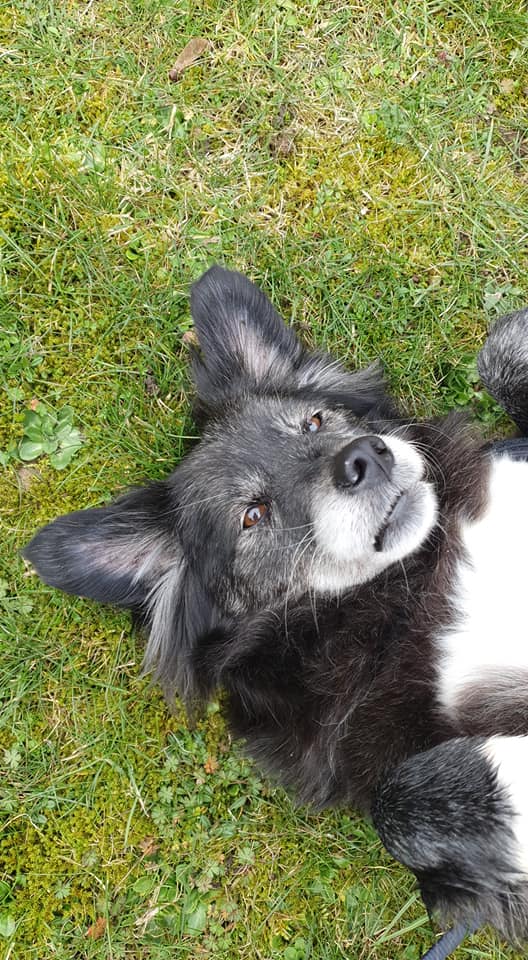
Hamlet not only found his forever home but also his favorite meadow where he can play and relax
The sensory overload, especially while settling in, can lead to dogs initially acting differently – often more timidly – than in the familiar environment of our shelter. This is why it is very important to us that we educate and prepare our adopters well before receiving the dog. We offer them thorough advice about dogs that are suited to their circumstances and lifestyle. We carry out pre-checks (and post-checks) and we discuss general aspects of adopting a dog from another country with the prospective adopters.
We have useful tips for them on how to deal with newly arrived dogs, with common behavior patterns during the settling in period and safeguarding during walks. Also, we talk about illnesses that cannot be ruled out based on incubation times. This information is constantly updated and further refined.
However, in those cases where, for whatever reason, things do not work out in the new home, we take care of finding a new place for the dog, and even provide emergency foster homes. Under no circumstances will we allow a dog that was placed by us to end up in another shelter.
Up to now, we have been able to offer a swift solution in each of the few individual cases, where contrary to expectations, the adopters had to return a dog. Thus, we have been able to make the best of the situation in the interest of the dog.
In case of problems, we assist our adopters with help and advice and we are always available after an adoption and happy to help! On our Facebook page you can find some great stories and photos of “happy endings” posted by the families and owners that have adopted these dogs .
6. Omlet: As an NGO, how do you raise money for your animals, shelters, sterilization projects, etc.? How are you compensated?
Einfach Tierschutz: In order to be able to cover the high project costs, we had to invest a lot of time in advertising and generating new supporting members to bring in enough donations. As an association that is mainly active via the fast-moving social media channels and also promotes the dogs through them, we depend on a well-functioning technical infrastructure.
The commitment of our local board is particularly important too, as it generates a lot of attention. Our local experts also have to regularly assess the socialization of the dogs, as we place them very responsibly to ensure that dog and family get on well together later on. We invest in our social media presence, promotion via billboards, newspaper advertisements, flyers, info sheets, stickers. As a result, we have been able to maintain our high level of popularity and success, – which of course goes hand in hand with a further increase in administrative expenses.
7. Omlet: Is there anything else you would like to share with our readers?
Einfach Tierschutz: We would like to take this opportunity to thank you for the interview and the interest in our association and invite everyone to get an idea of our work and visit our homepage or follow our social media activities. We – and especially the animals – would be very happy about a small donation, which we would like to invest in food, vet visits/surgeries/medications, spaying/neutering or in the shelter itself, e.g. for the expansion or the cat enclosure.
We would also more than welcome new fellow members who would like to get involved in our activities (e.g. shelter travels), gladly from anywhere. You can find all information on our homepage: www.einfachtierschutz.de
Phoenix-Shelter: https://phoenix-shelter.com/
Facebook: https://www.facebook.com/groups/einfachtierschutzvermittlungen
Instagram: https://www.instagram.com/einfachtierschutz/
(You can also set up the pages in your desired language.)
Yours,
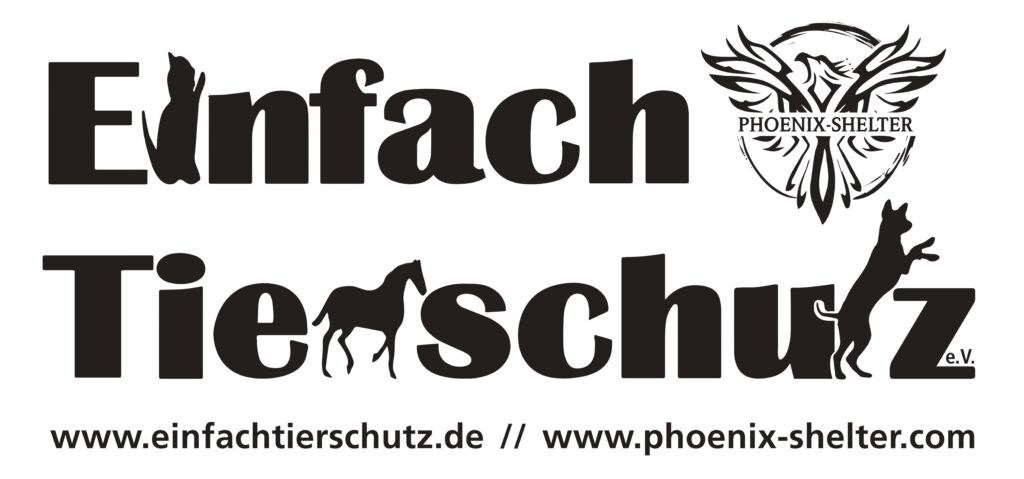
Omlet would like to thank Einfach Tierschutz e.V. for the interview and wishes them all the best for the future and that all dogs will find a great and safe new home.
This entry was posted in Dogs

This article is a part of our Pride of Omlet series, a collection of amazing stories which shine the spotlight on extraordinary pets and share their selflessness, bravery, talent and compassion with the world.
-Written by Anneliese Paul

Buster was destined to chase balls on the beaches of Barry Island. He’s a lovable labradoodle with big brown eyes and a long beard. A thinker with a playful nature, he’s co-authored a children’s book with his human Natalie to bring Autism Awareness to all.
 Ethan, Natalie’s son, was diagnosed with Autism and ADHD aged four. Natalie gave up her job as a teacher to become Ethan’s full-time carer. She always had dogs as a child and, naturally, wanted Ethan to experience the same positive companionship. They went to a local farm and had the pick of three puppies. One was fast and furious, one was quiet and sleepy, and one was in-between. They picked the inbetweener and called him Buster.
Ethan, Natalie’s son, was diagnosed with Autism and ADHD aged four. Natalie gave up her job as a teacher to become Ethan’s full-time carer. She always had dogs as a child and, naturally, wanted Ethan to experience the same positive companionship. They went to a local farm and had the pick of three puppies. One was fast and furious, one was quiet and sleepy, and one was in-between. They picked the inbetweener and called him Buster.
After a few weeks at home, it was clear that Ethan wasn’t taking to Buster. He just wasn’t interested in him. So he became Natalie’s companion instead, being a full-time carer isn’t easy and Buster’s a great source of comfort on difficult days. He motivates Natalie to keep going and gives her much-needed respite, with long walks on the beach.
A couple of years after Ethan’s diagnosis, baby Isobelle was born. Isobelle’s afraid of the dark, so Buster sleeps in her room and helps her feel safe. And in the daytime, Buster is Isobelle’s playmate. They love playing dress-up together, and at the end of the day, she’ll read him a story and brush his hair.
As Buster grew, the hair on his chin got longer and longer and longer! Until he developed a fully grown, 7-inch beard. It’s not a thing you see every day, a dog with a beard. People started staring. Natalie’s used to people staring, sadly many people don’t understand Autism, and when Ethan has meltdowns, Natalie and her family have experienced staring and unkind remarks, which have been devastating.
She realised that staring at Buster was something different. When walking on the beach, Natalie was approached by people asking, “Is it real? Have you stuck it on?!” It was curious and fun and got people talking in a good way. So what does a positive ex-primary school teacher do with that? She writes a children’s book, of course! Natalie wrote a story starring Buster called ‘That Dog Has Got a Beard’.
It’s a story about being special and unique. Natalie and Buster have toured schools and libraries all over Wales and even appeared on ITV Wales, opening conversations that celebrate differences and spreading Autism Awareness through the story of Buster’s Beard.
“A lot of children don’t see disabled children, and there’s a lot of negativity around it. You want people to be accepting, and a lovable labradoodle is an excellent way to open a conversation. He looks different. He’s got a beard. But that’s wonderful, you know? “

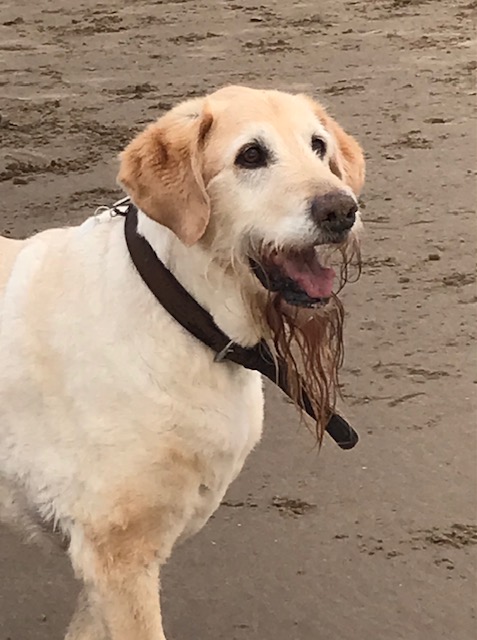
This entry was posted in Dogs

Some animals, such as rabbits and guinea pigs, are herbivores. Others, like hamsters, are omnivorous. Finally, there are also carnivores like cats that cannot survive without meat.
All animals need to have their nutritional needs satisfied. However, this does not mean you can’t have a vegan dog. Vegan cats, though, are a lot trickier.
Can my dog have a vegan diet?
 If you were to meet a species of animal for the first time and had to make an accurate guess about its diet, you would get lots of clues by looking at its teeth. The teeth of a dog, like the teeth of a bear, proclaim loud and clear that this animal is an omnivore – that is, one that eats both meat and vegetables. If you think of your dog as a domesticated wolf, you get a good idea of its natural diet.
If you were to meet a species of animal for the first time and had to make an accurate guess about its diet, you would get lots of clues by looking at its teeth. The teeth of a dog, like the teeth of a bear, proclaim loud and clear that this animal is an omnivore – that is, one that eats both meat and vegetables. If you think of your dog as a domesticated wolf, you get a good idea of its natural diet.
However, as the panda proves, a supposed meat-eater can sometimes get by perfectly well on a vegan diet. A panda’s teeth are similar to any other bear’s – long canines for meat-eating and molars for grinding vegetation. And yet pandas don’t eat anything other than bamboo. So, if a bear can be vegan, does that mean you can have a vegan dog?
The answer is yes – but it’s a yes with lots of small print! A dog requires a diet that contains the fats and proteins it would get from meat. It is dangerous to ignore this basic need and simply feed your pet with whatever you please. Some dogs have delicate stomachs at the best of times, and a low-fat, high-fibre diet can cause potentially life-threatening problems. A diet that excludes meat should never be fed to a dog without the advice of a professional pet dietician.
The collagen, elastin and keratin found in meat diets are not easily replaced by vegi equivalents. Your dog will also need the ‘long chain’ omega-3 fats found in animal products such as egg, fish and some meats. Vegan omega-3 fats are not the same as animal-derived ones.
All of which presents a headache for the vegan dog owner. There are, however, products available that claim to let your dog live a healthy, meat-free life. Before you take the plunge, it is essential to seek professional, scientific advice and guidance. Compromise is usually the best choice here – a vegan diet supplemented by some of the animal-derived essentials. Crickets, for example, can provide lots of the amino acids and keratin a vegan diet lacks, and they’re 65% protein.
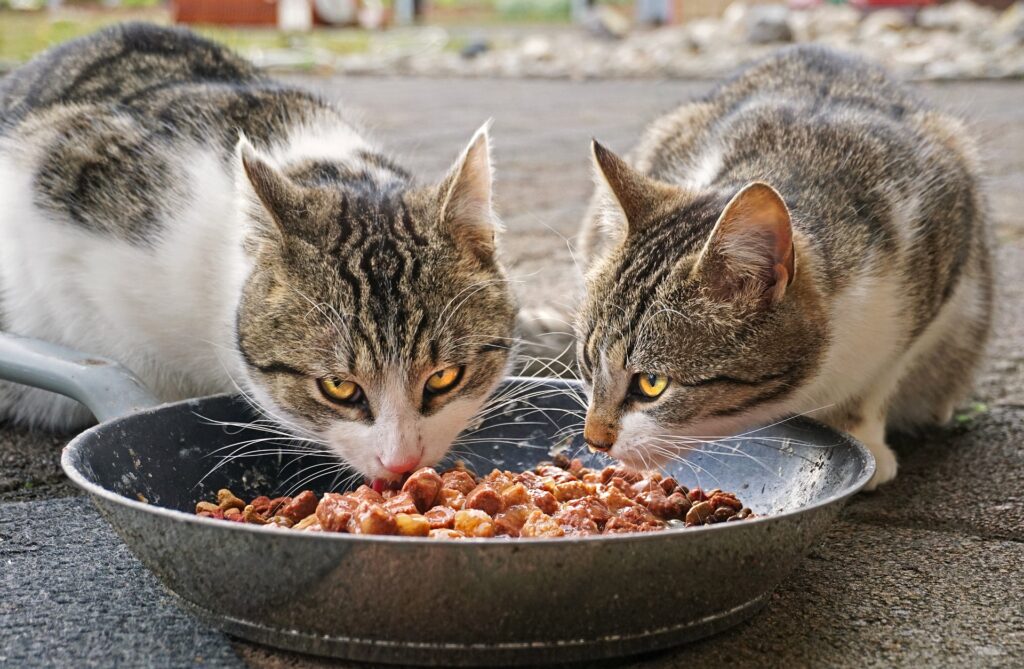
Can my cat have a vegan diet?
The compromise approach is even more important for cats. These are amongst the planet’s true carnivores, obtaining all their dietary requirements from other animals.
The main challenge with minimising the meat in a cat’s diet is that, unlike many mammals (including dogs), cats cannot produce certain proteins. They have to absorb these from the meat and fish in their diet. Amino acids are another issue – cats deficient in the animal-derived amino acid taurine, for example, usually succumb to a specific type of heart problem.
Even a fortified vegan cat food cannot be confidently recommended. Turn the situation on its head, and try to imagine weaning a rabbit onto a meat-only diet, and you get some idea of the challenge – and the ethics – involved.
There are some lab-grown ‘meat’ products in development, with vegan and vegetarian cat owners in mind. However, whether these will arrive – and remain – on the market any time soon is hard to guess.
For many vegan pet owners, there is a huge ethical issue involved in feeding the animals they share a space with. Ethics, however, include the animal’s needs too, and it’s an almost impossible issue to resolve when it comes to cats. If you are able to reduce but not eliminate the meat in your cat’s diet, that’s the safer option.
Top 10 pets for vegan households
There are, of course, plenty of other pets that don’t eat meat, or that eat some meat but can still thrive on a meat-free diet. Here are our ten favourites.
 1. Rabbits. No problems here – rabbits are happy vegans, with diets based on hay and vegetables. You could argue that the soft pellets they eject and then eat are animal products of a sort, but they are simply semi-digested vegetation.
1. Rabbits. No problems here – rabbits are happy vegans, with diets based on hay and vegetables. You could argue that the soft pellets they eject and then eat are animal products of a sort, but they are simply semi-digested vegetation.
2. Guinea pigs. Like rabbits, these wonderful little characters thrive on a 100% vegan diet.
3. Hamsters. Most hamster owners give them store food, you don’t always know what’s in it. However, hamsters, like rats and mice, can do without meat.
4. Gerbils. Like hamsters, gerbils are omnivorous. They have sensitive stomachs and need a quality pellet mixture. Food that is too fresh can harm them.
5. Mice. Although they will eat pretty much anything in the wild, mice can thrive on vegan diets; but it is still best to use a food mix prepared specifically for them. This ensures that they will not be deficient in any of the vitamins and minerals they need.

6. Rats. These are the most omnivorous of rodents, but as long as you feed them a vegan mix that has been fortified with all the nutrients they need, they will thrive. Indeed, rats who eat too much animal fat tend to become fat and die prematurely.
7. Chickens. If you watch a free-range hen, it soon becomes clear that she will eat anything – grass, beetles, worms, and everything in your veg patch if you’re not careful! Most chicken feed emulates this mix of plant and animal products. However, it is possible to buy vegan chicken feed, and circumstantial evidence suggests that hens can thrive on it. However, they are likely to produce fewer eggs, and you will not be able to stop them scratching for worms and bugs, no matter how vegan the layers pellets are!
8. Budgies and parrots. Vegans will have no obstacles to face with budgies and parrots, unless the birds are being bred. Egg-brooding female birds need a protein boost, normally delivered via an egg-based food or cooked meat. Vegan alternatives are available, though.
9. Finches. Many finch species enjoy bugs and mealworms as treats, but these are not an essential part of an adult finch’s diet. These birds thrive on a mixture of seeds and fresh vegetables.
10. One for reptile fans. When you think of pet snakes and lizards, you probably have an image of dead mice or doomed crickets. However, there are a few commonly kept pet reptiles that eat a 100% vegan diet, the most popular being the Green iguana. Getting the balance of vegetables just right is very important for the animal’s health, but meat is certainly something you won’t have to worry about.
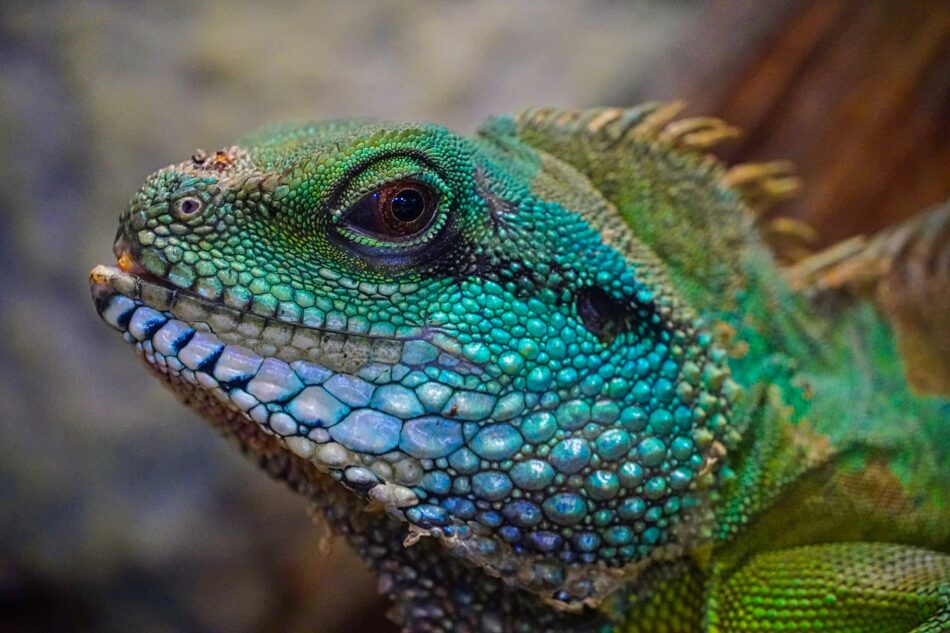
There is no shortage of choice when it comes to vegan pets. Keeping a vegan cat or dog is a much trickier proposition, though. And with all these animals, a balanced diet that matches the pet’s nutritional requirements should be your primary goal.
This entry was posted in Budgies
Dogtor Adem, founder and owner of Dog-Ease, is a dog behaviourist and trainer with over 15 years experience working with dog owners and their canine best friends. In this blog post, Adem provides us with helpful tips on preventing dog theft, and what to do if you experience dog theft yourself.

With dog theft on the rise, it’s only natural that we might feel worried about taking our furry family members out and about at the moment. I think most of us can agree that if anything should happen to them, we would feel devastated. So, I have put together my top tips for keeping your dog safe from theft when both at home and out and about. Following on from this, I’ve also put together some tips on what to do should you find yourself in the awful position of your dog having been stolen. I hope you never have to refer to them, but they might just help you be reunited should you find yourself in this unfortunate position.
MY TOP TIPS FOR PREVENTING YOUR DOG THEFT
START AT HOME
By this I mean you should review your current security measures at home. Start by ensuring gates and fences are secure and avoid leaving your dog in the garden unattended. You may also want to ensure your dog cannot be seen by people passing by when you are out of the home. You can do this by making them a base in a room away from any windows that can be easily looked into or even by closing the curtains on these windows when you are out.
MAKE SURE YOUR DOG IS MICROCHIPPED
It is not only law to have your dog microchipped, but it is also best practice. If your dog is ever separated from you a simple scan of their chip in their neck area should reunite you pretty quickly. Keep your dog’s microchip details up to date. It’s usually really easy to do this over the phone or online.
ADD AN ID TAG TO YOUR DOG’S COLLAR AND CONSIDER A GPS TAG ALSO
By law, your dog should have an identification tag attached to their collar when outside of your home. This makes it really easy for you both to be reunited without needing your dog’s microchip to be scanned. You could also consider attaching a trackable GPS tag to your dog’s collar. There are many on the market to choose from and these can be purchased online, if not from your local pet shop. Some also have fun features to use on a daily basis such as tracking your dog’s activity levels.
TEACH YOUR DOG THE RECALL COMMAND
Teach your dog the recall command and make coming back to you a fun game that you can play throughout your walks together. Offer a tasty treat or engagement in a game such as fetch each time they return to you. This makes them more likely to want to return to you, seeing the recall as a fun part of your walk. Head over to the Blog page of my website www.dog-ease.co.uk/blog/ to watch a tutorial on how to begin this training if you haven’t already had a chance to.
KEEP YOUR DOG’S ATTENTION
Make it fun for your dog to stay close to you on your walk if you are letting them off lead. For example, you could practise off lead heel work as you walk, offering a tasty treat as a reward for their focus, or play recall games. Taking a special toy such as a ball can also help to keep your dog’s attention and focus with them chasing and retrieving during your walk.
KEEP YOUR DOG IN SIGHT
Following on from keeping your dog’s attention, avoid letting your dog go out of your sight on a walk or leaving them unattended outside a shop, school, or even in your car. The less opportunity for them to come into contact with strangers without you also present, the better.

WALK WITH OTHERS
If possible, walk with a family member or socially distanced with a friend. You could also try to walk in public areas where other people are walking and present too. Pick times of the day where other people are likely to be around and walk in daylight if possible. If this is not possible, try to walk in well-lit areas. Safety is often found in numbers and the more people that are around the less likely you may be to be targeted.
CONSIDER TAKING ANTI THEFT DEVICES WITH YOU
Consider taking an anti-theft alarm or another similar device on your walk with you, even a whistle is better than nothing to be able to attract attention with. You could also try to keep your mobile phone handy to use if necessary, although it’s best to not allow your mobile phone to distract you from what is going on around you as you walk. See the next tip!
STAY ALERT
Following on from the tip above, stay alert and be vigilant on your walks. Watch out for any unusual activity or people in the areas you might typically walk. It is best to limit your use of any electronic devices such as your mobile, even to listen to music. The more aware of your surroundings you are, the more likely you will be to spot anything not quite right.
AVOID CLOSE CONTACT WITH STRANGERS
Avoid letting people you don’t know pet your dog or telling people you don’t know any details about you and your dog. It’s nice to be friendly but be vigilant about the information you share.
BE LESS PREDICTABLE
If you’re particularly concerned, change up your routine frequently. This makes it harder for anyone ‘watching and waiting’ to predict and plan to ‘bump into you’ on a walk.
PREP OTHERS WHO ARE RESPONSIBLE FOR WALKING YOUR DOG
If you use a dog walker, ensure you ask them what steps they are taking to avoid your dog from being stolen. You can also ask that they remain vigilant in securing your property when returning your dog to your home and ask that they look out for and alert you to any unusual activity.
USE SOCIAL MEDIA AND LOCAL NEWS TO YOUR ADVANTAGE
Check local social media pages and local news for up-to-date information on what is going on in your area. Often any worrying incidents are reported by residents with details of suspicious people and even sometimes vehicles too look out for.
BE MINDFUL OF WHAT YOU SHARE ONLINE
Sharing your location and details of your pet on non-private forums such as on non-private social media pages can alert potential thieves to your where abouts. Make sure you are mindful of what you share and where you ‘check in’, with or without your dog.
WHAT SHOULD YOU DO IF YOUR DOG IS STOLEN?
In the awful event that your dog is stolen, here are some tips to help you find and be reunited with them.
REPORT THE THEFT IMMEDIATELY
Report the theft immediately to the police and ensure it is recorded as a crime rather than as a lost pet. You should receive a crime reference number for your records.
CHECK CCTV
Check all available CCTV footage in the area your dog was stolen from to gain evidence of any people needing to be identified or vehicles that may have been involved. You might also want to check in with neighbours and those in the local area to see if anyone has any footage from their own security systems – from Ring Doorbell footage to Dash Cam footage. Anything is worth a shot and could lead to identifying something or someone.
CONTACT YOUR MICROCHIP COMPANY
Contact the company your dog’s microchip is recorded with and register your dog as stolen. If your dog is scanned by a vet elsewhere, they should then be alerted to this and your dog returned to you.
CONTACT LOCAL VETS
Contact all vets in the local area to let them know of the theft. Provide a photo of your dog if possible and include details of any markings or particular features that they have so they can identify them more easily.
MAKE THE PUBLIC AWARE
Make other people aware of the theft by putting up posters stating your dog has been stolen, with your contact details on them. You should also post a copy of such posters, or an equivalent, on social media sites. If you ensure that the settings of your post are set to ‘public’ you can ask others to share your post and reach a much wider community. The further your dog’s details are shared, the more chance you have of your dog being identified and returned to you!
DON’T GIVE UP
Don’t give up hope! Keep sharing your dog’s details far and wide. Someone somewhere might know something and help you to be reunited.
I hope you found the above tips useful. Stay alert and keep safe!
Dogtor(tm) Adem
Owner of Dog-ease Training & Behaviour
www.dog-ease.co.uk
This entry was posted in Dogs

This article is a part of our Pride of Omlet series, a collection of amazing stories which shine the spotlight on extraordinary pets and share their selflessness, bravery, talent and compassion with the world.
-Written by Anneliese Paul
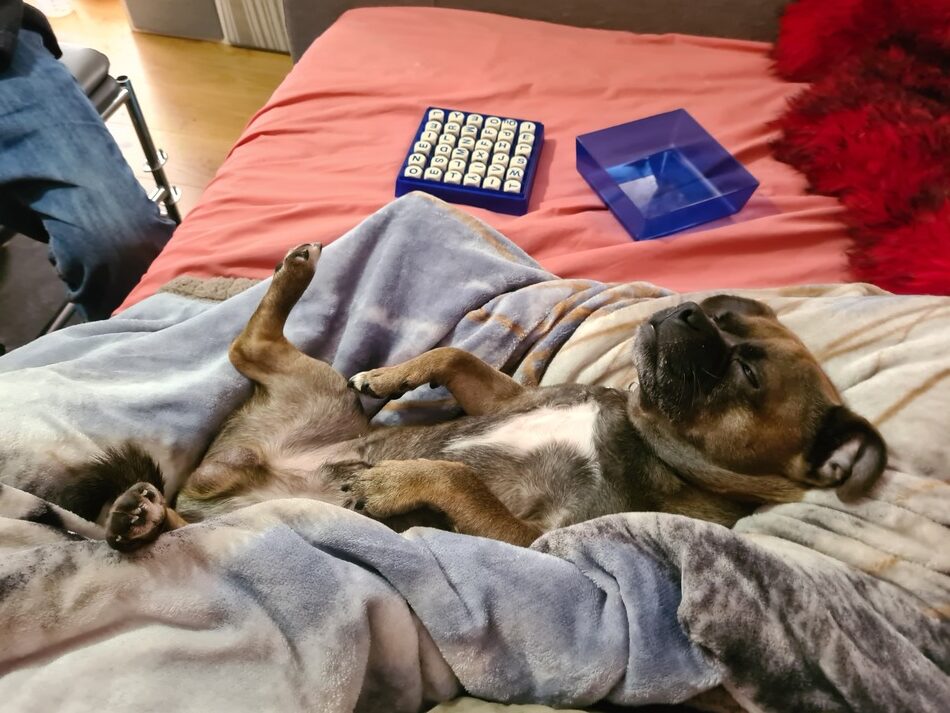
Mipit is a Mental Health Assistance Dog for his human, Henley. Mipit keeps Henly alive and independent. Who wouldn’t love a dog that can put out your recycling, answer your phone, and be your best friend, come rain or shine?
Six years ago, homeless and experiencing mental health crisis, Henley was given a glimmer of hope when she was offered a flat. She reconnected with her mum and dad, and slowly, life started to improve with their help. But something was missing. Henley needed a companion.
Henley’s autistic and always wanted an autism assistance dog, but by now, Henley was too old to apply. One day, Henley and her mum went to get their hair cut. The hairdresser suggested they go to the nearby pet shop to ask if they knew of any puppies; the pet shop gave her two phone numbers. As Henley was leaving the shop, she spotted a leaflet on the window about Mental Health Assistance Dog training.
Henley rang the breeder’s numbers and soon after brought home her first puppy. A jug (Jack Russel cross Pug) she named Lottie. First, she began training with the Kennel Club good citizen dog scheme and then assistance dog training with Darwin Dogs. But at six months old, Lottie was attacked by a pack of six dogs, and Henley decided to stop her training to give her time to recover. With Lottie better, Henley felt it would be good for her to have a friend. So she called Lottie’s breeder to see if any more pups were on the way. Luckily Lottie’s grandmother was pregnant, and when the puppies were born, Henley went to visit and brought home Mipit.
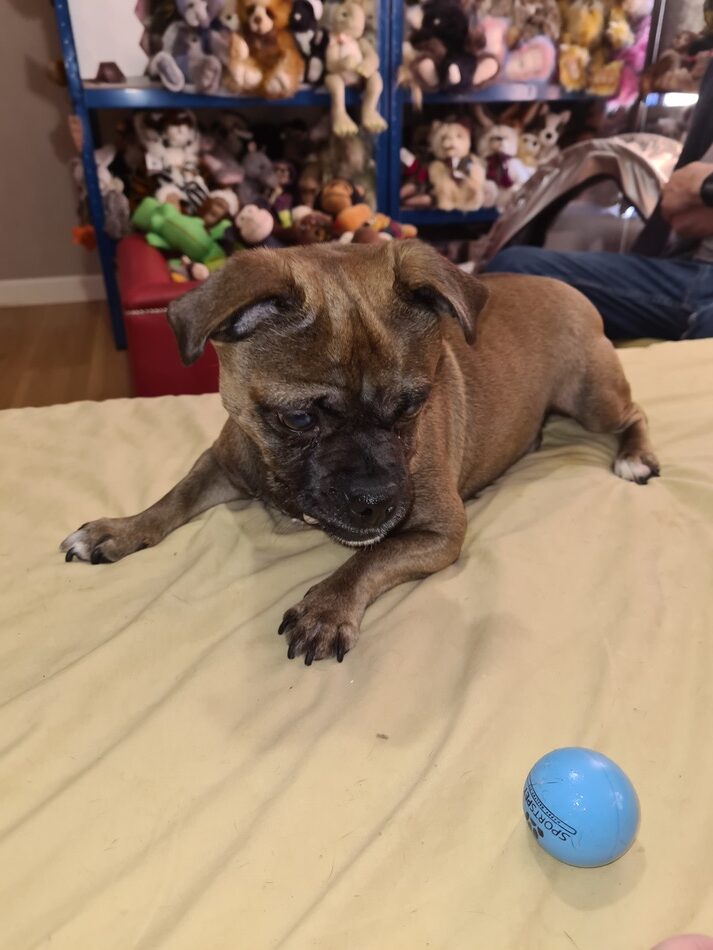
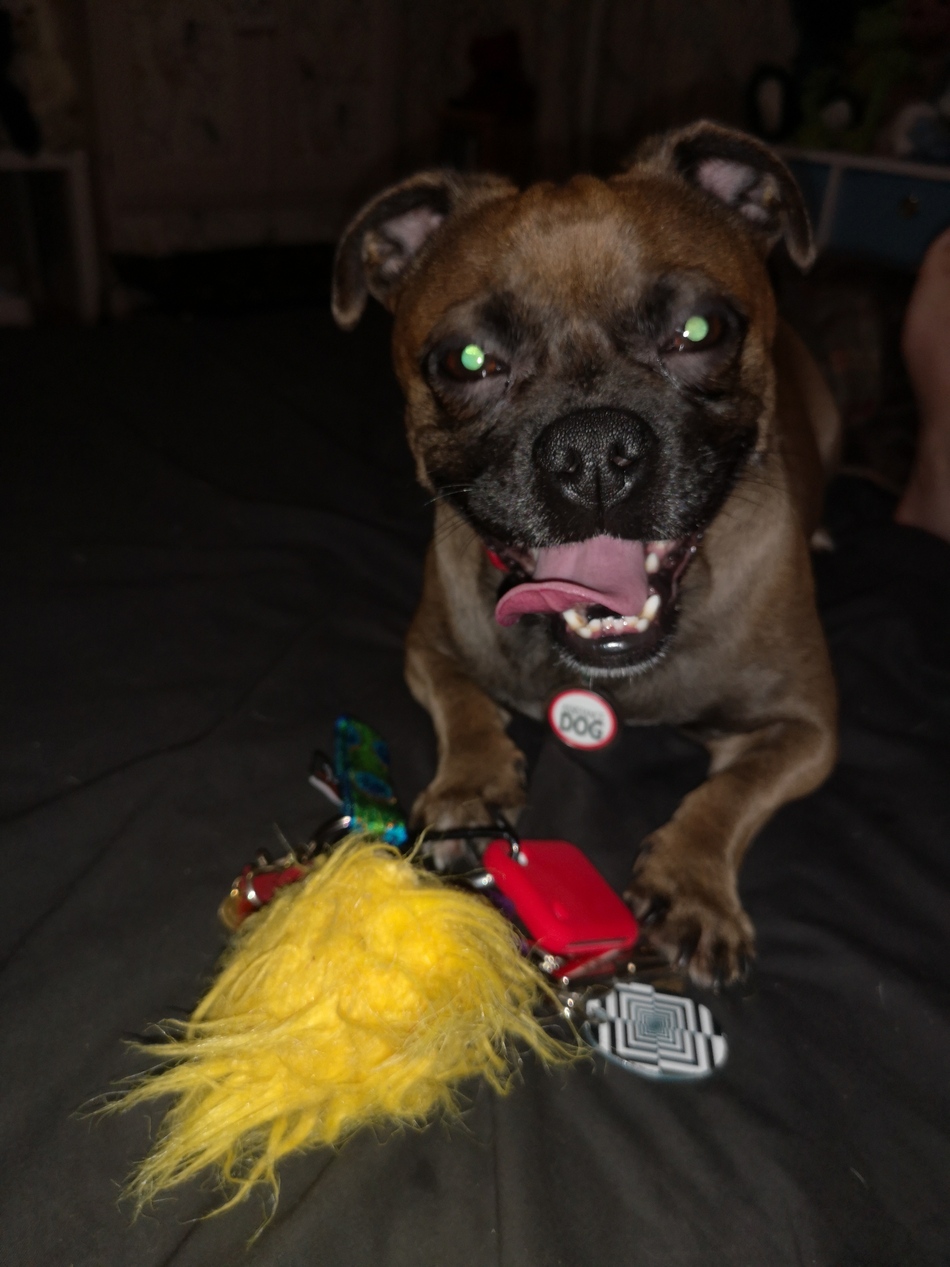 Mipit’s a Jug like Lottie, who Henley chose for his rebellious nature, but despite wayward first appearances, he’s proven to be intelligent, loving and loyal. Within a few weeks, Mipit was doing things that Lottie had taken months to learn, and Henley decided to focus her assistance dog training with Mipit.
Mipit’s a Jug like Lottie, who Henley chose for his rebellious nature, but despite wayward first appearances, he’s proven to be intelligent, loving and loyal. Within a few weeks, Mipit was doing things that Lottie had taken months to learn, and Henley decided to focus her assistance dog training with Mipit.
He flew through both bronze and silver Kennel Club assessments by the age of one. He was too young to start gold, so Henley started assistance dog training. In under two years, he’d completed all three levels. Lottie had taken the same time to complete only one. Mipit’s instinctive with training. “He can see into the future,” says Henley. “It’s like he already knows before you’ve trained him.”
Henley uses a wheelchair and Mipit is always beside her, ready to help. He opens doors, picks up the phone and takes out the recycling. He does things to make Henley laugh, like playing hide and seek under the duvet. He never turns off. Mipit’s training with Darwin Dogs is unlike any other assistance dog training. Henley has developed a partnership with him to train him in three special skills that are unique to her needs.
Mipits first special skill is to lay flat on Henley’s knee, giving deep pressure therapy to help with the pain she has in her legs. Secondly, he’ll fetch and retrieve anything up to his own body weight. His third skill is a showstopper. If Henley’s been upset anywhere, Mippit will sing to her to help her recover. He often sings Henley out of Sainsbury’s to get her ready for the journey home, and Mipit has become known for his singing in their home town. Sometimes Henley is stopped by people asking, “Are you the one with the singing dog”, and Mipit will gladly give a little performance.
Last year Henley lost her mum. This was devastating for Henley’s mental health. Both Henley and her Dad, Chris, credit Mipit with keeping them a team, working through difficult times and keeping their bond strong. “He forces us to be together in a lovely way. He’ll cuddle Dad and bring him to me. He dives up and gives me kisses when he knows I’m poorly.”
Mipits unconditional and constant devotion to putting a smile on Henley’s face gets her ready for the day, every day. With the help of Mipit and Lottie, Henley hasn’t self-harmed in six years and now lives in a bungalow with a garden with six chickens for company. Soon two rabbits will be joining their extra special support bubble.
Henley’s dad Chris says, “I watch Mipit because he picks up on Henley’s mood. When she’s not feeling good, he moves closer. It gives me comfort to know Mipit is looking after her. He’s a cracking little chap.”
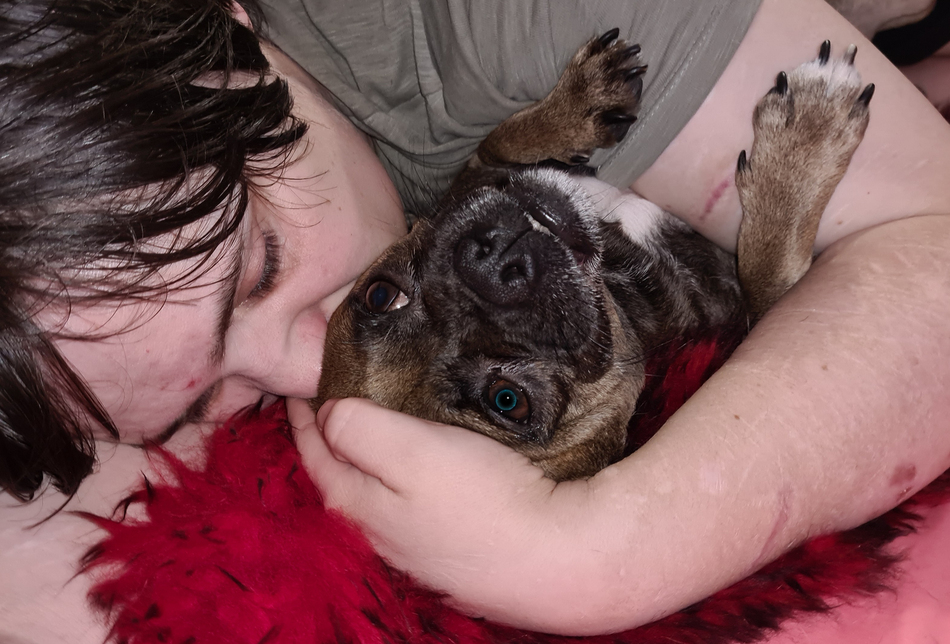
This entry was posted in Dogs
 It can be tricky to decide whether or not your dog should wear a collar or a harness for walks. A lot of it depends on your dog himself, from the breed to his age and activity level. No matter what type of breed you have, one thing’s for sure, they all need to go out on walks! The main two types of leash attachments that you can use for your dog are harnesses or collars.
It can be tricky to decide whether or not your dog should wear a collar or a harness for walks. A lot of it depends on your dog himself, from the breed to his age and activity level. No matter what type of breed you have, one thing’s for sure, they all need to go out on walks! The main two types of leash attachments that you can use for your dog are harnesses or collars.
Whether you just got a new dog and aren’t sure which to use, or you are looking to switch things up, it’s important to know the pros and cons for both dog harnesses and collars before making a decision.
Collars
Pros
Dog collars are the best when it comes to controlling aggressive dogs, puppies or dogs who are in training. It gives confidence to the owners where they can let their dog walk without any fear. It comes with many direct benefits while providing better control to the handler. Dog training is one of the most important reasons for buying a dog training collar. It is one of the first dog training tools that an owner would need. It helps your dog to successfully overcome obstacles. It also helps to guide your dog and secure his attention if it has a short attention span.
Your dog may get a bit rowdy during the walking session. It’s the dog collar that can correct its behaviour when it is misbehaving. Dogs can go on jumping fences, playing in woods, or getting into mischief; so, you should consider durable dog collars with breakaway fasteners.
The main benefit of collars is that it’s more convenient than a harness. They can be left on at all times as opposed to a harness, which should only be worn during walks and it’s much easier to snap a collar on and off than a harness.
Another great benefit of wearing collars comes with the metal ring where you can attach your pet’s ID tag or name plates with your address, your phone number, veterinarian office phone number or the tag of the dog registration organisation where your dog is registered for identification in case he or she gets lost.
Are you a fashionista or do you love to express individuality? You can even use a bow tie or bandana/scarf as an attachment for the collar.
Cons
What can go wrong when you lead a dog by the neck? Quite a lot, it turns out.
The safety of your dog’s neck plays a vital role here. If dogs constantly pulls against their collar, they can injure themselves or reduce the airflow they are getting. Some smaller breeds, like miniature dachshund or poodle, are prone to collapsing tracheas, and a rough tug on the collar can quickly turn into an emergency situation.
Other dogs’ necks are as thick as their heads, e.g. pugs and whippets, so slipping out of a collar is effortless. Even if you have a tough mutt or working dog, repeated pulling on the neck can lead to thyroid damage or spinal injuries over time. Please avoid using collars to walk dogs with medical issues such as glaucoma, a history of proptosed eye, neck injuries, or spinal malformations.
Collars should also not be used on toy breeds and brachycephalic breeds, such as Chihuahuas, Chinese Crested, Italian Greyhound, Maltese, Toy Poodle, Yorkshire Terrier, Bulldogs, French Bulldogs, Boston Terriers, Pugs and Boxers.
Harnesses
Pros
The main benefit for using a dog harness instead of a dog collar is the control you have over overly excited dogs. If it comes to safety and security, harnesses are generally better at preventing accidents because they fasten more securely around your dog’s body and are simply the most secure, and most comfortable way to hook your dog up to his leash. It covers your dog’s chest, shoulders, and upper back, which disperses pressure over a larger surface area whereas collars give you better control over your dog. While dogs can easily slip out of their collars and potentially run into traffic or another person’s yard, harnesses offer much more security and safety.
A good harness will reduce pulling, increase your control over your pup, and decrease stress on his neck and joints. Bonus points: because it secures closer to the dog’s centre of gravity, a harness gets tangled in the leash less and helps prevent jumping.
There are different kinds of harnesses, starting from cool, cute or practical, such as bags where you can put some treats or eco-friendly waste bags
When it comes to specific breeds or diseases, a harness has a better function for your dog:
- Brachycephalic breed: These breed dogs typically have flatter faces, “shortened head” and refers to the short nose and flat face of dogs like Pugs, Shih Tzus, Chihuahuas, Chow Chows, Pekingese, French Bulldogs or Bulldogs. Respiratory issues may be better managed with a harness.
- Tracheal collapse: This is a medical condition where the trachea will fold in on itself causing trouble breathing and a cough. Please avoid using a collar because it applies further pressure and can even worsen the condition.
- Risk factors for spinal problems: A condition called intervertebral disc disease (IVDD) makes long-bodied breeds such as dachshunds very prone to slipped disks. By using a harness you can take pressure off the neck and back and help prevent further damage.
- Orthopaedic disease: Dogs with orthopaedic disease can have a hard time getting up to walk so a harness can help you get them up and move around more easily.
Cons
Harnesses are just less convenient than collars for hoomans. A collar can just slip on, but harnesses take more time to fasten.
Harnesses can be uncomfortable: Harnesses are bulkier than collars, so they can be more uncomfortable for your dog. Some dogs really don’t like wearing harnesses, so it can take some time for them to get used to it.
Harnesses may not have a place for carrying an ID tag. It’s best to get a harness with a ring for a tag—or use both a collar with a tag and a harness when out walking.
If your dog wears weather protection or due to some illness needs to wear clothes, a harness might be a bit more of a disadvantage than a collar. The clothes might cover the harness ring(s), so that you’re unable to put a leash on. Alternatively you can attach the harness over the clothes but make sure -in general- it’s neither too tight nor too loose.
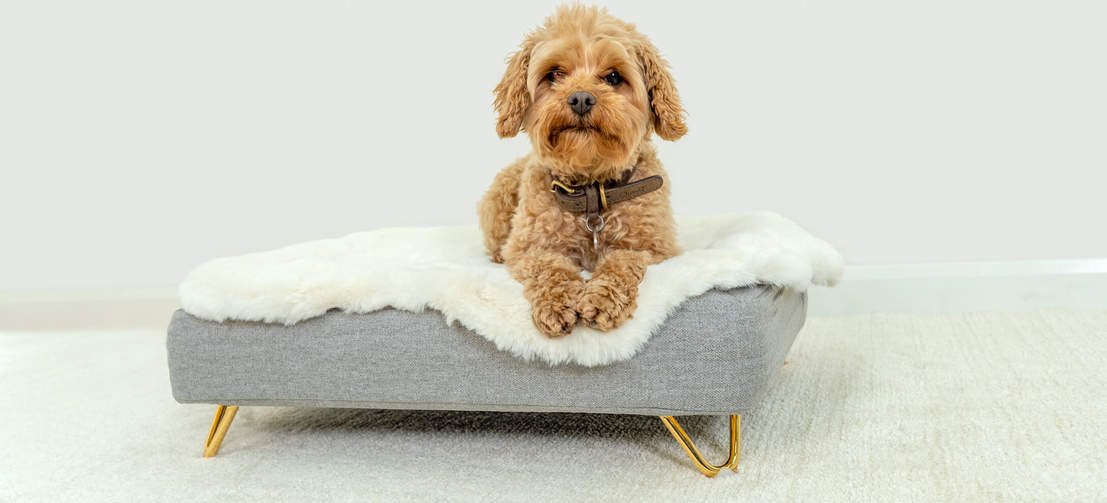
The Sheepskin Topology Topper provides dogs with a luxurious place to rest.
Summarising
So, collar or harness – which one is now the better option for your dog? There is no general answer to this question as it always depends on the breed and health of your pooch and the use of the item. But please, always keep in mind:
- Collars are less restrictive on movement, which is good for working dogs who are running around all day. Collars are also better for dogs that don’t pull and can calmly walk by your side.
- Harnesses are better for overly excited dogs as you have more control over them.
- Smaller dogs and brachycephalic breeds should avoid wearing a collar.
- It is absolutely advisable to get your puppy used to both, collar and harness.
- If you want to transition an older dog or even a pup from collar to harness be patient – the adjustment phase may take some time. Bring some treats along on your first few harness walks to distract your dog from that unfamiliar feeling, as well as associate the change with positive rewards.
- It also depends on the use of the item. If you want to have a walk with your buddy or take a ride with him in your car (to fasten the seatbelt), it is recommendable to use a harness. If you just let him out in the garden or take him to your friends’ house, a collar is totally fine – same goes with dog kennels.
To sum up, harnesses are usually the best choice for walking dogs because they don’t put pressure on the neck. But collars are generally more comfortable and have a place to hold an ID tag. At best, let your buddy wear both: If you can’t attach a tag or name plate to the harness, use a collar for the ID tag and a harness for the leash.
This entry was posted in Dogs
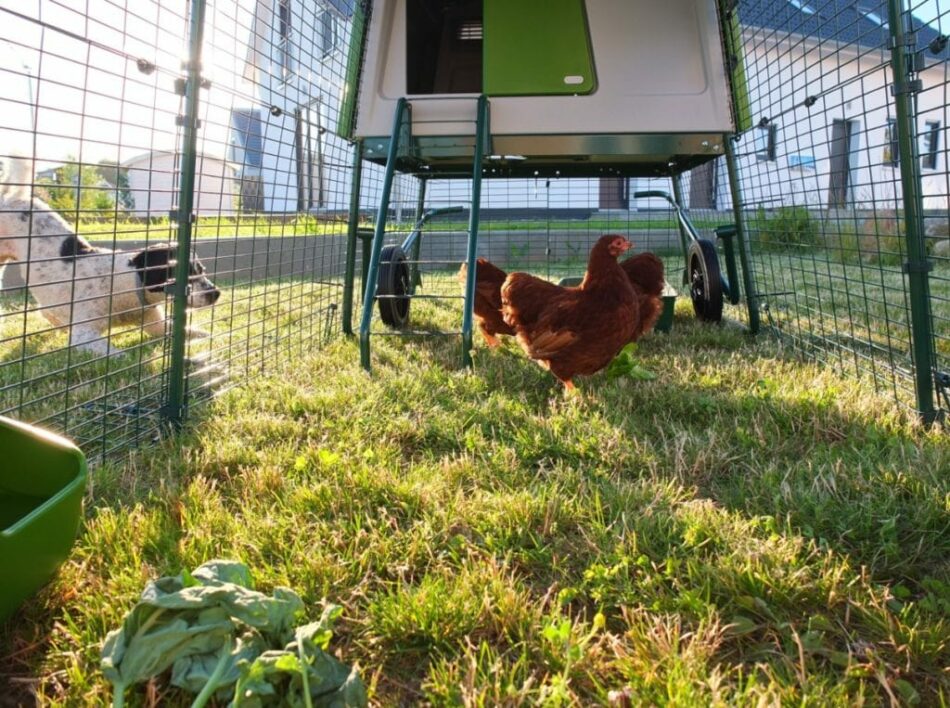
You can keep chickens with other pets when the proper preparations and precautions are in place. Some pets like cats and dogs may have an innate prey drive that chickens can trigger, so it’s important to take introductions slowly to ensure success. With these tips, you’ll be able to confidently introduce your current pets to your chickens, or introduce new pets to your existing flock with confidence.
Keeping chickens with dogs
Dogs are the most common pets in the world, with millions kept as pets across the country. So, if you’re among the many dog owners, adding chickens to your family is possible once you consider your dog’s temperament and trainability.
Assessing your dog
If you’re a dog owner, the first thing to consider is their temperament. Different dog breeds may also react differently to birds as part of their nature. For example, breeds like Labrador Retrievers or German Shorthair Pointers may become easily excited around birds due to their natural hunting and retrieving drives. Other breeds that may have increased prey drives include:
- Beagles
- Sighthounds like Greyhounds or Borzois
- Dachshunds
Regardless of their breed, if your dog becomes excited or overly curious around small animals, their behaviour will likely carry over to chickens. If your dog loses their mind over the birds at your backyard feeder, or drags you to investigate the park ducks on your evening walks, they’ll likely stress out your flock – and themselves.
Dogs without a prey drive or with little interest in birds will likely not pose a problem to your chickens, but all dogs react differently when new pets enter their territory. Usually, most dogs will adjust to the new backyard occupants just fine after an acclimation period. You will likely see your dog expressing interest in your chickens at first – hanging around and sniffing the coop. They may even express a desire to interact with your chickens through playful postures and behaviours. Understanding your dog’s body language around your chickens will help you determine what their relationship will be like.
Chickens are prey animals, and can be hurt easily. Dogs cannot play with chickens as they would with other dogs or even other pets. It’s important to teach your pup that chickens are fragile friends – not toys or something to hunt.
Teaching dogs to get along with chickens
Unless leashed walks make your dog overly excited, their first encounter with your chickens should be done with a dog collar and lead. Make sure their collar is tight enough that they don’t slip out, but not so tight that it’s uncomfortable. Walk your dog up to your chickens’ enclosure and let them sniff. Maintain a tight leash until you see your dog’s reaction, and allow the lead more slack slowly to reinforce good behaviour.
Let your dog watch you spend time with your chickens. This should be done with your chickens in the safety of a strong walk in chicken run. If your dog does more than sniff or hang around the run, take a step back and approach their interaction from a different angle.
It could take several weeks for your dog to fully accept your chickens. Some other ways to help your dogs adjust to your chickens include:
- Setting up chicken fencing around the outside of your flock’s run for your dog to observe them at a distance.
- If your dog has a run or playpen, place it next to your chickens’ run and slowly decrease the distance over several days until they are side-by-side.
- Reward your dog with their favourite treats each time they are calm around your chickens.
Make sure to never leave your dog unattended with your chickens – especially in the beginning. Even if they can’t get into the run with them, an excited dog’s barking can easily stress your flock out.
Keeping chickens with cats
Cats are more difficult to train than their canine counterparts, and are decidedly less predictable in their behaviour. But the good news is that most cats don’t see a large hen as potential prey the same way a dog might. Most cat owners will agree that their cats show little to no interest in their chickens. In fact, cats and chickens have a somewhat symbiotic relationship.
Birds and their feed attract rodents, which a cat would much prefer over your hens. So, when your cat is able to patrol your chickens’ surroundings, chances are good that any potential rodent problem will be nipped in the bud.
Some cats may show increased interest in your hens. This largely depends on your cat’s breed and temperament. Cats will pose a greater threat to chicks rather than grown hens, but by keeping your flock in a strong chicken coop and run, you’ll ensure they stay safe from your cat.
Keeping chickens with guinea pigs
It may be tempting to keep some cute cavies in with your chickens, but in reality it’s not wise. Chickens will likely pick on them, and with their short legs, guinea pigs can’t get away from them quickly. Their dietary requirements are also very different, and your chickens may eat your guinea pigs’ food in favor of their own, which means neither animal will be getting the nutrients they need. If you have cavies and want to house them near your chickens, it’s best for them to have their own guinea pig hutch and run.
Keeping chickens with rabbits
Rabbits on the other hand are fast enough to fend for themselves against chickens, and if raised together from a young age, can do well around chickens. Still, they require their own dietary needs and clean sleeping quarters. They don’t roost like chickens, so they’ll need their own burrowing space in the run or under the coop.
The easiest way to achieve this is by adding walk in chicken run partitions. This will allow you to create “rooms” for each species to ensure they all get what they need. You can open the partition doors to allow everyone to be together whenever you’d like, or create a third space as a common area.
Remember to try to give each species as much space as possible in their respective areas to make them feel safe and comfortable.
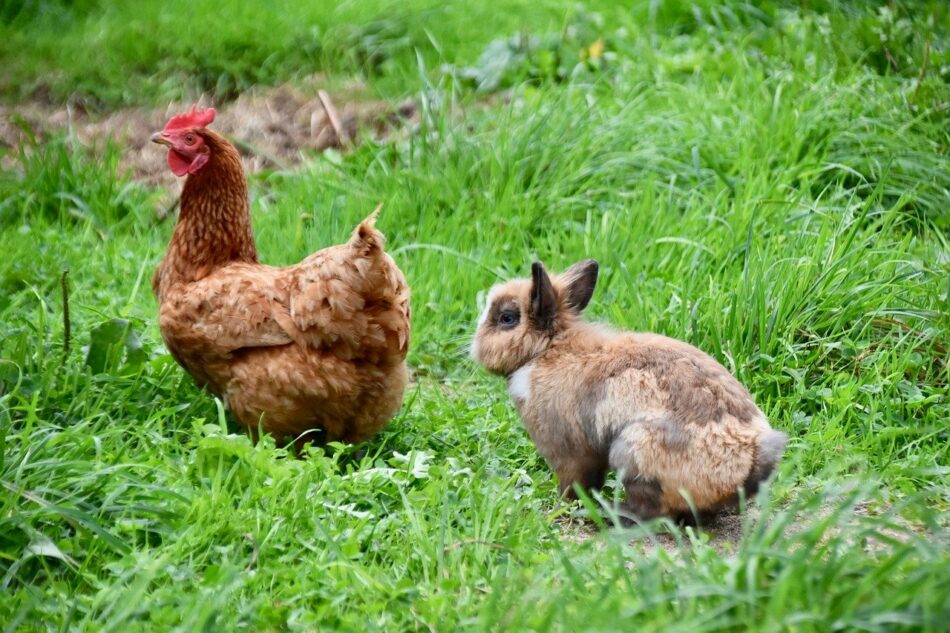
Chickens and other pets
Chickens can also mix happily with goats, and with female ducks (males will tends to bully them). Ironically, they do not mix with birds in an aviary. They will eat anything that falls to the aviary floor, but they will also happily peck the other birds whenever they can and may attract rats and mice, which will cause problems for the smaller birds.
If you live in a rural setting, you can keep chickens with other barnyard animals. Chickens mix happily with:
- Goats
- Sheep
- Cows
- Alpacas or llamas
- Pigs
- Female ducks, guinea fowl, peacocks, geese, or pheasants
Any other avian species kept with chickens should be docile and preferably female, as males can bully hens. Smaller birds like quail or pigeons will likely get pecked at by chickens, so it’s best to stick with larger birds as run-mates. Small pets like hamsters, gerbils, turtles, or frogs should never be kept with chickens – they will be pecked at and killed.
Omlet and your pets
Omlet has all of the pet products you need to keep your furry and feathered family members healthy and happy. Having multiple types of pets is exciting, and through our line of chicken coops, chicken runs, and walk in run partitions, you’ll be able to create a safe haven for all of your animals to enjoy. And, by knowing that Omlet products are protecting your flock, you can rest easy knowing that you’ve provided them with the best chicken housing solutions available.
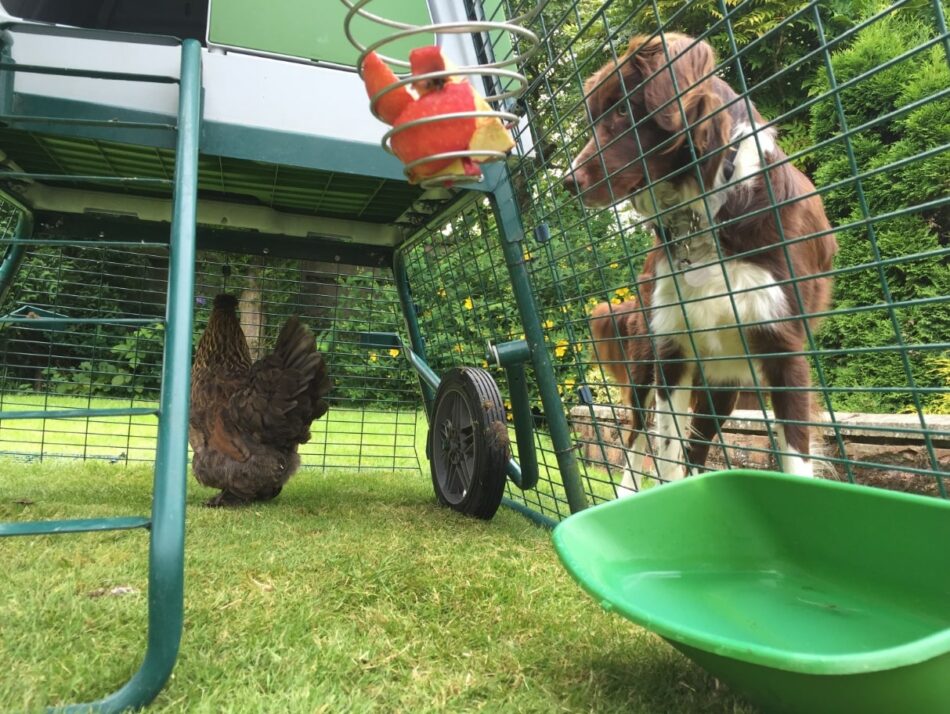
This entry was posted in Budgies

This article is a part of our Pride of Omlet series, a collection of amazing stories which shine the spotlight on extraordinary pets and share their selflessness, bravery, talent and compassion with the world.
-Written by Anneliese Paul
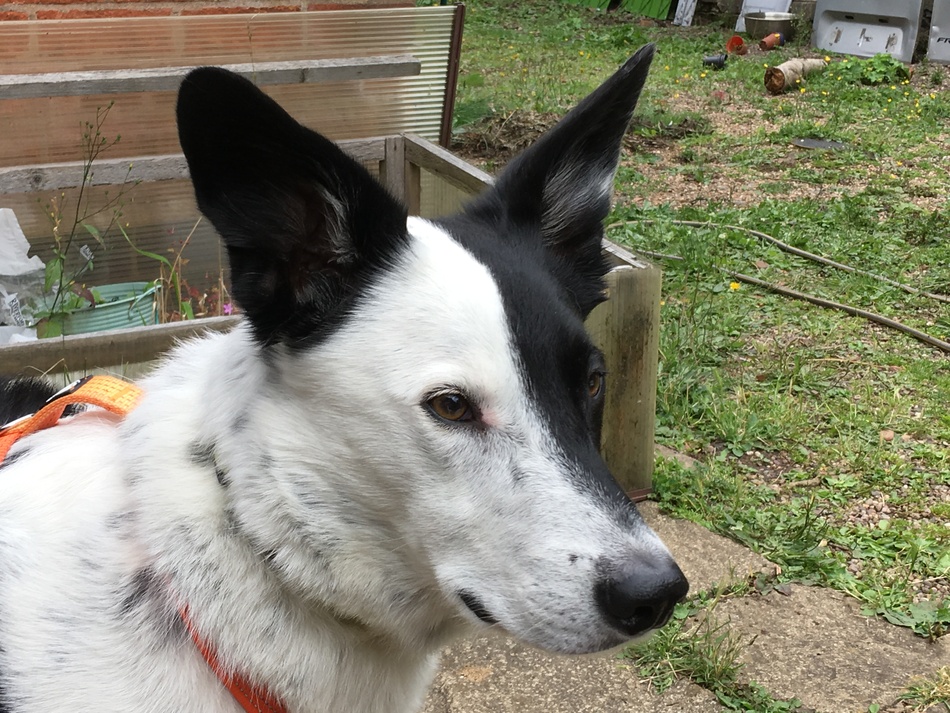
On paper, Kipper wasn’t exactly what Angela wanted. After years of behavioural challenges, he’s become the best-behaved blood donor and saved over forty dog’s lives. Kipper’s turned out to be Angela’s perfect match.
When Angela’s house was burgled, the first thing the police said was, “Get a dog.” Because a dog barks, and people are less likely to enter your home uninvited. But working as a teacher, Angela felt she couldn’t look after a dog, especially not an active breed like a collie.
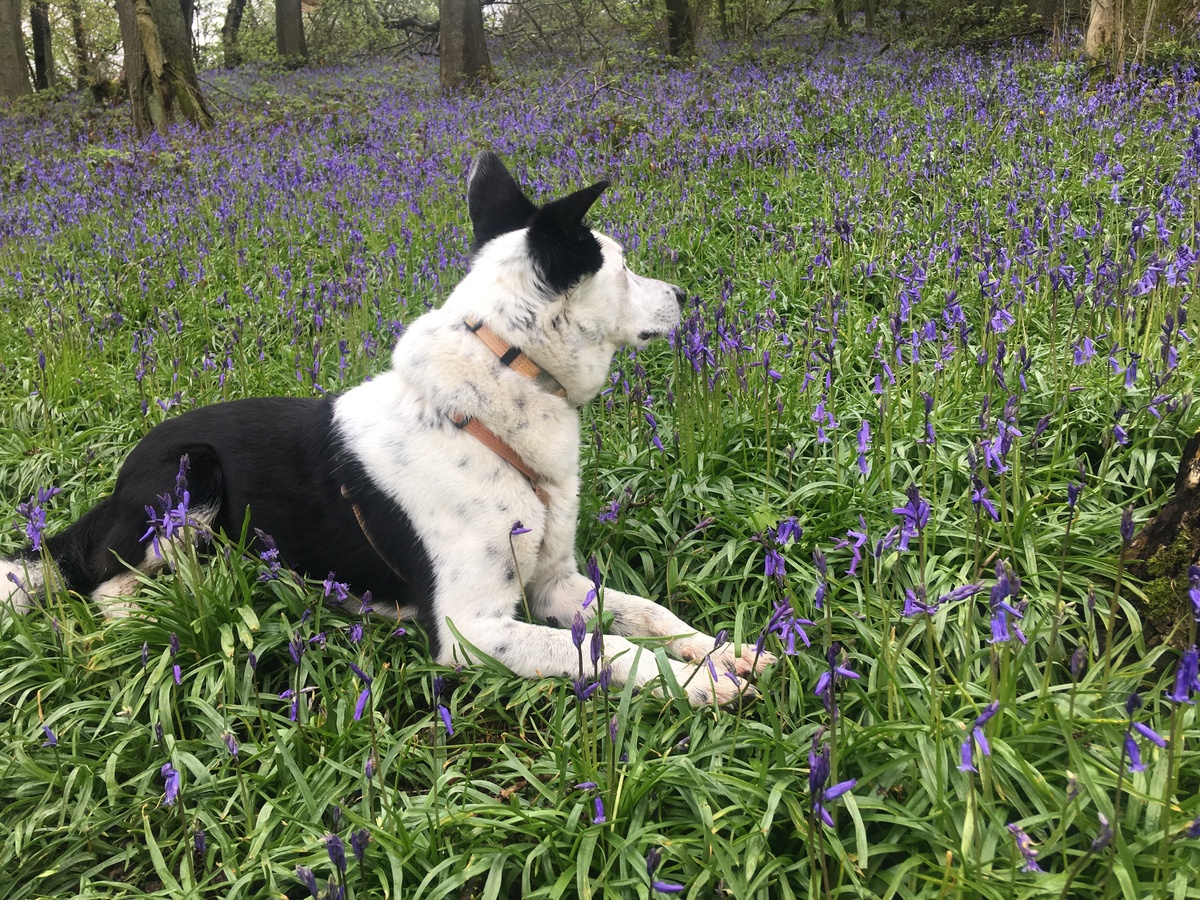
With fond memories of the collie she grew up with, she spent a long time talking to the Border Collie Trust, and they helped her find Kipper. He was an eighteen-month-old Irish stray and had been rehoused multiple times. Being a collie, Kipper had a lot of energy. On paper, he didn’t look right for Angela.
But the Border Collie Trust thought he was the perfect match and persuaded her to meet him. So, she went to the rescue centre to get to know him. Angela could tell he was fantastic with humans, which was really important. So she took him for a walk and fell in love with him. A few weeks later, she brought him home to start their new adventure.
Angela had prepared a lovely kennel and run in the garden for Kipper to spend half the day in. The plan was at lunchtime; he would be walked by a professional dog walker and then left in the house in the afternoon until she got home from school.
Kipper turned out to be hard work, boisterous and disruptive. He destroyed the house and was what Angela describes as ‘over the top’. In the evening, after a long day at work, Angela would go to tie up her shoes for a walk, and he would bite her hair, not in an aggressive way, just incredibly overexcited. It used to take them twenty minutes just to get to the front gate. It was exhausting.
But Angela had experience with Border Collies, she knew he had incredible intelligence, and he just needed things to do. Her teaching instincts kicked in, and with support from the Border Collie Trust, she began what would turn out to be life-changing behaviour training for both her and Kipper.
At first, it was simply stopping and waiting for him to calm down whenever he did something that was ‘over the top’. Then Angela needed to tackle the chewing at home. She started by leaving him for five minutes, going to the front gate, standing across the road, then coming back in and praising him for being good. Angela worked out Kipper’s motivations (toys and food) so that she could effectively train him.
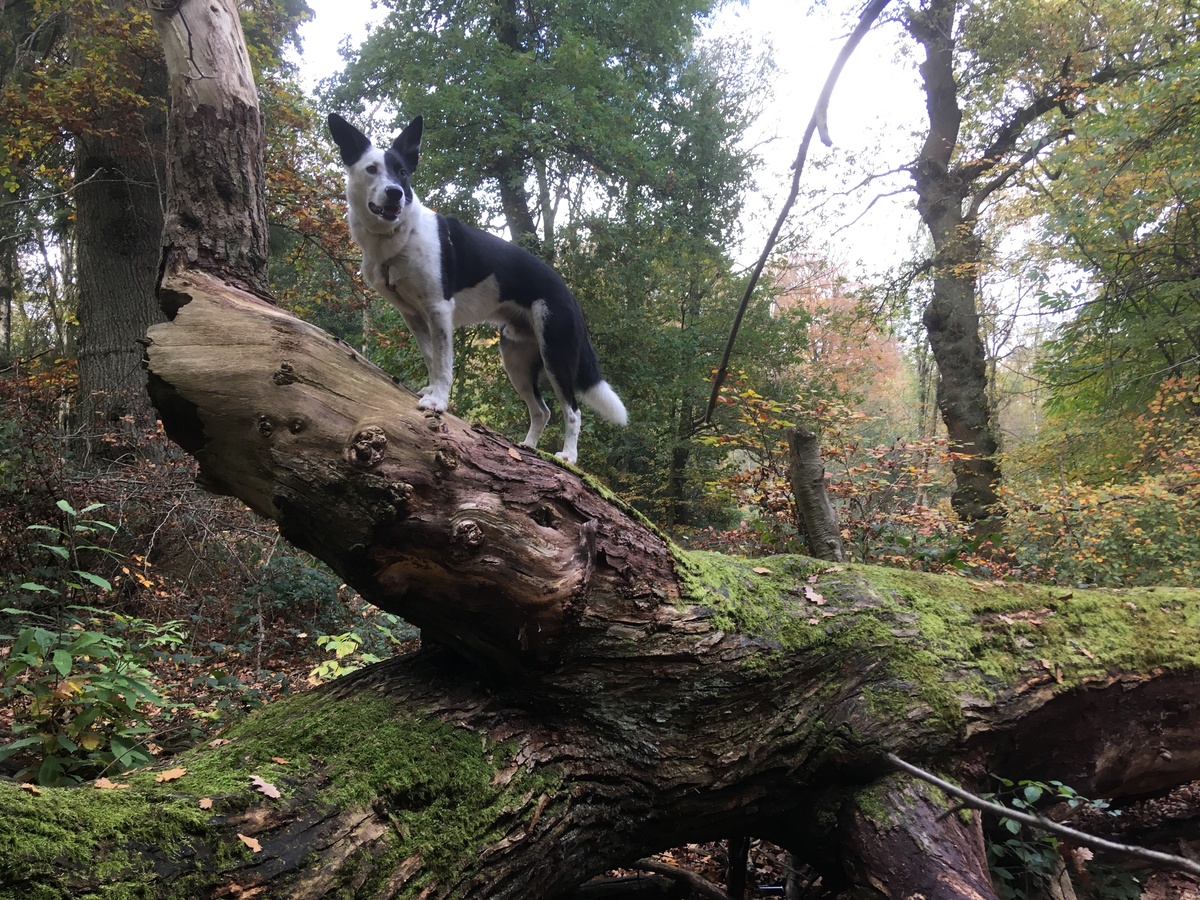
“He is so clever,” says Angela “, That he will work out. What am I being asked to do? What is the reward on offer, and is it worth it? And if it isn’t worth it, he won’t do it.”
Over time he made progress, and his behaviour slowly improved. Angela worked hard with him, and as his obedience improved, their bond grew, so did the trust between them.
Kipper lives on the edge of the countryside and occasionally chases livestock, so he has to wear a muzzle on long walks. But incredibly, Angela can leave him alone, unmuzzled with the chickens in her garden. His behaviour at home has transformed so dramatically that Angela is confident Kipper will do whatever she asks him to. Angela has even watched a big bolshy chicken trying to steal Kipper’s bone!
“The chicken was getting closer and closer and closer, trying to peck at his bone. All Kipper did was pick up the bone and walk away.”
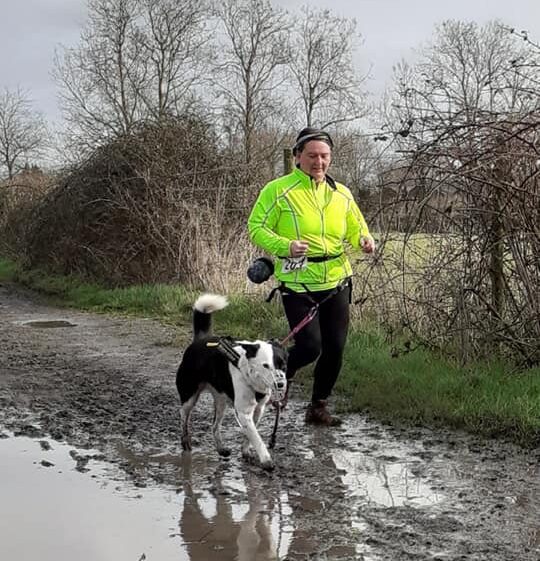
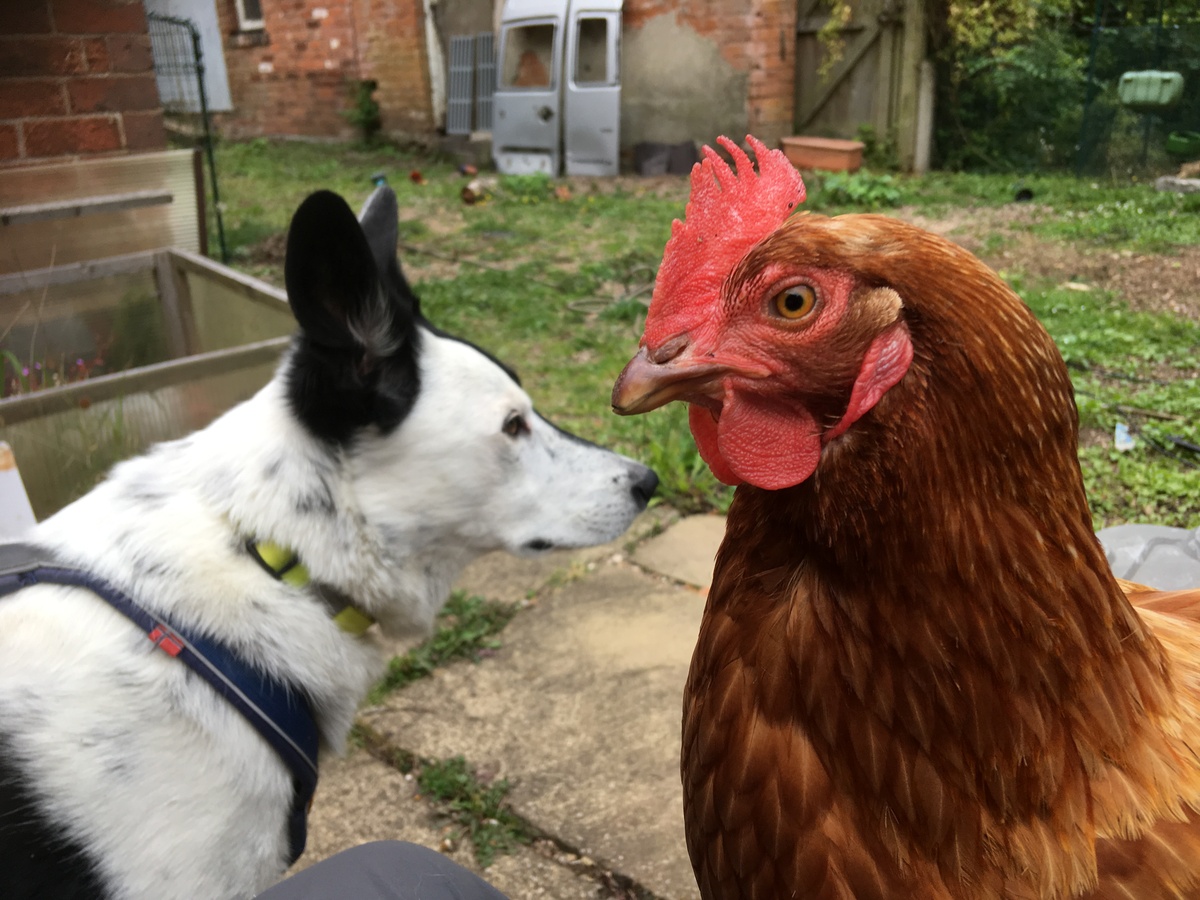
With good obedience at home, they started to have fun together. Kipper achieved Gold in the Kennel Club Good Citizen Dog Scheme and got to the Kennel Club Starters Cup Final in 2017, an agility competition for beginners. The activity and the mental work was fantastic for him, and they both made new friends, travelled to new places and shared memorable experiences.
But when Kipper had to have his dew claws removed, he couldn’t do his agility work, and the lack of exercise led to frustration. Angela, always on the lookout for ways to develop Kipper’s potential, discovered CaniCross. Cani sports are a whole range of sports to nurture the bond between dogs and their owners and are particularly beneficial for dogs with behavioural issues.
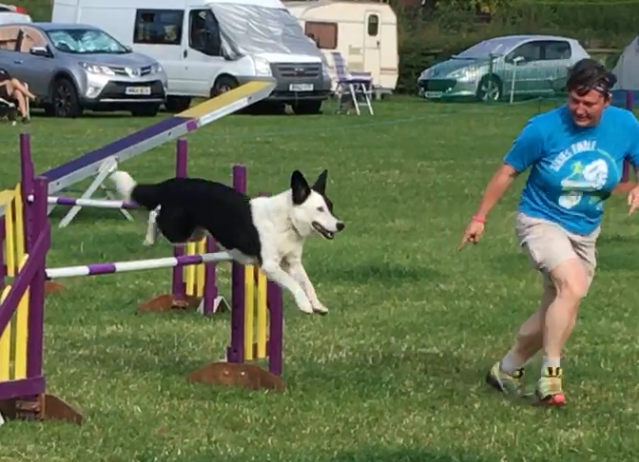
Taking part in cross country runs and triathlons, Angela and Kipper were getting fit together and making strong friendships with a whole community of like-minded dog lovers.
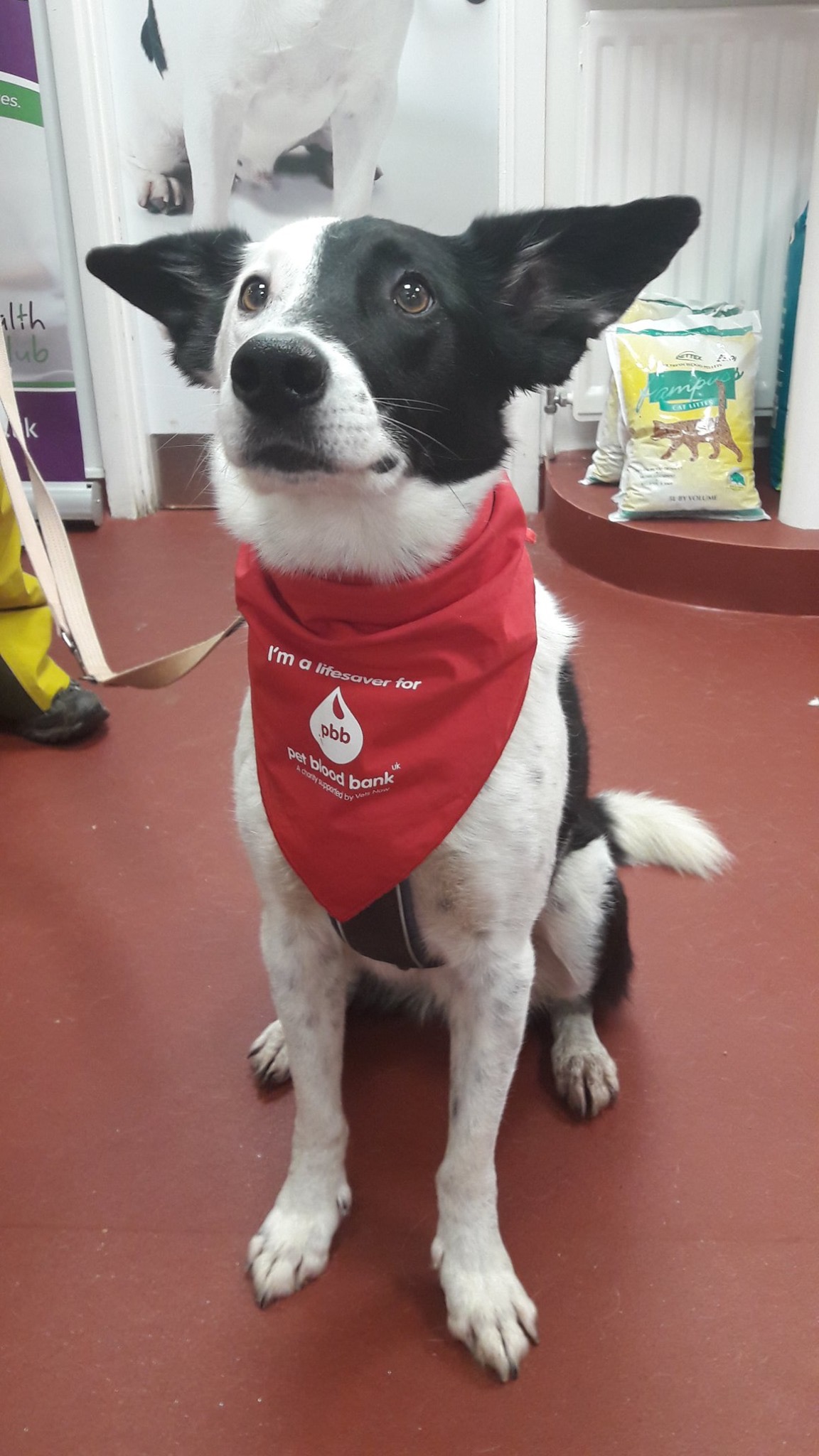
One of their friends introduced them to the pet blood bank. Angela was keen to give back to the dog community, but he was under the 25kg minimum weight. However, as he matured, his muscle development changed. As soon as he’d gained enough weight, Angela registered Kipper as a donor and proudly took him along to his first session.
But Kipper was terrified. He had to have a little piece of fur shaved and couldn’t stand the sound of the clippers. Once again, Angela turned to training. The blood bank advised using an electric toothbrush to get him used to the vibrating sound. Over time, using his favourite soft cheese as a treat to reward good behaviour, Angela gently got him used to sound until she was sure he knew it wasn’t going to harm him.
Finally, Kipper was ready to give blood, perfectly behaved. He’s now on his tenth donation, and with a rare negative blood type, his blood is a perfect match for any dog. With every donation providing blood for up to four other dogs survival, Kipper has helped save forty dog’s lives.
Kipper and Angela have experienced so much together. Pushing each other to do better, they’re a winning team. Motivating each other to get on with life and do something good, to make friends together. As Angela says,
“Not every dog would suit me, and not every owner would suit him, but the Border Collie Trust got it right. We were meant to be.”

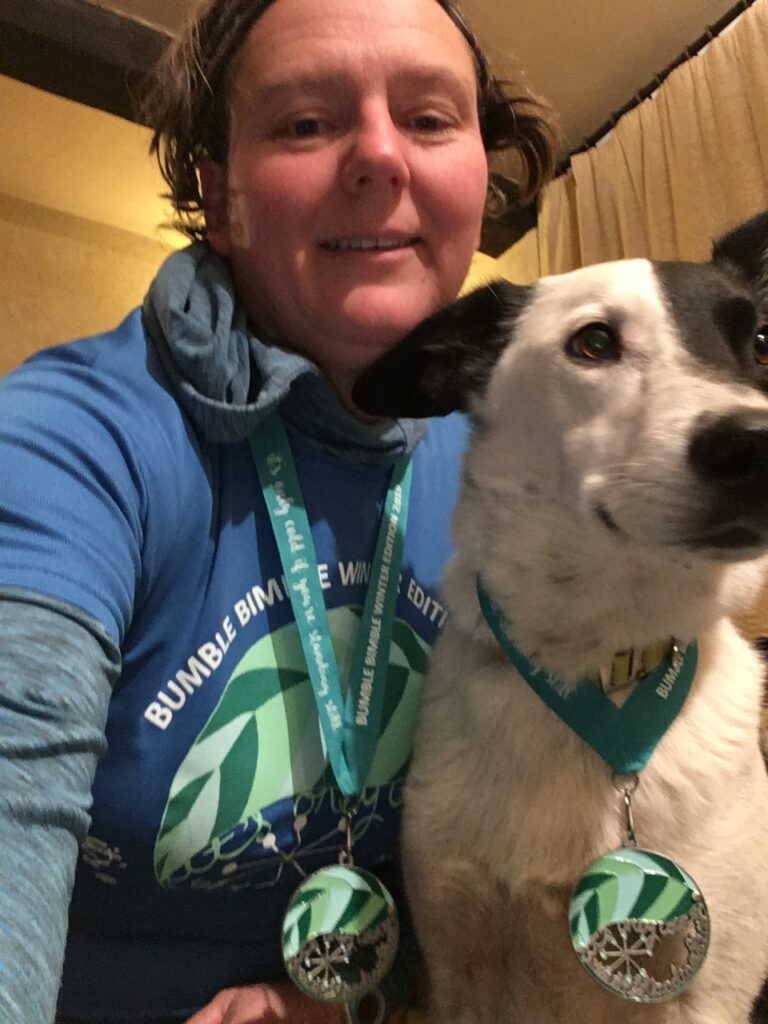
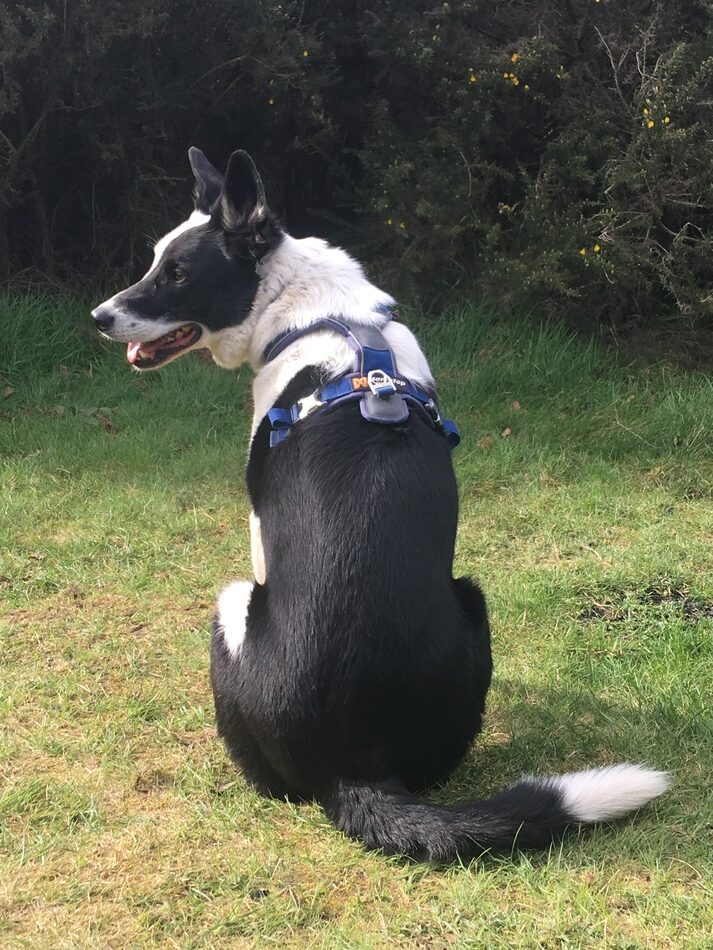
This entry was posted in Dogs
-The Best Things In Life Are Sweet-_________________________________________
The OMLET (Omelette) Cake
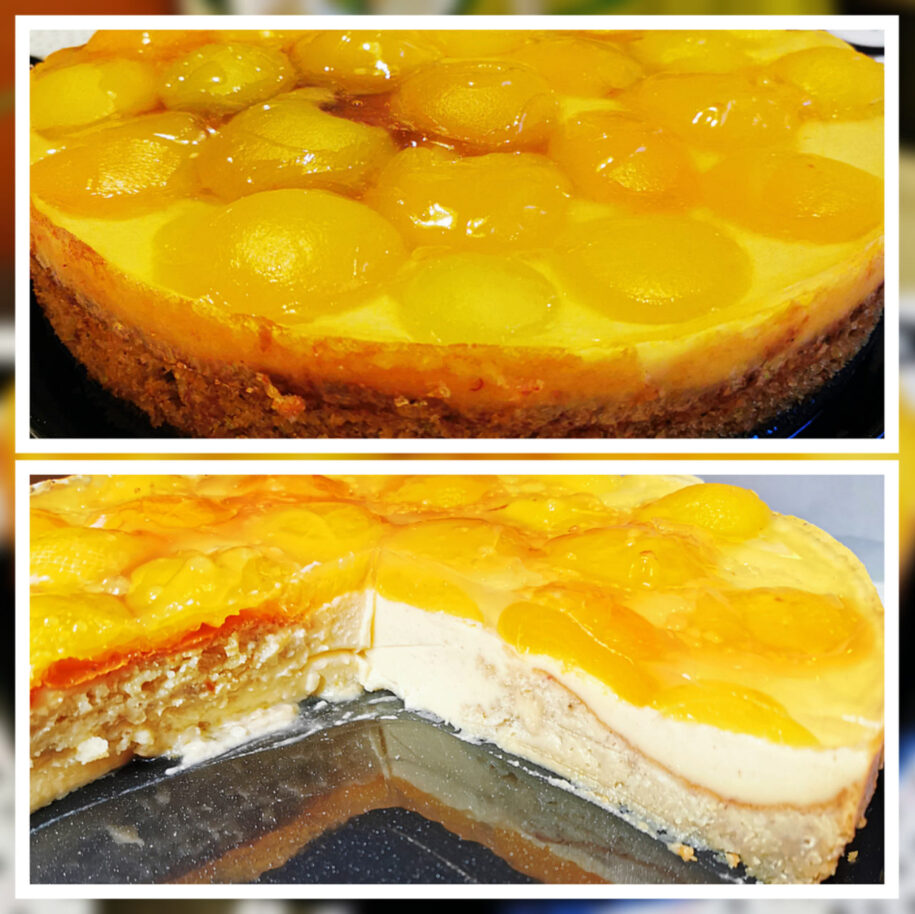 Ingredients for the cake batter (for a ÿ25 cm cake tin):
Ingredients for the cake batter (for a ÿ25 cm cake tin):
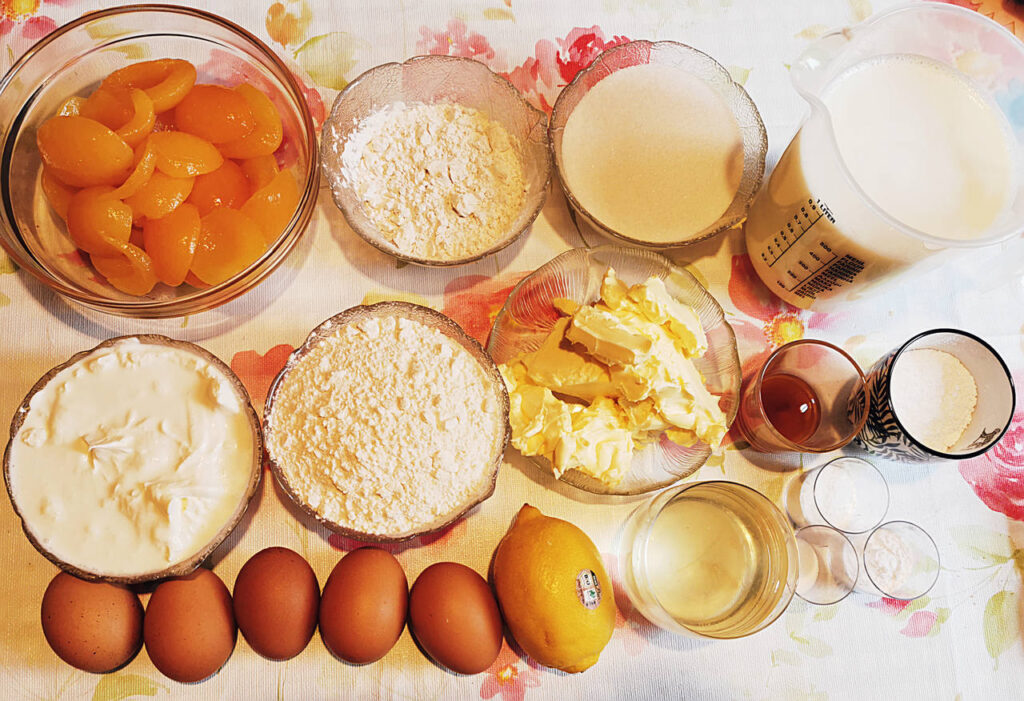
- 900 ml milk*
- 250 g sugar
- 250 g butter/margarine
- 4 tbsp lemon juice
- 5 eggs*
- 250 g flour
- 1 packet baking powder
- a pinch of salt
- 1 package of clear cake glaze*
- 1 can apricots halves (850 g drained net weight)
- 1 can apricots halves (425 g drained net weight)
Ingredients for pudding cream:
- 100 ml milk*
- 2 packets vanilla pudding powder
- 80 sugar
- 1 packet vanilla sugar
- 2 cups sour cream*
*For a plant-based or vegan option:
As a milk substitute you can use any non-dairy milk (e.g. almond or oat milk). As 1 egg substitute use 1/2 mashed banana (5 eggs = 2 ? bananas) or 70 g apple puree (5 eggs = 350 g). You can buy vegan sour cream or soy yogurt. Instead of the clear cake glaze you can use agar-agar powder.
Instructions
- Grease a cake tin (ÿ25 cm). Preheat oven to 170 degrees C/338 degrees F (convection oven).

- Boil 900 ml milk in a saucepan. Mix in a bowl the remaining milk, 80 g sugar and vanilla pudding powder until smooth, stir into the boiling milk and cook well for 1 minute while stirring. Pour into a bowl and let cool, stirring several times.
- Mix butter/margarine, 200 g sugar, 1 pinch of salt with the mixer until you reach a creamy texture. Mix in eggs one at a time. Mix flour and baking powder and stir in 2 tsp of lemon juice. Put the batter in a greased cake tin and bake on the middle shelf for 20 minutes.
- In the meantime, drain the apricots well and collect the juice. Stir the pudding again, and now stir in the sour cream with a whisk. After the 20 minutes baking time, spread the pudding cream evenly on the batter. Cover the cake with apricots and bake for another 20-30 minutes. Let cool down.
- Mix the icing powder, remaining sugar, 1/4 liter of apricot juice and remaining 2 tsp of lemon juice in a saucepan and bring to the boil while stirring. Now spread the glaze with a tablespoon over the apricot halves so that it looks like egg white. Allow to become firm.

You can use peaches instead of apricots as well.
If you want to bake the ultimate “Omlet”-cake with a ÿ12 cm cake tin, use 1/2 of the ingredients and only one apricot halve on top of it.
If you prefer a more traditional Easter cake, here is a super delicious yet easy recipe:
_________________________________________
Carrot-Marzipan-Cake
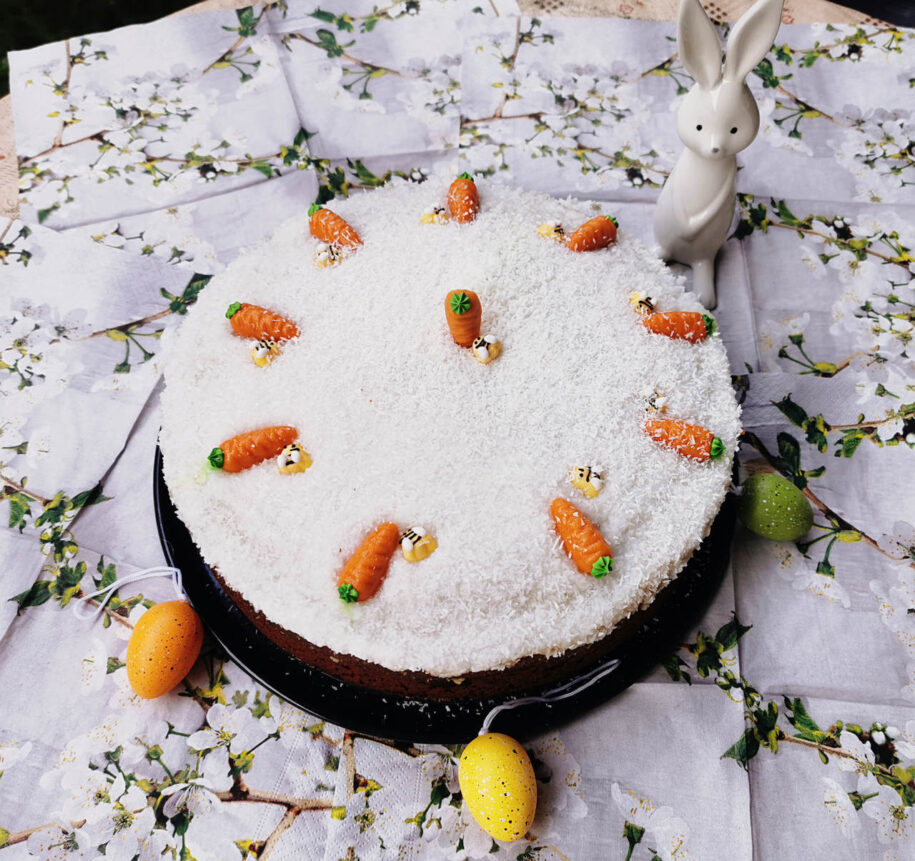
Ingredients for the cake batter:
- 350 g wheat or spelt flour
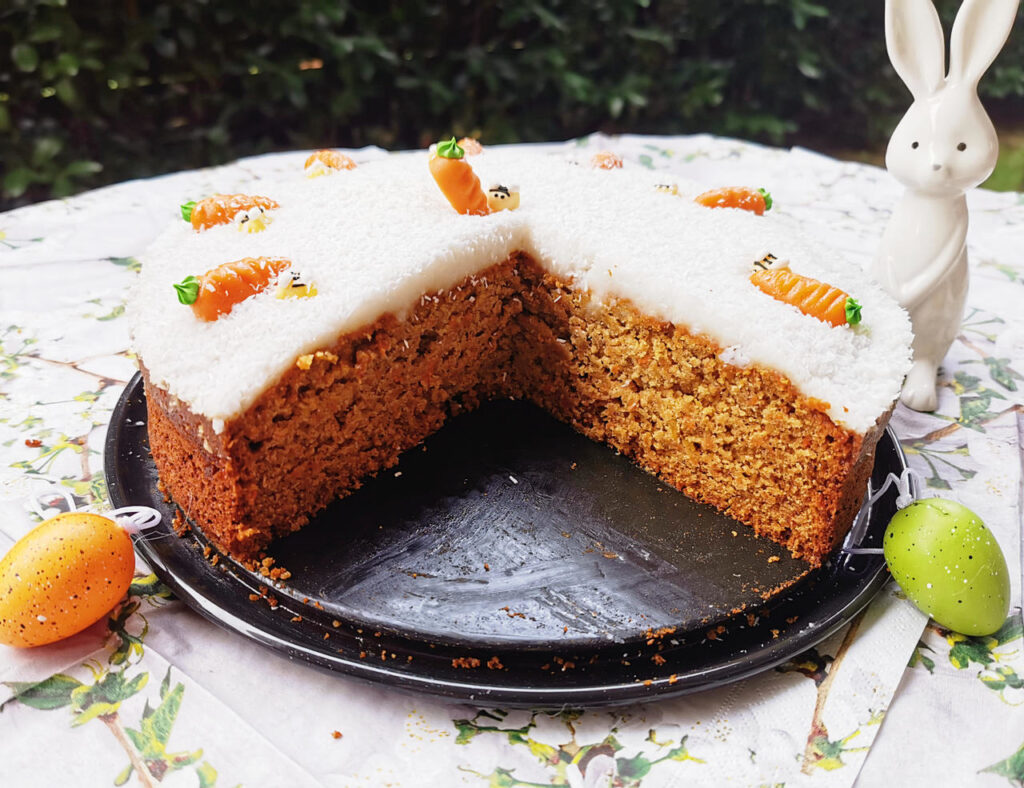
- 4 eggs*
- 400 g carrots
- 100 g ground hazelnuts
- 100 g ground almonds
- 200 g sugar
- 1 packet vanilla sugar
- 1/4 tsp vanilla extract
- 1 vanilla pod
- 1 tsp cinnamon
- 1 packet baking powder
- 1 tsp baking soda
- 200g marzipan
- 200 ml rapeseed or sunflower oil
- 200 ml milk*
- juice of 1/2 lemon
- extra portion love
Optional adult version: 150 ml advocaat
Frosting:
- 70 g icing sugar
- 200 g coconut yogurt
- 30 g coconut paste
- shot of lemon juice
optional: food colouring, e.g. green colour

Decoration: e.g. Marzipan carrots, chopped pistachios, dried flowers, grated coconut
*For a plant-based or vegan option:
Use 2 tsp baking soda and 2 tsp cider vinegar or alternatively banana/apple puree as egg substitute (1/2 mashed banana per egg; 70 g apple puree per egg).
As a milk substitute you can use e.g. almond milk or oat milk, or any other non-dairy milk you prefer.
Instructions
1. Grease a cake tin (about ÿ25 cm) or use baking paper. Preheat oven to 175 degrees C/347 degrees F (convection oven).
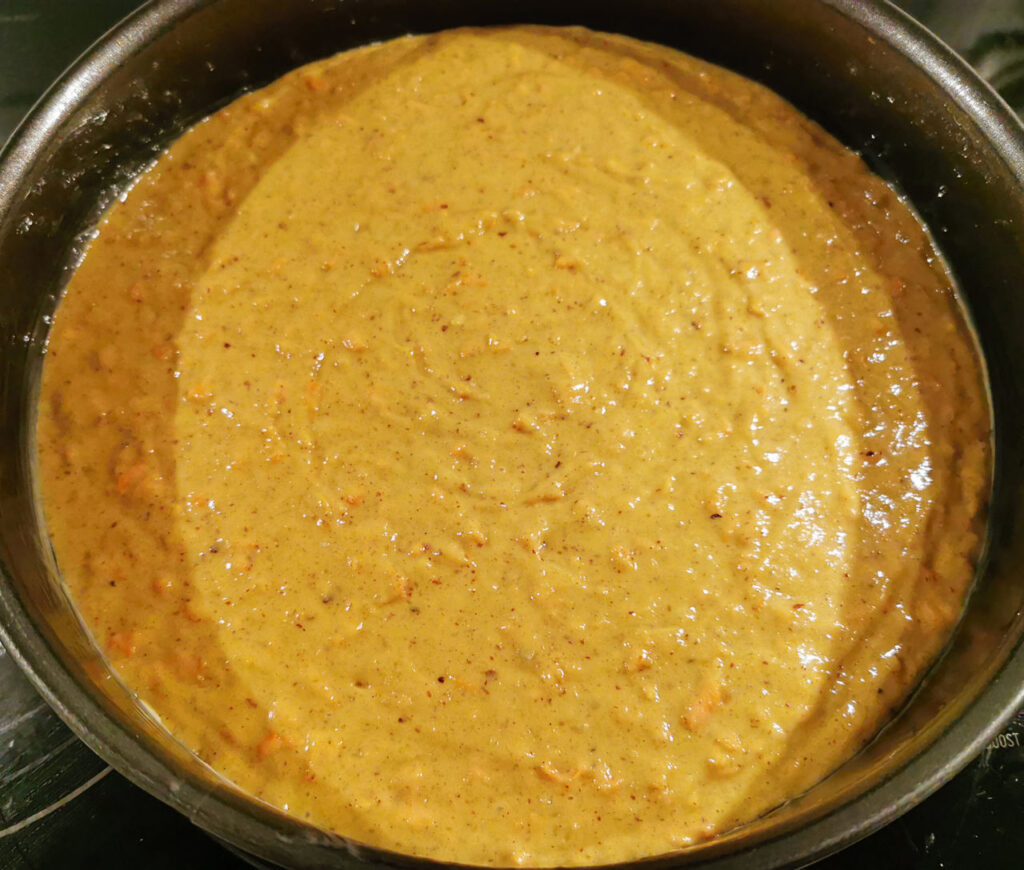
2. Mix dry ingredients (flour, hazelnuts/almonds, sugar, baking powder, baking soda, cinnamon) and the eggs in a bowl with a mixer. In a separate bowl, peel and grate carrots and mix them with the wet ingredients (vanilla extract, oil, milk, lemon juice).
3. Now slowly heat the marzipan in a saucepan, stirring repeatedly until it becomes a liquid mass. Mix the dry and wet ingredients together and gradually add the marzipan (and optional advocaat) to the batter, mix well.
4. Pour the batter into the cake tin, smoothen it and bake it for about 50 minutes (skewer test).
5. Let the cake cool down and prepare the frosting in the meantime. Mix the sifted icing sugar with yoghurt and coconut puree and season with more icing sugar and a shot of lemon juice. You can add food colouring to the frosting if you wish. Now spread the frosting on the cooled cake and decorate as desired, e.g. with marzipan carrots, chopped pistachios or dried flowers.
Enjoy!
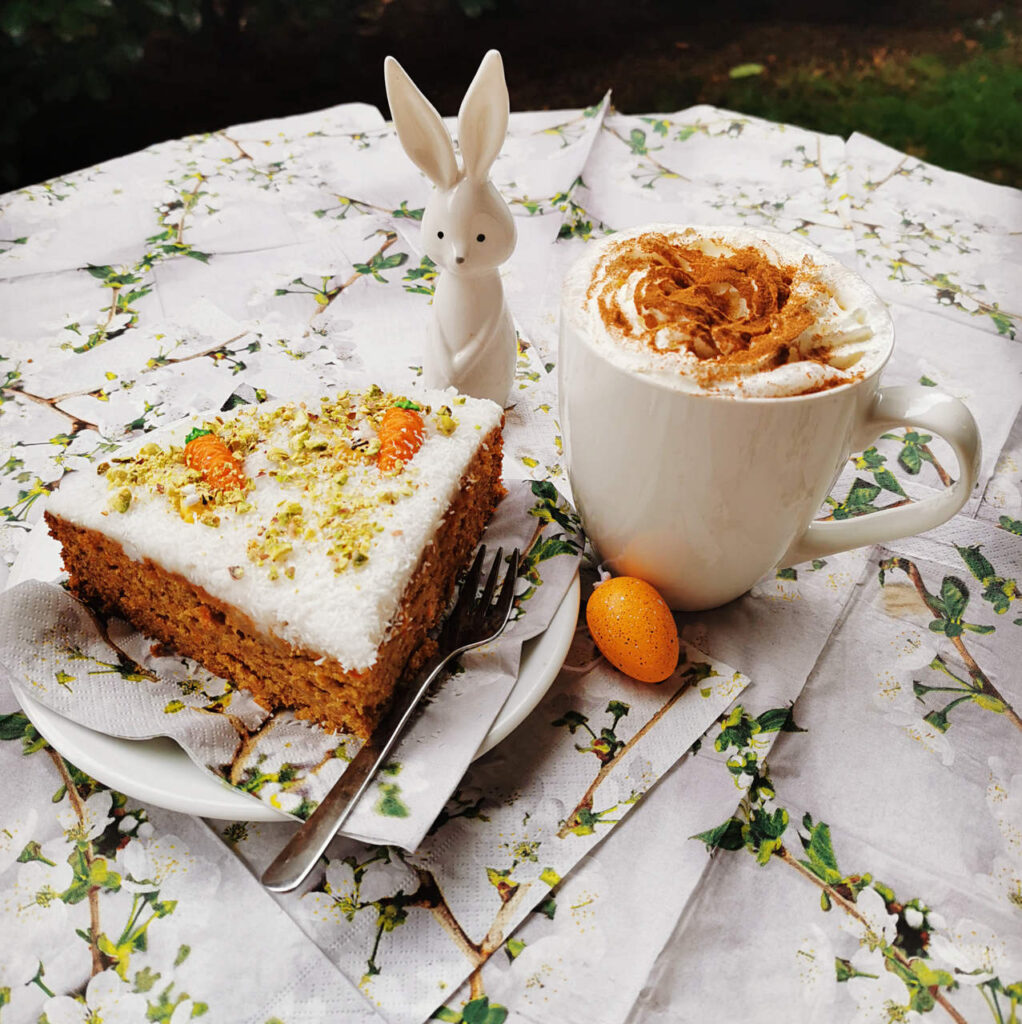
Bon appÈtit
&
Happy Easter from the Omlet Team!
Tag us on social media (Instagram: omlet_uk) with an image of your cake!
This entry was posted in Food
Teaching your dog tricks is not that difficult. Your pet is very intelligent and in fact, training a dog is much easier than training other animals! We know that sometimes it’s hard to find inspiration and ideas, so we’ve put together a list of 5 must-do tricks to teach your dog!
Dogs are very attentive to their environment, they are able to learn several commands and quickly assimilate what you tell them. However, you will need to be patient and rely on rewards and encouragement to get results. Never spend more than 10 minutes on an exercise per day and make sure you are in a good mood to praise your dog. Frustration must be put aside or your dog will feel it and may perform less well.
Do you know that the tricks and exercises taught to your dog will stimulate him physically and mentally? They also allow you to enrich the bonds that unite you.
This list is far from exhaustive and we assume that your dog already knows “sit”, “down” and “stay”.
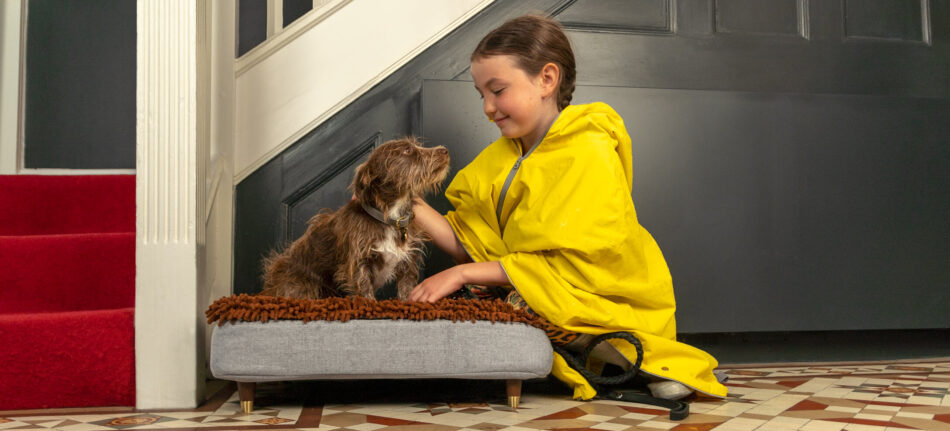
1- Pawing or shaking hands
As you may have noticed, dogs sometimes instantly raise their paws when they ask for food. So this trick is not fundamentally complicated to teach your dog. You just have to find the right word, the right signal to give your dog to obey.
Omlet’s tip: Keep the treat in your hand, show the treat to your dog and tell him to wait. Slowly lower your hand and when your dog lifts his paw, make the sound you want to associate with the command. “Shake”/”Paw” is an easy sound for your pet to remember, so use short words. Add emphasis to the word and enthusiasm. Once the dog has the treat in his mouth, congratulate him with a pat.
Gradually, you won’t need to lower your hand too much. Each time you repeat this command, make sure you raise your hand a little higher so that your dog’s paw is raised to chest level. Repeat with the same paw.
Once your dog has mastered this command, you can train him to lift the second paw. However, the sound/word should be different from the previous one. Use the word “other” for example.
Afterwards, you can easily teach him the “high five” command. You will have to show him your palm and encourage your dog to go even higher with his paw. Once your dog does this, reward him.
2- Rolling over
This is a trick that many owners want to teach their dog, but many don’t know how.
Omlet’s tip: First, you get your dog to “lie down”. Place a treat in your hand and let your dog smell the treat without giving it to him. The goal during this exercise is that your dog should not get up. If it does, don’t get upset and try again.
Use your hand to guide your dog. You must make the movement and the trajectory that you want your pet to follow. Use your hand to turn your dog’s head and make a backward movement. As your dog tries to turn his head to grab the treat, he will end up rolling. Repeat the exercise several times, but don’t spend more than 15 minutes doing it. You can come back to the exercise later in the day.
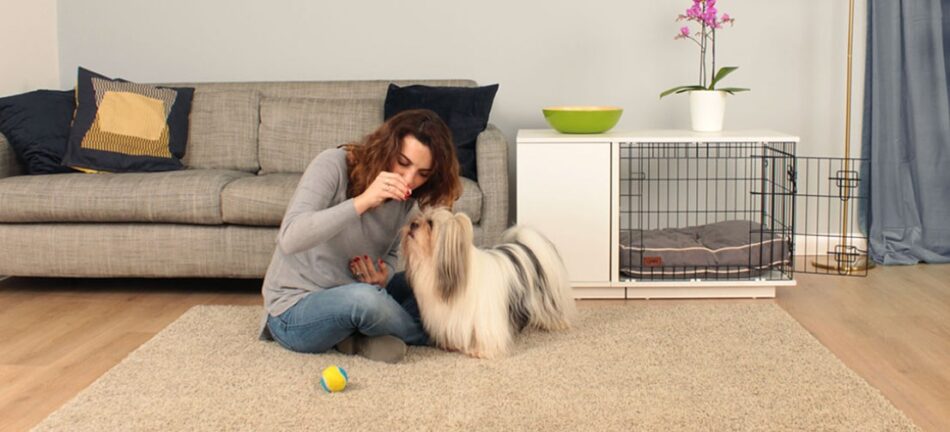
3- Speak
This command can be easy to learn for expressive dogs but a little more complicated for calm dogs.
Omlet’s tip: Excite your dog a little with your voice. Ask him to sit and put a treat in your hand. Wave your hand but don’t give him the treat. Repeat the word/command you want him to learn several times, perhaps “bark” or “speak”. Wait for him to bark or whine. After a few seconds give him the treat and praise him. If you want your dog to calm down, repeat the word “quiet” or “enough” and walk away.
Never encourage or praise your dog when he barks out the window or at people. Barking can be frightening to some people.
4- Dance
Good news, your dog can also learn to dance! Maybe he can even dance better than you…
However, this trick is easier to learn for small dogs. Larger dogs have a harder time standing on their two hind legs. This trick is also not recommended for dogs with back problems.
Omlet’s Tip: Ask your dog to sit. Put a treat in your hand and put your hand over your dog’s muzzle slightly backwards. Your goal is to get your dog to sit on his hind two legs, and he will only do so if he sees no other way to get his treat. Once both front legs are up, praise and encourage your dog. Repeat this trick several times until he can quickly stand on both paws.
Once he does, you can move on to the next step. When your dog is on his two feet, hold the treat and move your hand in a small circle over his head. After a few seconds your dog should be able to twirl or at least move both paws on the ground. As you do the movement, remember to say the word you want to associate with the command. In this case that word could be “dance”. Once your dog has taken several small steps, give him the treat and praise him.
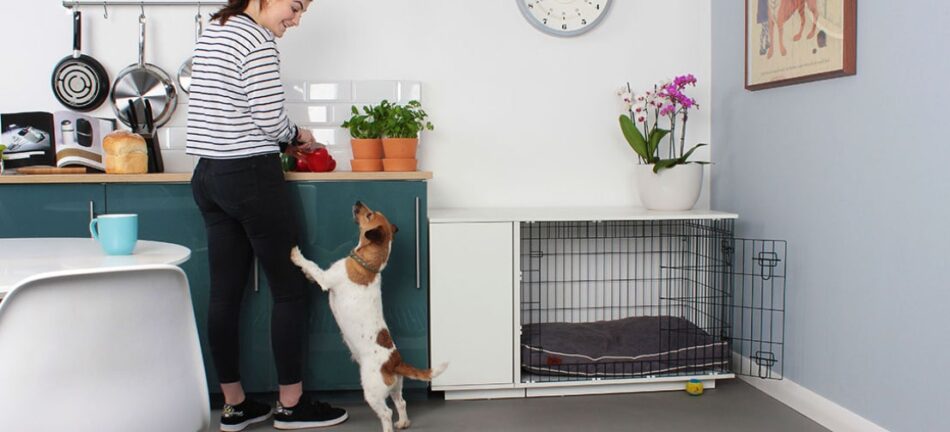
5- Playing dead
This is a challenging trick! It’s a great way to impress those around you, although it is not so easy to teach your dog, especially if he tends to be dynamic. However, nothing is impossible, you will just need more patience.
Omlet’s tip: As with the “roll over” command, have your pet lie down. Take a treat in your hand and put it over his head. Once your dog turns around, stop the process by asking your dog to stop moving. Repeat this process several times until your dog understands that it should not move. It is very important to say the word you want to associate with the command. For this trick it could be “Bang”.
This trick is not easy to describe, a video is sometimes worth a thousand words. We advise you to watch this video to teach your dog to play dead.
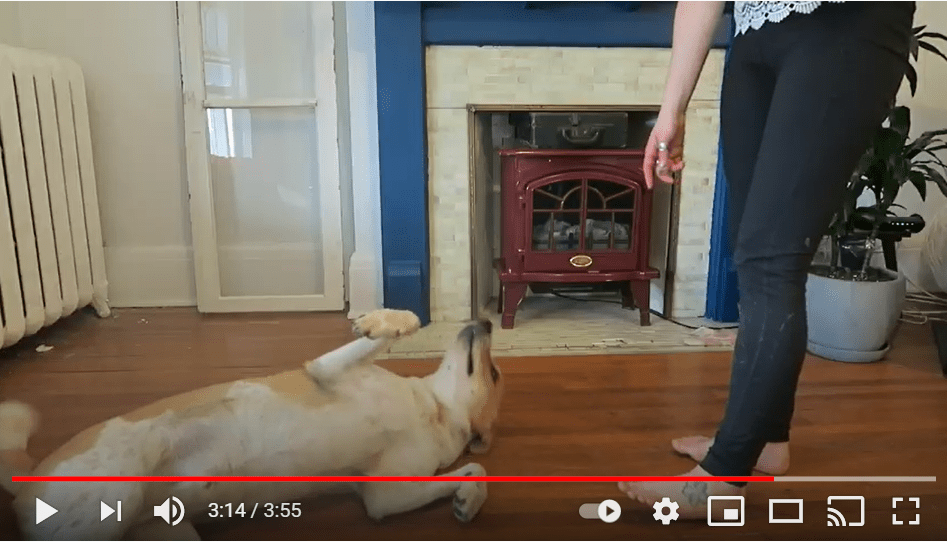
No matter what tricks you teach your dog, patience is the key and the only way to succeed and achieve your goals. Never forget to congratulate and encourage your pet. Finally, never force him. If he doesn’t want to learn a command or doesn’t understand it, don’t be obstinate. If you are afraid of doing the wrong thing, many resources are available on Youtube. Don’t hesitate to watch several videos to find the best technique for your dog.
Tag us on social media if you manage to do one of these tricks with your dog. We would love to share your pet’s achievements.
Tag us on Instagram omlet.au or send us your video to the following address: blog@omlet.com.au
This entry was posted in Dogs

This article is a part of our Pride of Omlet series, a collection of amazing stories which shine the spotlight on extraordinary pets and share their selflessness, bravery, talent and compassion with the world.
-Written by Anneliese Paul
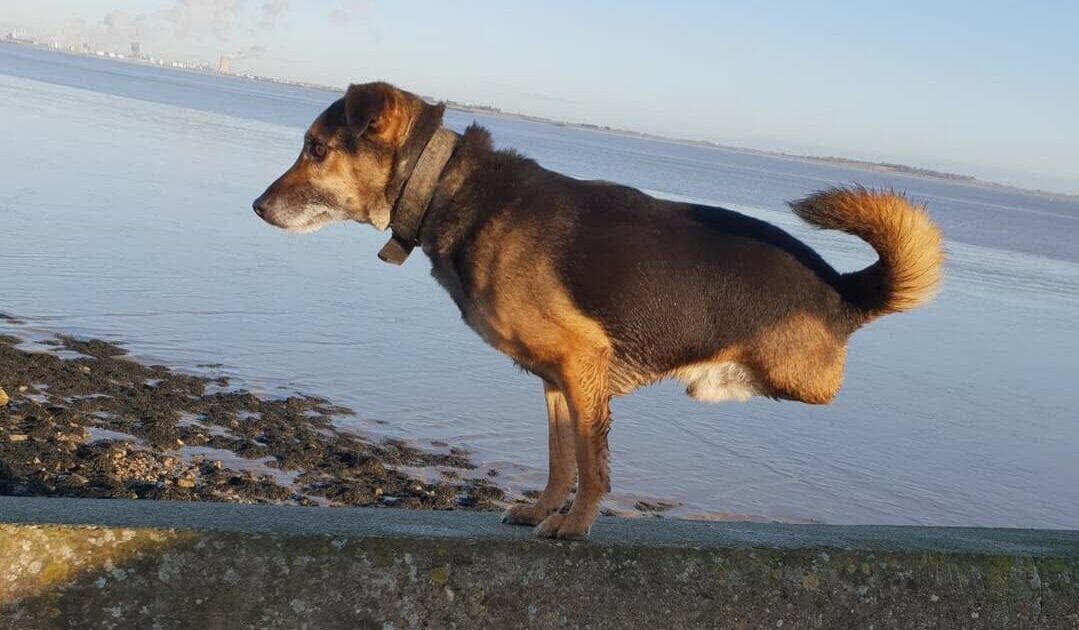
Jerry’s a cheeky, playful and boisterous rescue dog from Romania who can do a handstand! He landed on his feet when Shena gave him a home and inspired her to start a rescue centre specialising in disabled animals.
When you see a dog with two legs, what do you think? Many people would give up on them. On her first visit to the vet, Shena was advised to put Jerry to sleep. But Shena’s couldn’t do that.
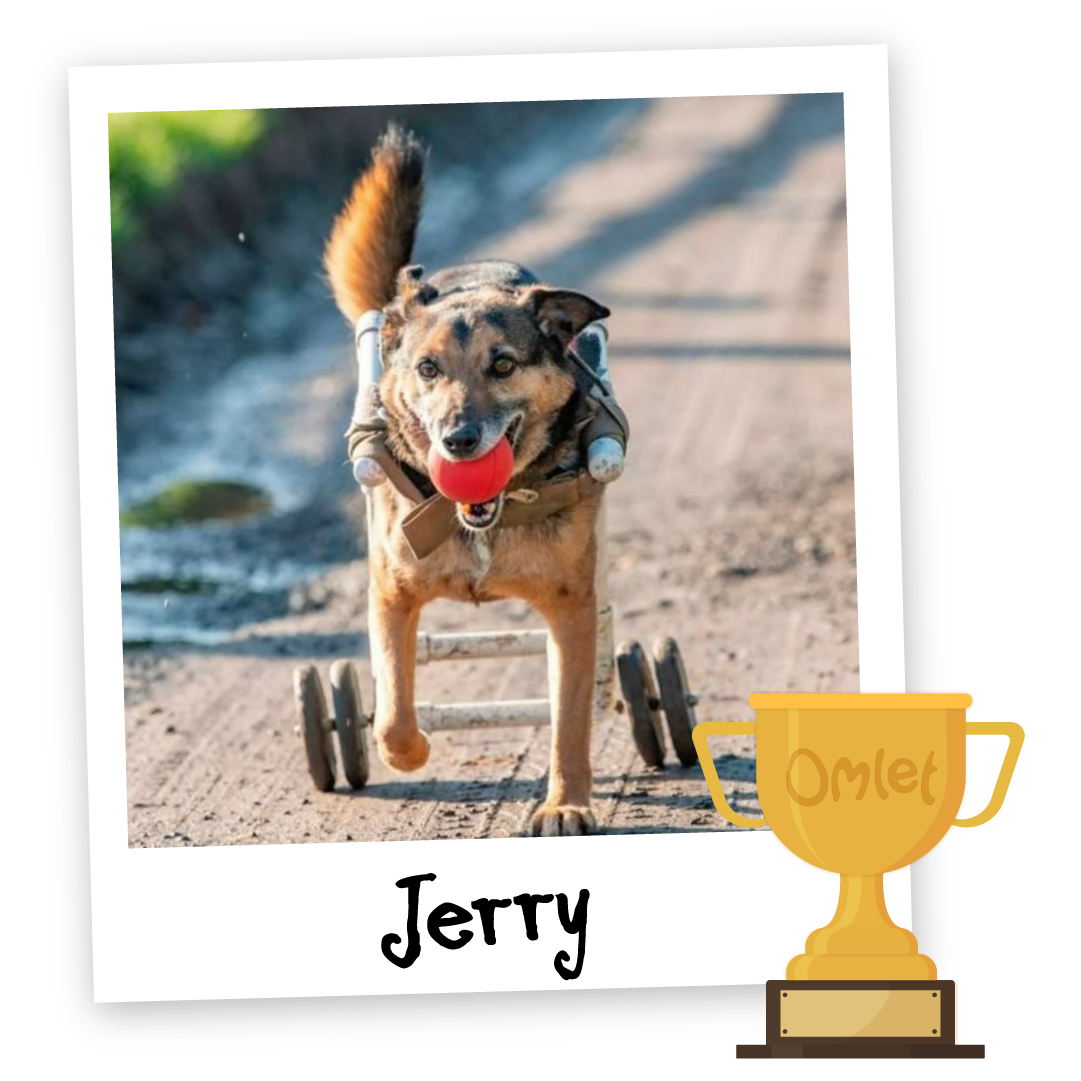
Shena had four dogs, worked for the NHS in cancer care and was studying for a degree in Social Care. Then a friend sent her a video of a puppy in Romania, and her heart melted.
Jerry was paralysed, an unwanted street dog who had probably been hit by a car and left for dead. Shena couldn’t get the image out of her head, “What’s one more?” she thought and decided to bring him home.
The first time Shena met him, Jerry jumped out of the car, a bundle of energy. It was love at first sight. He was a playful six-month-old puppy. Shena’s four dogs gladly accepted him, and he slotted into the pack straight away.
Having been through so much already, it was perhaps no surprise that after the operation to remove his hind legs, Jerry bounced back again even after a few falls while he perfected his balance.
Jerry can walk on two legs around the house and garden and manages well, but he wears his wheels on walks. They’re made from plumbing pipes, and at first he was a bit wobbly on them, but with a couple of days of practice, he was charging off. Now on his 3rd set of wheels, Jerry loves chasing balls. Nothing can stop him. Shena thinks he’s probably faster than the other dogs!
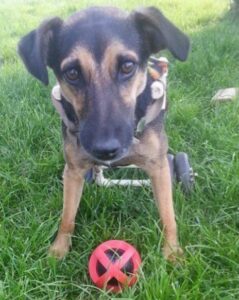
Jerry kicked off a following on Shena’s social media, and people started coming to her for advice about disabled animals. Jerry now has two more two-legged dog friends and a special relationship with Flo, another Romanian rescue. In 2013, just a few months after getting Jerry Shena and her husband Ian decided to set up PUDZ officially. PUDZ is an animal sanctuary that specialises in disabled animals.
Until last year Shena and Ian looked after 170 animals, including dogs, cats, rabbits, chinchillas, guinea pigs, chickens, ducks and turkeys from their North Lincolnshire home.
Because of their disabilities, many of the animals Shena and Ian care for wouldn’t be here. With Jerry for inspiration, they’ve recently been able to raise enough money to buy a one-acre plot of land so their excellent work can continue and the animals in their care can lead the happy lives they deserve.
“Jerry changed my life completely. I’ve met so many people. Animals don’t get as much care as people, but we don’t give up on people who are disabled, so why should we give up on animals? Everyone deserves a chance in life.”
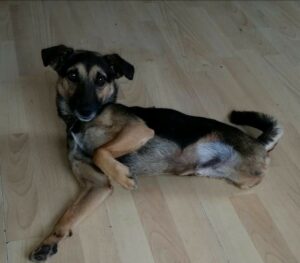
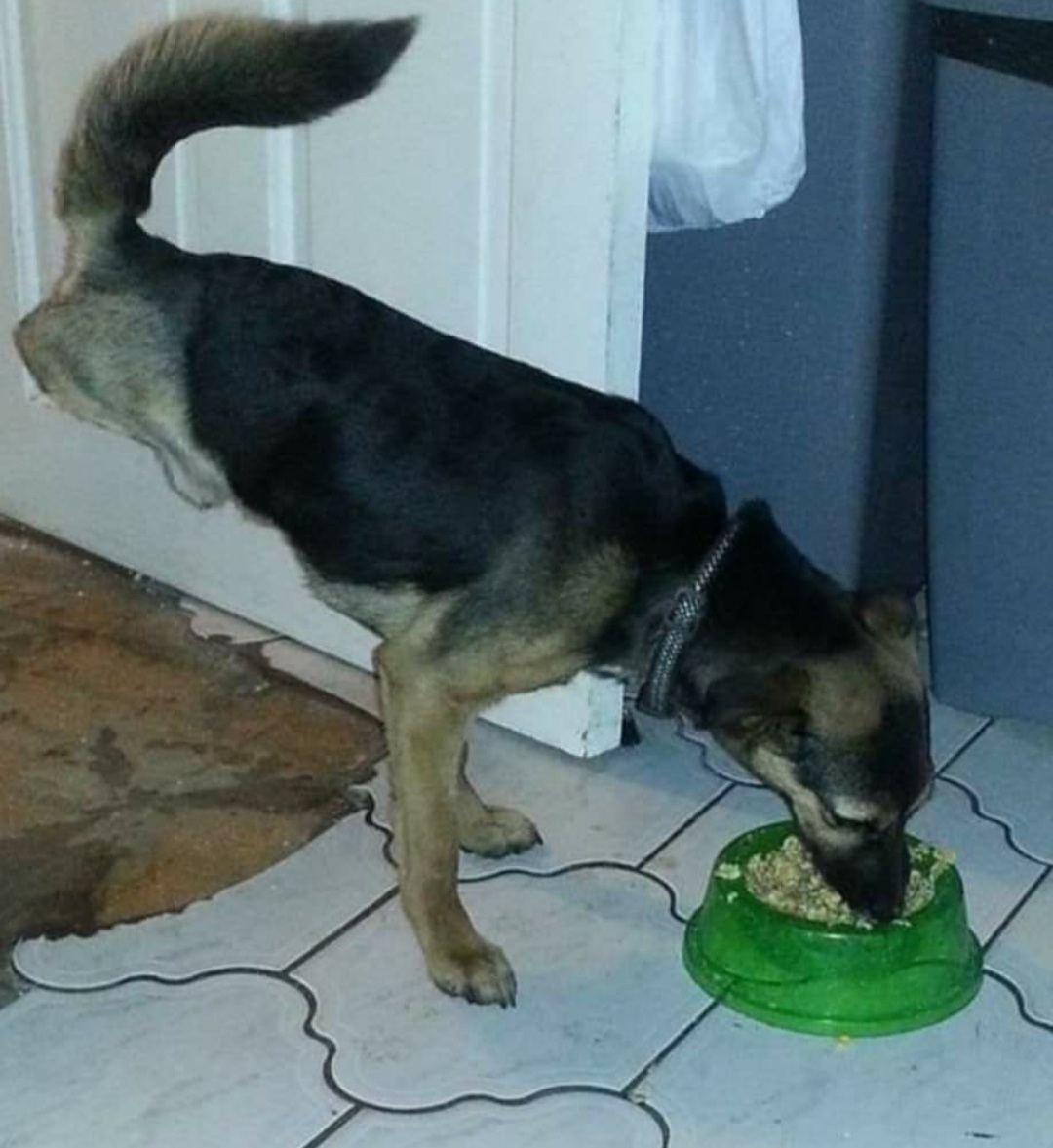
This entry was posted in Dogs
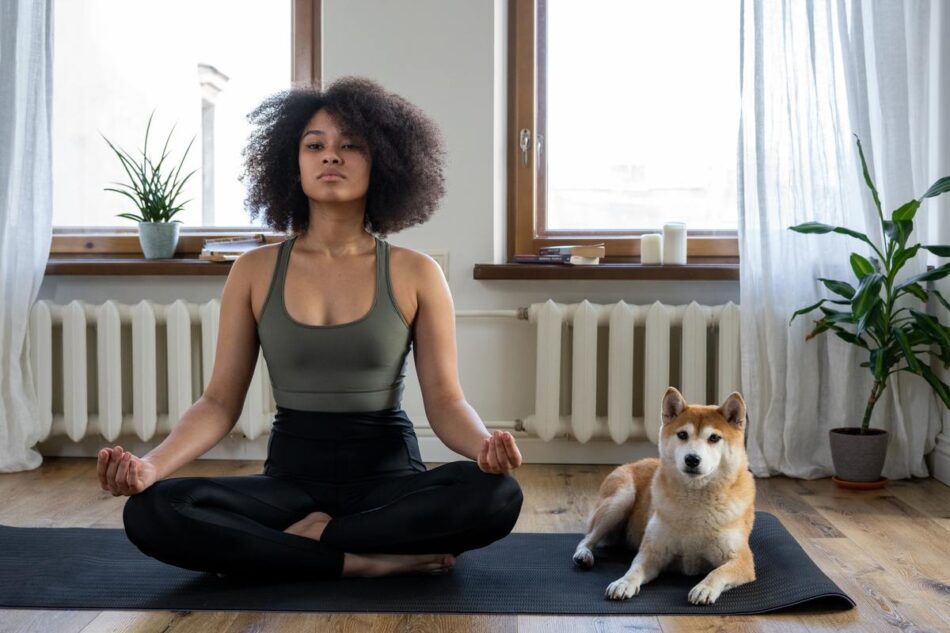
Taking your dog on a long walk is one way to help you both relax, but sometimes, it isn’t always possible to get outside, which means finding other ways to stimulate your furry friend from the comfort of home. Introducing doga…
What is Doga and what do you need?
You’ve probably already heard of yoga, but what about doga? Born in the United States in the early 2000s, dog yoga, AKA doga has quickly spread across the globe. This activity is an opportunity to spend some quality bonding time with your dog and keep fido entertained.
To begin your doga journey, you’ll simply need a yoga mat and a comfortable outfit! This sport can be practised outside, but if the weather isn’t looking great, it’s just as fun to have a go indoors, too! If you do choose to carry out your session inside, make sure to stick to a room your dog feels comfortable in and is familiar with. Having a routine for your dog gives your pet confidence, and they’ll soon associate the yoga mat and the room with spending a moment of relaxation just with you.
The benefits of doga
Doga largely incorporates the benefits of yoga: relaxation, concentration, meditation, and refocusing on yourself. And when done with your dog, it brings new advantages.
Make your dog’s day more zen
Our dogs know when we’re stressed, and picking up on these behaviours in turn affects their mood, too. But, by taking time to breathe and relax with a spot of doga, both you and fido can destress.
There’s no specific doga rulebook, which means tailoring your sessions to meet you and your dog’s needs. If during the earlier sessions, your pup would prefer to stay by your side without joining in, don’t force them. Remember – it’s supposed to be fun for you both.
Learn to speak dog
Well…kind of! Guiding your dog throughout the doga session means taking the lead and communicating to your dog what you would like them to do, just as you would teaching them a new trick. Repetition is the key to a successful session with your dog and adding this new activity to your schedule will be an opportunity for you to enjoy your dog’s company while strengthening how you interact with one another.
Improves sleep
Dogs love to sleep and we know just how important it is for them to get plenty of shuteye. If your dog is struggling to settle into a sleeping pattern, a physically and mentally stimulating activity like doga is one way to help them out. And don’t forget after a workout session to treat fido to a dreamy Omlet Dog bed to upgrade their sleep to another level!
Can my dog do doga?
Doga is made for all types of dogs – young, old, large, and small! Doga can be especially useful for older dogs or dogs that suffer from arthritis. But please note, if you have any concerns about your dog’s condition before beginning doga, consult your vet. Stretching, if done correctly, and massages can have real positive impacts on your dog’s body.
How to practice doga
To get started, take a look at our top book recommendations and videos for the best ways to practice doga.
It’s essential to spend time with your dog so that they can develop to their full potential. Just doing one doga session alone won’t suddenly improve your relationship with your pet pooch, but once you establish this activity as a routine not only for you but also for your pet, you may well be surprised at the benefits you can derive from it.
In addition to this fun activity, don’t forget that the well-being of your dog depends on a balanced diet, daily walks and special attention to their needs.
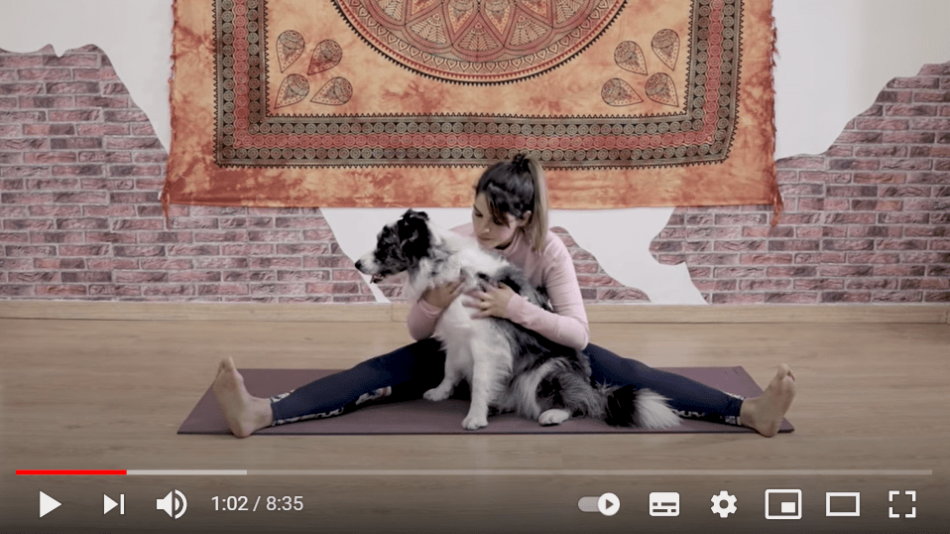
This entry was posted in Dogs
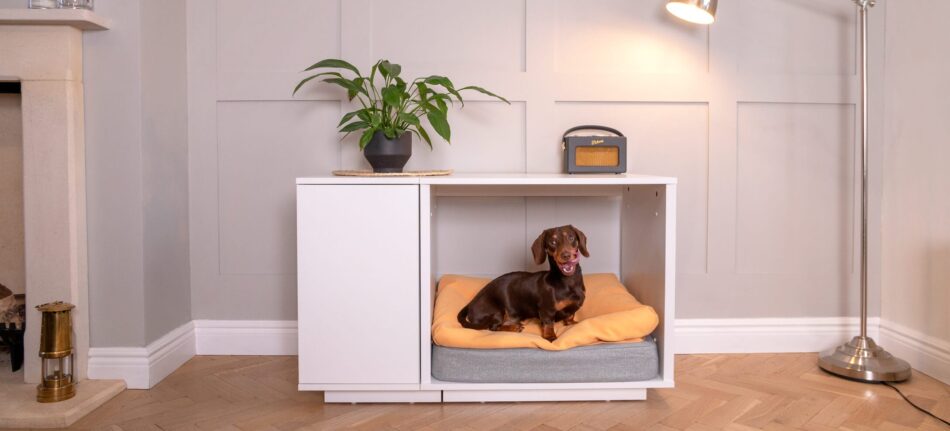
Many dog owners believe their dogs enjoy a good laugh. Check out YouTube, where there is no shortage of smiling and laughing dogs!
However, can a dog laugh in the same way as a human laughs? It’s very easy to anthropomorphise animal behaviour – i.e. judge everything they do from a human emotional and moral perspective – and the real question, perhaps, should by why would a dog laugh? What does it mean, and what advantage would it have given the dog’s wolf ancestors in the wild? Or is it perhaps something they have only learnt to do since they were domesticated by humans?
There is no definite answer to that last question, but we do know a bit about animal laughter.
Do other animals laugh?
From a hard-nosed science point of view, the only animals that are definitely confirmed as laughing are the great apes, dolphins and lab rats. Chimpanzee laughter sounds to our ears more like a shriek, and in the wild it is linked to reassurance and the release of pressure rather than pleasure. However, a tickled chimp definitely laughs, just like a human child does.
Gorillas have been known to laugh at slapstick human behaviour, suggesting that they would make a great audience at a pantomime! Orangutans are a bit more inscrutable, and their signs of laughter may be more akin to simple copying than genuine amusement. They laugh when tickled, though.
A 2004 study of dolphins found that the animals produced a sonar pulse followed by a whistle when playing. The researchers concluded that these sounds meant that the dolphins were feeling happy and relaxed in a fun, non-threatening setting, and that the ‘laugh’ prevented the rough and tumble play from escalating into violence. This is fascinating, as many psychologists believe that human laughter evolved for these exact reasons, and it ties in with those wild chimpanzee ‘laughs’ too.
The fact that lab rats laugh when tickled suggests that, given the chance, many other mammals would chuckle when tickled too. They just haven’t been given the chance in a scientific setting. Dogs, however, seem to relax rather than burst out laughing when tickled.
The fact that you can’t make your dog laugh by tickling it doesn’t mean it can’t laugh, though.
What does a dog laugh sound like?
Dog laughter – if that’s what it is – is a kind of rapid panting – a play-pant which they use to invite humans and other dogs to play. It is a hhuh sound followed by a hhah sound, and humans can impersonate it by making breathy ‘hoo-haa’ sounds. The panting will often be combined with head bows, and the dog may reach out with one of its paws too, or make little teasing jumps in your direction. This is an invitation to play rather than an expression of amusement in the human sense of laughter, though.
If you laugh at your dog using the hhuh hhah panting sound, drawing your lips back in a cheesy grin during the ‘aaa’ part, you may make your dog laugh back. It’s a great way of bonding with your furry friend!
Do dogs smile?
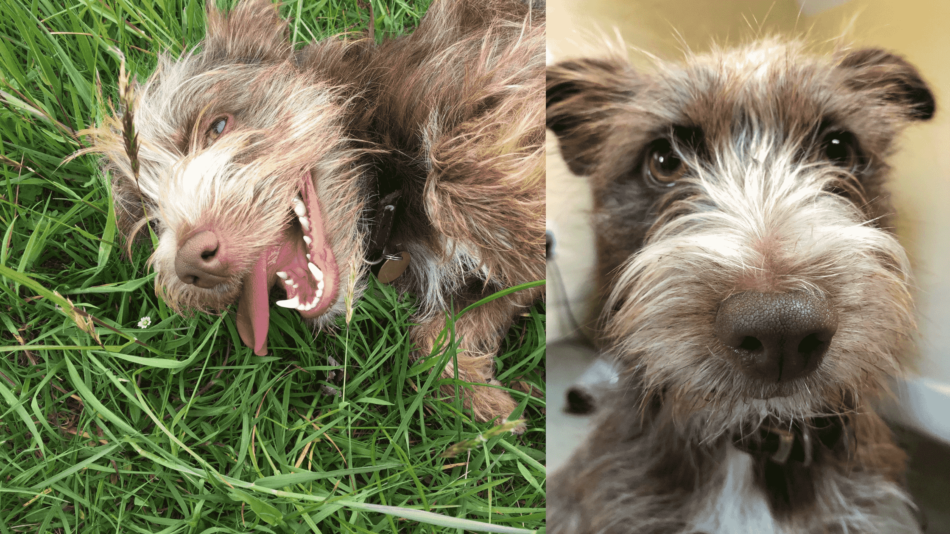
When a dog is relaxed it often pulls back its lips, lets its tongue droop and narrows its eyes, it can sometimes – depending on the breed – look like a smile. The fact that they pull these faces when happy and relaxed makes it an easy associated with smiling. The fact that human smiles seem to have their origins in tension-reducing body language suggests that the same might apply to dogs. The wild wolves, close cousins of the domestic dog, does indeed have a tongue-wagging facial expression linked to relaxation and submissiveness.
Intriguingly, smiles appear to be contagious among dogs, just as they are in human to human interactions. If you can’t make your dog laugh, you can certainly make it smile! Smile at your dog, and your dog may well smile back!
Do scientists believe that dogs can laugh?
Science is on the side of the laughing dog. In a 2005 study titled ‘Dog-laughter: Recorded playback reduces stress related behaviour in shelter dogs’, it was discovered that a dog sometimes pants in a way that sounds like a laugh. When recordings of these ‘laughs’ were played to other dogs, the dogs became playful and de-stressed, as measured in stress-related behaviour such as tail wagging, doggie ‘play-faces’, happy body language and lip-licking.
However, being happy, relaxed and playful is not exactly the same as laughing. There is no evidence that a dog ever finds things amusing in the same way as humans – or gorillas – do. On the contrary, slapstick behaviour is more likely to startle or scare a dog.
Laughter is all about fun, though, and you can certainly have plenty of that with your dog. They readily show their emotions through sounds and body language. Take the panting and playful body language as a sign of deep friendship. And that means there’s plenty to laugh about!
This entry was posted in Dogs

Just like humans’, dogs’ opinions on hot weather vary. Some absolutely worship the sun and will take any opportunity to find a sunny spot to lie down on, whereas others prefer to stay in the shade sipping some cold water, longing for autumn. Certain dogs are more likely to struggle with heat, including flat-faced breeds, dogs with thick coats, giant dogs, overweight dogs or dogs with underlying medical problems, so if your pooch is in a high risk group it’s extra important to make sure he or she stays cool. Here are some ways you can help you dog beat the heat:
1. Adjust Exercise
When it’s really hot outside it’s best to stay inside during the hottest hours of the day. Your dog will still need exercise, but if possible, stick to walks early in the morning or late at night when it’s cooler.
It’s also worth trying to walk as much in the shade as you can, to avoid hot pavements and tiles, and to stop your dog from running around too much whilst out on the walk, maybe by keeping them on a shorter lead.
2. Keep Hydrated
Make sure your dog always has access to clean, cold water, ideally in all rooms of the house. If you’re going out, bring a bottle of water and a foldable bowl.
If you’re worried your dog doesn’t drink enough water, try feeding them things that are hydrating and have a cooling effect. Frozen fruit and veg are great, but you can also put some cooked chicken in a blender with some banana or assorted berries and freeze in ice cube trays.
3. Get On Top of Grooming
This is extra important for breeds with thick fur, as they particularly struggle in the heat, but most dogs benefit hugely from some extra grooming in summer. For some, regular brushing to get rid of dead hair will be enough, but others need to have their coat properly trimmed for summer.
Don’t be tempted to grab the trimmers and give your dog a buzz cut; the sudden lack of insulation can shock the dog and damage the quality of the coat, as well as make him or her feel very self-conscious! Take them to the groomers and ask what they recommend for your dog’s type of fur.
4. Go For a Dip
Having water around to cool themselves down with will be highly appreciated by most dogs. You can put a shallow paddling pool in a shaded area of the backyard, turn the sprinklers on and watch your dog run through them, or let him or her play with the garden hose.
If you live close to the sea or another body of water and your dog is used to swimming you can take them there to lower their body temperature in the evening. Remember that swimming can be tough exercise though, so call them back up when you’re happy they’ve cooled themselves down.
5. Keep Cool Inside
When it’s too hot to be outside, your dog will probably spend most of their time indoors, so it’s important to try and keep your house as cool as possible. It might be nice to open windows on different sides of the house to create drafts, or find other ways of letting cool air circulate. Drawing the curtains or blinds will help stop the sun from heating up bedrooms during the day.
6. Avoid The Car
If possible, try to avoid going in the car with your dog when it’s hot. We all know that you should never, ever leave a dog in a car in warm weather, it doesn’t matter if the car is parked in the shade, you’ve got the windows open and it’s only for a few minutes. A stationary car will quickly get very, very hot, and it can kill your dog.
If you can choose not to go in the car on very hot days, try to avoid it, especially if your dog is not a big fan to start with.
7. Get a Cooling Mat
On a hot day, your dog will love relaxing on something cooling. The Omlet Cooling Mat doesn’t require refrigeration or electricity, but works by absorbing heat from your dog’s body while at the same time cooling your pooch down. The memory foam mat is foldable and super comfortable, so you can take it with you wherever you go in summer, assuring your dog will always have a place to rest that will also minimise the risk of heatstroke.
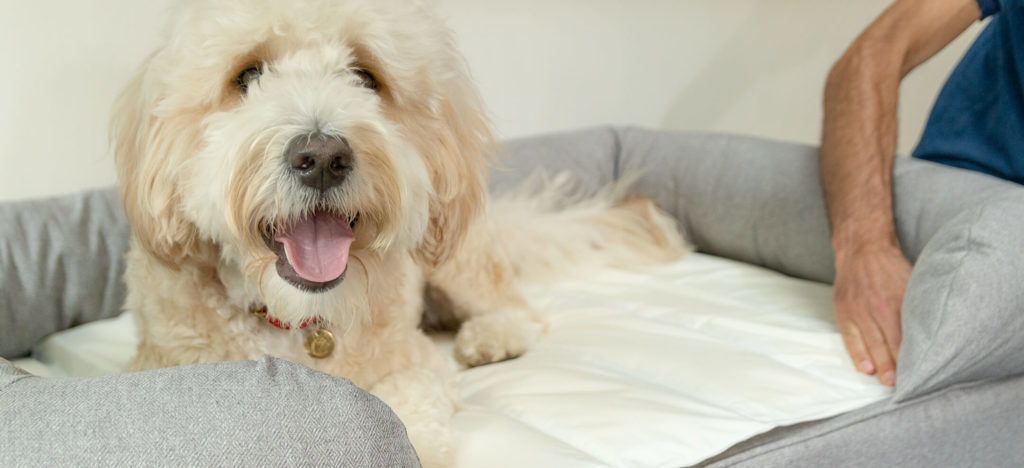
This entry was posted in Dogs
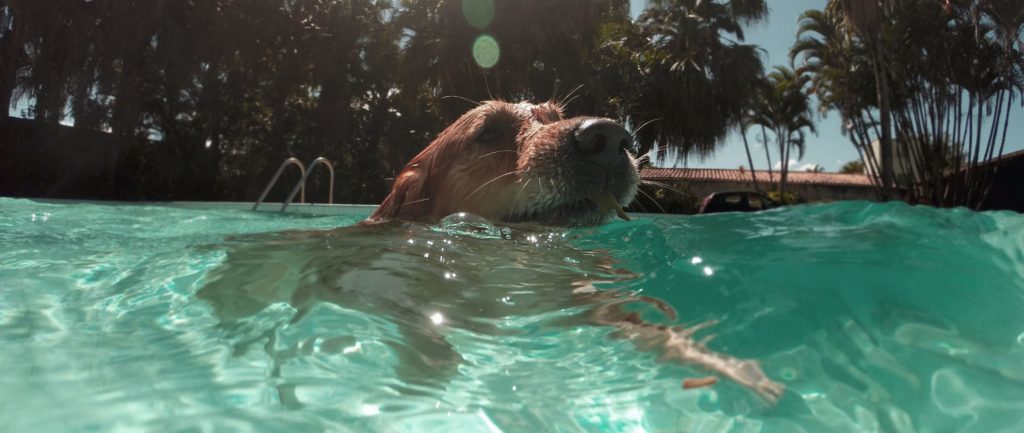
While it’s true that most dogs can swim, not all of them actually enjoy it. Some dogs’ idea of swimming involves paddling for dry land as quickly as possible, while some take to the water as if they were otters in a previous life.
With some breeds, the clue is in the name. The Irish Water Spaniel and the Portuguese Water Dog, for example, love taking the plunge, as do Poodles, Newfoundlands, Setters, Retrievers and many more. Some dogs, however, are simply not built for swimming. Dachshunds, with their short legs, and Pugs and English Bulldogs, with their short necks and poor breathing, struggle in water.
When confronted with lakes and rivers on a walk, the dog will decide for itself whether or not it fancies a quick dip. In a private pool, however, you need to be aware of the various safety and hygiene issues, because at some point your pet is bound to take to the water.
Mastering the Doggy Paddle
If the pool is a public one, dogs will simply not be allowed, so safety issues don’t arise. Pools in people’s backyards, however, become just as much a part of the dog’s playground as the humans’. Rule number one for pool owners – or for owners who visit friends with dog-friendly pools – is to make sure your dog is safe in the water.
A weak swimmer will tire very quickly and can soon get into trouble if unsupervised. Training your dog to swim to safety is therefore very important. Using your usual “Come!” command will usually work well. For smaller dogs, or if the pool is high-sided, a ramp should be attached to the side to allow the dog to clamber out. If the pool has steps, make sure the dog knows where they are. If the pool is large, make your dog jump in from different points, and guide them to the exit each time, to make sure they have a clear mental map of how to get out.
Another popular option is a dog life-jacket, which will allow your pet to swim while preventing it from sinking fast if things go wrong. If you never leave the dog unsupervised, these shouldn’t really be necessary; but if you are having a busy afternoon, your eye might not always be on your pet, so a dog flotation vest is great for ensuring peace of mind.
Some dogs really take to floats and inflatables (claw-proof ones made specifically for dogs, ideally). They can use them to take a break from paddling, or can simply lie on them like a human on a sun lounger.
If a dog gets itself into serious difficulties and needs rescuing, knowing how to administer CPR (Cardiopulmonary resuscitation) can save the pet’s life. There are tutorials available for this online, or you could ask your vet for advice.
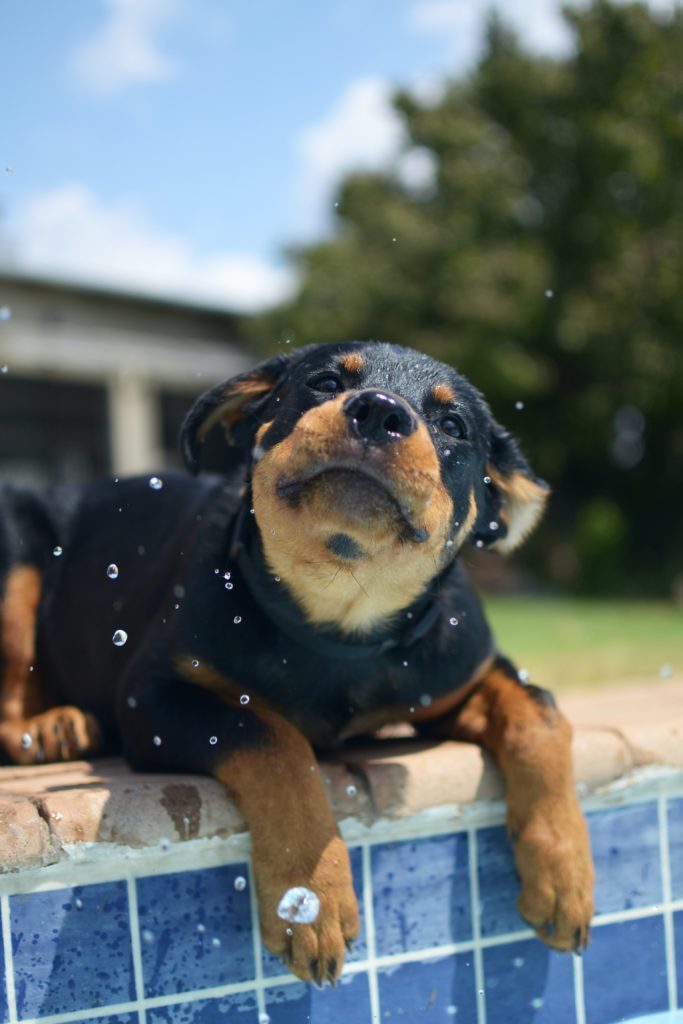 Don’t Drink the Water
Don’t Drink the Water
Dogs can quickly overheat if the sun is beating down, and they may naturally take to water to cool down. Swimming is hot business, though, and it’s far better for your pet to cool down in the shade with some fresh water to drink.
And that’s another hazard – a hot, thirsty dog in a pool will do what come naturally and drink some of the pool water. If they lap up too much of the chlorinated water, they may become sick. Again, providing some fresh water somewhere cool and shaded will prevent them drinking from the pool.
Just like a human, a dog who has spent time in the pool will need rinsing off, to remove the potentially irritating chlorine and other chemicals from its fur, eyes and skin.
Your Dog Loves the Pool, But Does the Pool Love Your Dog?
There are three major issues for a swimming pool used by dogs: bacteria, hair, and wear & tear.
The bacteria is associated with poo and wee. The dog doesn’t need to actually relieve itself in the pool for these contaminants to be released into the water. However, as long as your pool is properly maintained and chemically treated, the bacteria will be killed, so this should not be an issue.
The hair factor is more of a problem. Dog hair will accumulate in the pool filter surprisingly quickly if your pet sheds a lot. A good brushing before swimming will help, but you will still need to clean the filter and other pool machinery more often than you would with human-only swimmers.
Wear and tear is an issue with doggy paddlers because of their claws. They will scrabble at the sides of a pool, and at the bottom of a shallow area. A pool lined with plaster, pebbles or tile will withstand the clawing, while plastic or vinyl-lined pool may spring a leak. You should also bear in mind that dog claws and children swimming in the same pool may be asking for trouble, too.
Follow these simple guidelines and precautions, and pools can be enjoyed by dogs and owners alike. But don’t force the issue – some dogs love the wet stuff, while others prefer to keep their feet on dry land.
This entry was posted in Dogs
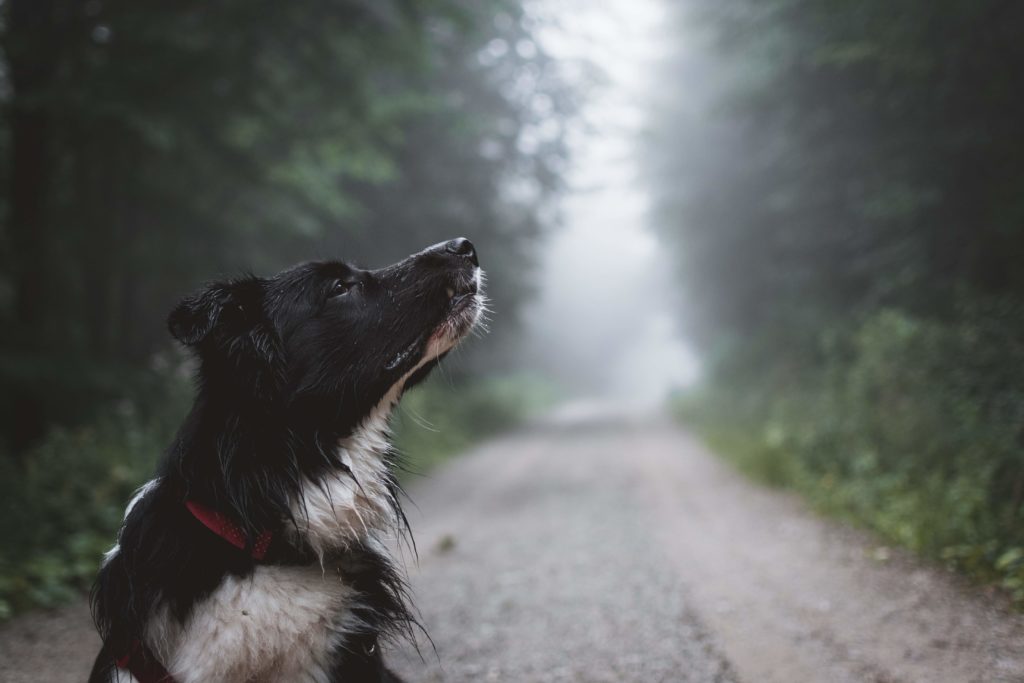
In many ways dogs age in similar ways to humans. Older dogs have less energy, lose some of their senses, experience changes in sleeping and eating patterns, go grey and can have trouble remembering the most ordinary things.
Additionally, muscles and bones become weaker, and the immune system is not as good at fighting off infections. Internal organs also get more tired, so the dog is more prone to liver, heart and kidney disease.
This may seem rather gloomy and depressing, but it’s just a part of nature we have to accept, and as long as you as an owner continue to care for your dog in an appropriate way as they get older, you can really enjoy the last golden years together.
What counts as a senior dog?
Not all dogs reach old age at the same time. Just as with humans, some dogs seem a lot younger or older than their actual age, and genetics play a part in the risk of developing diseases and problems with hearing and sight.
But the most important thing when figuring out when your dog will be a senior is size. Toy dogs, terriers and other small breeds are seen as old when they are 10-11 years, medium-sized breeds like retrievers are considered seniors when they are 8-10 years, and large and giant breeds reach old age at 5 or 6.
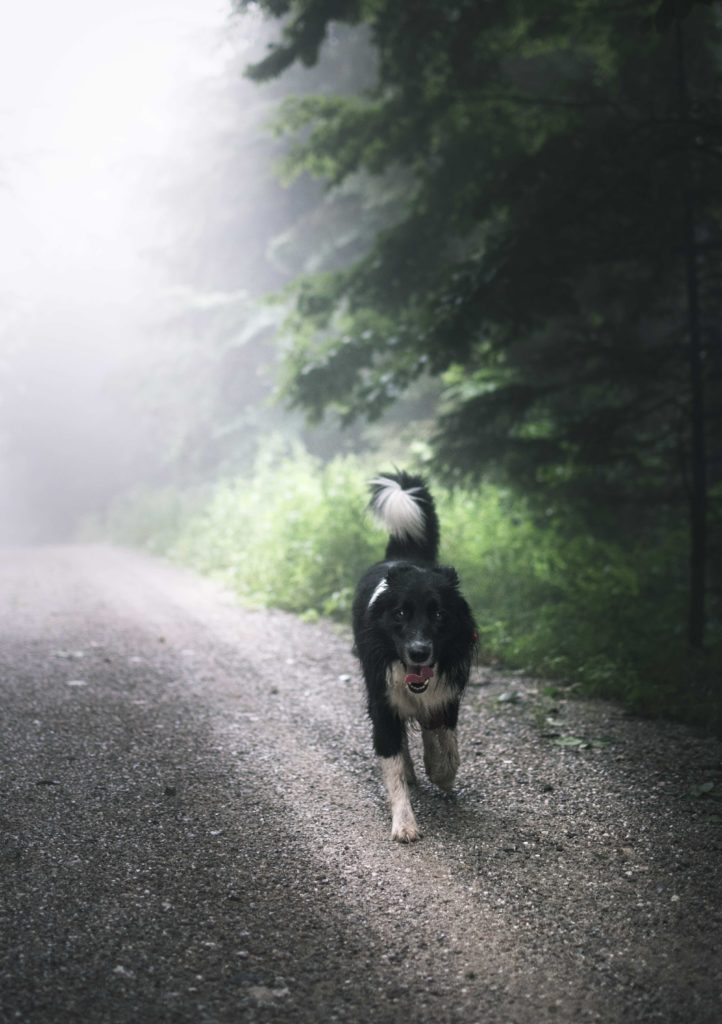 What can I do to help my dog in old age?
What can I do to help my dog in old age?
Your dog will still need regular exercise, even if it might look a bit different from when they were young and bouncy. Accept that the dog won’t be able to come on the long walks they used to love, and try exercising for shorter periods of time more often. Remember to also stimulate your elderly dog mentally. Food toys and puzzles will be great for keeping your dog’s brain sharp.
Older dogs that don’t move around as they once did run the risk of excessive weight gain, and their diet will need to be adjusted to fit their new energy levels. Ask your vet for advice on what to feed your senior dog, but in general it’s good to choose a low fat feed and limit the amount of treats.
Make sure you take your dog to the vet for more regular check ups as he or she gets older. That way you will be able to spot potential problems early on. Dental hygiene is more important than ever, and it’s common that the skin gets drier and the coat less shiny, so it might be a good idea to do a bit more grooming.
Changing sleeping habits
Long gone are the puppy days when your dog passed out anywhere and slept for hours. Comfort is super important for older dogs, and their tired muscles and bones will need support.
Choose a dog bed that is designed to look after the dog’s body, ideally with a firm but supportive mattress and a soft cover. Omlet’s dog beds are great for senior dogs, not only because of the high performing memory foam mattress and supportive features, but also because they can be raised off the ground, making it much easier for an older and less agile dog to get in and out of the bed.
It’s also important to be aware that senior dogs often are much more sensitive to temperature changes. Place the dog’s bed somewhere that stays warm in winter and cool in summer, and provide them with an extra blanket in winter and maybe use a cooling mat in summer.
Making the right decisions at the end of life
There might come a time when you as an owner will have to make unpleasant decisions regarding your dog’s health and potentially whether or not your pet’s life is worth living.
If your dog develops an illness that can be treated, you will need to consider what the interventions will be like for the dog, what their quality of life will be after the treatment, and how long it may extend their life. If you have insurance, money hopefully doesn’t have to be a factor to consider, but many operations and treatments are extremely pricey and far from risk free.
Remember to try and put your own feelings to one side and concentrate on what is best for your dog. Although you might be able to get another few months together with your pet, he or she might be in constant pain, and will not be able to do all the things they used to love, and will not enjoy themselves.
Older pets can easily struggle with anxiety. Their body and mind are changing, and they can’t figure out why. Even if your dog might not be able to see or hear you as well as they used to, they can sense your presence, and that will make them calm and happy, so try to spend as much time together as possible. The last few years of your dog’s life can be a wonderful time for both of you, so don’t dwell on aging but take them for a walk, snuggle up with them on the sofa and play with them – just like you’ve always done!
This entry was posted in Dogs
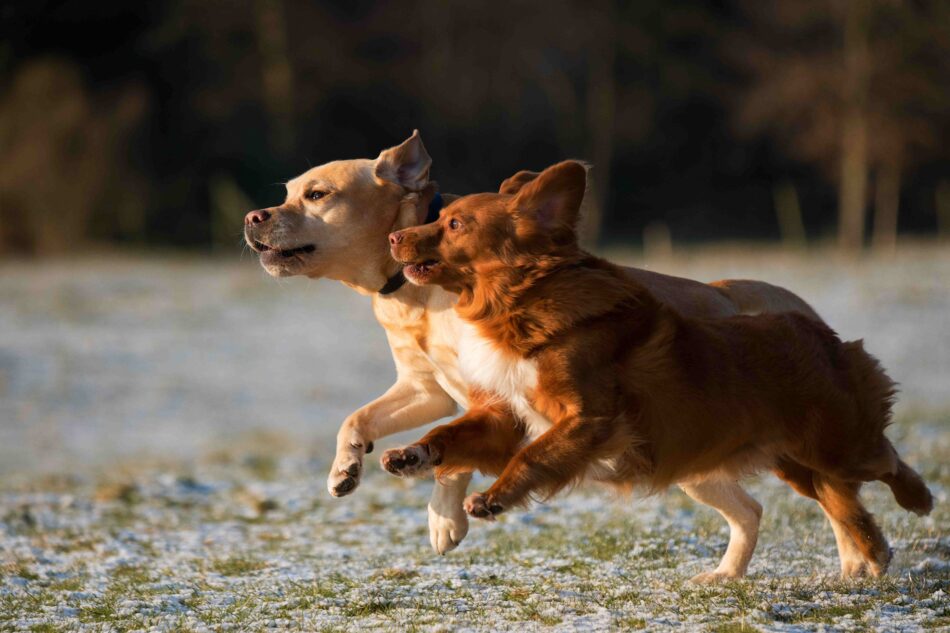
Playdates for dogs are an increasingly popular calendar fixture for dog owners. The fact that these most sociable of animals like to socialise should not come as a great surprise. But there is, of course, far more to a successful get-together than simply unleashing a kennelful of canines into your back garden!
Our ten tips will help ensure that your pooch party goes with a woof rather than a snarl.
1. Don’t Invite Enemies!
The guest list is possibly the most obvious party-success factor of them all, but it is one that often gets ignored. For example, your friend might have a Jack Russell that your Labradoodle simply hates. And yet inviting your friends and their dogs is an obvious thing to do when arranging a doggy date. A territorial or bad-tempered dog that doesn’t get along with your pet is not going to be the life and soul of your doggy date. And, of course, your own dog needs to be a sociable hound host, too.
2. Avoid Chalk-and-Cheese Syndrome
Dogs tend to play best with friends of their own size and of a similar age. An older dog doesn’t want to be harassed by a bunch of excitable puppies, and a small terrier doesn’t always want to be stalked by an enthusiastic pack of Retrievers. An overweight or arthritic dog may suffer, too – they may want to keep up with the others, so as not to miss out on the fun, which may result in more harm than good.
The exception to the chalk-and-cheese rule is when dogs already know each other. If you know they’re friends already, invite them – although you still need to watch out for the reactions of the other guests.
3. Keep the Numbers Down
The difference between a happy group of dogs and a rowdy pack is a fine line. As a rule of thumb, keep the number of dogs to six or below on a doggy date, to keep things under control.
4. Invite Humans Too!
A doggy date isn’t an excuse for owners to leave their dogs in a crèche for a couple of hours. It only works if the owners are present; and an owner who brings more than one dog should, ideally, bring more than one human too.
5. Make Sure the Space is Suitable
There are all kinds of places you can hold a doggy playdate, whether indoors or outdoors, and the guest list should match the space. Six Huskies in a kitchen isn’t going to work, and open gates or gaps in a fence are just asking for trouble. You will also need to dog-proof the room or the garden, removing access to anything that’s fragile, toxic, edible or out-of-bounds for whatever other reason. The host dog and its guests should not have their own toys or bones lying around, either – all available toys should be neutral. If the host dog is very territorial, it simply isn’t going to work unless you arrange the playdate in a neutral space.
6. Meet and Greet
The dogs should all be formally introduced before the doggy date begins, even if they have met before. Owners should have their pets on a lead, and the dogs should be made to sit, in a semicircle so they can all see each other. They can then mingle on loose leads. Only when everything is looking sociable should the dogs be let off the lead completely. Any dissenters will have to be kept on a lead until they get into the spirit of the party. If, for whatever reason, one of the doggy guests falls out with another, it should be led quietly away on a lead until the situation has calmed down.
7. Allow Downtime
Some dogs have more energy, patience or bravery than others. On a doggy date, it always helps to have a hidey hole where a dog that needs to catch its breath can take time out. For smaller dogs, this can be the owner’s arms. Larger dogs will need a quiet corner, indoors or out. In a larger garden, they will be able to find their own space to chill. Dogs are very good at body language, and the others will recognise that the resting dog is doing just that, and not playing hide and seek.
8. Provide Refreshments
Busy dogs will need to drink, so one or more drinking bowls is essential. A supply of treats will keep the edge off their appetites, too.
9. Play Some Party Games
Games of fetch, hide and seek, sit and wait, agility tests or obstacle courses are all great ways to keep the party happy and active. Treats can be used as prizes!
10. Avoid Too Much Sun
If it’s a really hot day, an outdoor doggy date will needs lots of shade, lots of water and should involve only the very fittest dogs. Heat can be a health hazard for weaker animals. Remember – you can always postpone.
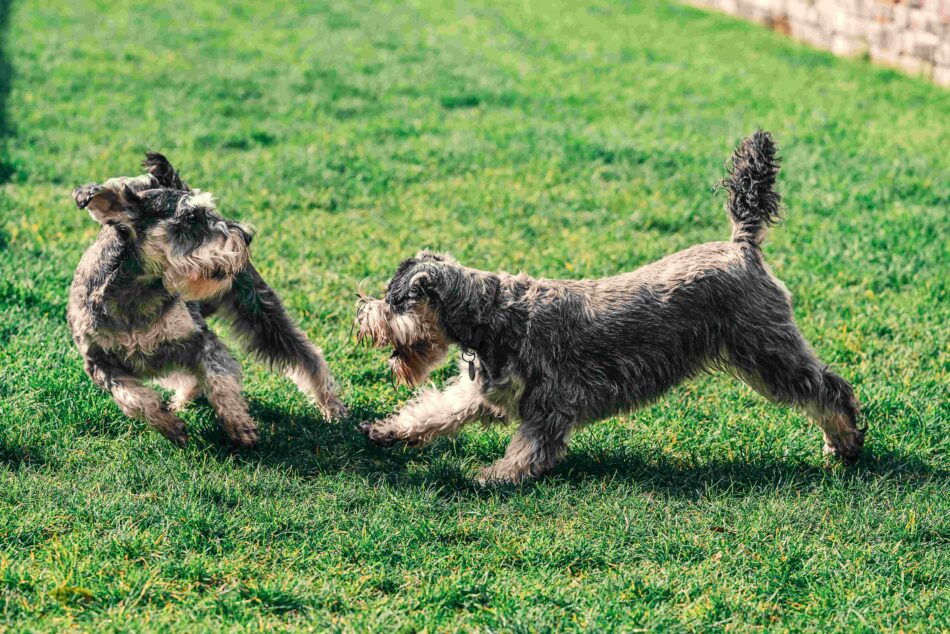
This entry was posted in Dogs
1. We talk too much
Dogs don’t know English, and they won’t understand syntax and grammar however much you try to teach them. As you can imagine, it will be extremely frustrating having a human shouting incomprehensible noises at you.
Dogs like learning spoken commands and connecting them to actions, but won’t be able to understand anything longer than a short sentence, and will be very confused when you start using new ways of telling them to do things. If you’ve taught them the command “drop” to get them to give you a stick or a toy, then “leave” or “let go” or “give me that, you silly sausage!” won’t be of much use.
2. We let other people into our territory
Humans think it’s normal to go to other people’s houses, and to let individuals from outside the pack come into your and your dog’s territory. This will annoy some dogs immensely, and can actually make them really stressed, so don’t be surprised if they treat visitors with suspicion.
If you want to invite other dogs into your house, it might be a good idea to let the dogs meet on a walk beforehand, on neutral grounds. Most dogs will be absolutely fine with sharing their space, but it’s always best to minimise the risk of arguments.
3. We stare at them
We think that eye contact is something beautiful that is needed for bonding, and with both our own dogs and new ones we meet we tend to look into their eyes as we’re saying hello. Most dogs don’t appreciate this. While loving gazes between you and your pup is often accepted, being stared down by a stranger can be extremely stressful for a dog. They see the focused stare as a challenge, and might consider you a threat, so try to avoid eye contact with dogs you don’t know.
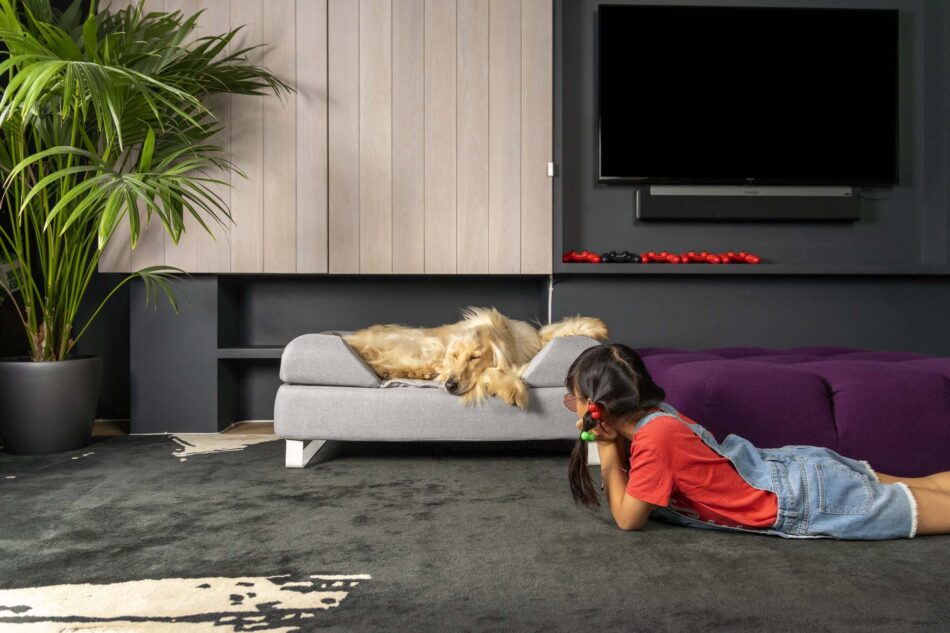
4. We don’t let them sniff on walks
For dogs, walks are not just about exercise. While we humans can stop to enjoy beautiful scenery, dogs explore the world much less visually, and prefer to snuffle around for interesting smells. This also provides them with great mental stimulation that will tire them out just as much as the actual walking, so try to be patient with your dog and let him or her stop, sniff and mark as much as they like on a walk.
5. We change our shape and smell
Dogs change their coat roughly once a year, whereas humans change clothes every day, use different hand soaps, spray themselves with perfume and use cleaning products in their homes. Dogs might get to grips with this unusual behaviour after a while, but they will definitely not see the point, as they would probably prefer it if we never washed and walked around in the same clothes all the time.
6. We’re inconsistent
Dogs get very confused with inconsistency. They don’t understand “just this once” or “only when mummy is on a work trip”, but will much prefer to for example always be off the bed rather than having to constantly try to interpret your varying signals.
7. We leave them alone
To dogs, some of the strongest pack animals around, leaving the group seems absolutely pointless and stupid. That’s why they can get confused and annoyed when we leave them alone to go to work or to the cinema.
Train your dog to be by themselves from an early age to avoid bad separation anxiety, and try to never leave an adult dog alone for longer than four hours a day.
8. We get frustrated when they’re being dogs
To dogs, sniffing, barking, digging and scavenging for scraps are all natural behaviours, and they can get very annoyed if you get upset with them for doing what comes natural to them. This doesn’t mean that they should be allowed to do exactly what they want all the time. Try to redirect and encourage desirable behaviour, but it’s also worth remembering that dogs are dogs, and that’s part of why we love them so much!
9. We hug them
This is a slightly contentious topic, but many people mean that while dogs accept our hugs, they don’t like them. It depends on the dog, but some feel very nervous and stressed when we interfere with their personal space, and placing your arms around a strange dog’s neck can be seen as a threat.
Most dogs like cuddling, and nearly all love scratching, so if you want to be sure you can show your affection with a belly rub and shared sofa rather than constraining your pup with your weird human arms.
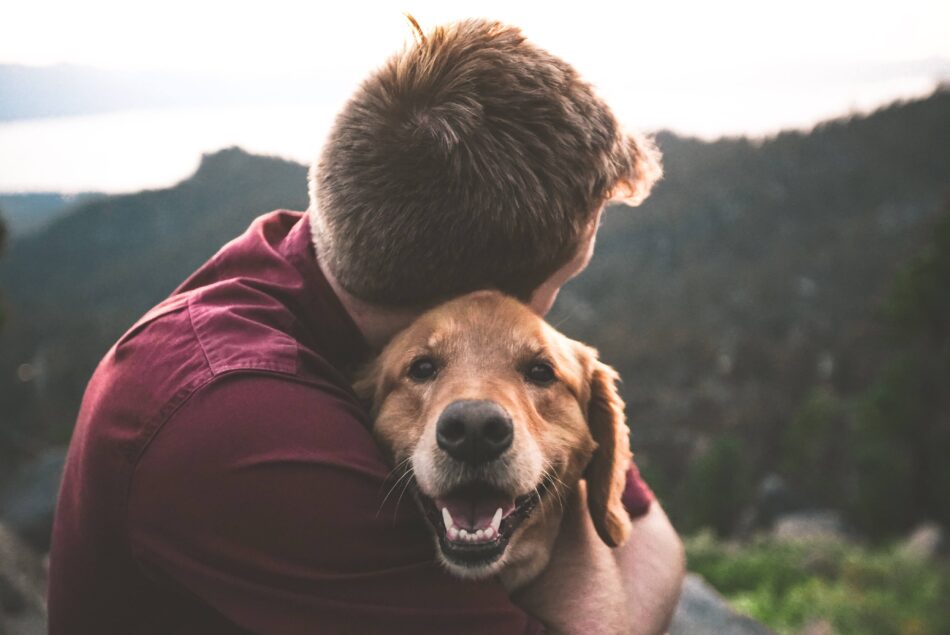
This entry was posted in Dogs
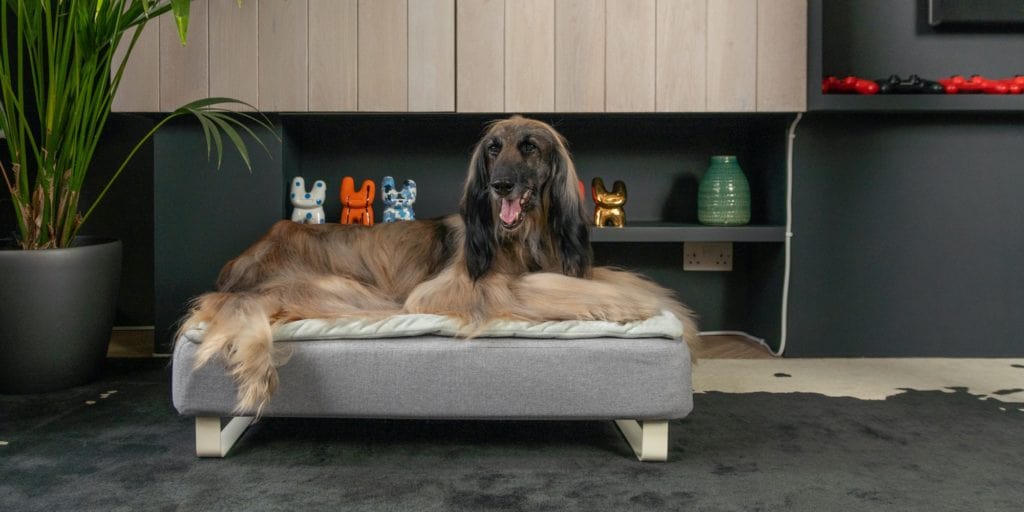
When choosing a dog – especially if it’s your first one – the key is to find a breed that complements your lifestyle. Like us, some dogs are happy to spend most of their time relaxing indoors, while others want to run half marathons every day.
So, think about your lifestyle, and then find the dog to match. Here are some helpful lifestyle and dog breed matches to help you narrow down the field.
Dogs for Sofa Lovers
Being an evening couch potato doesn’t necessarily mean you’re lazy – it probably means you’ve had a busy day at work, and need some downtime. Plenty of dog breeds fit this ‘couch canine’ lifestyle, including:
- Dachshund – these loveable ‘Sausage Dogs’ can actually damage their spines if they’re forced to take too much exercise. They will still need a morning walk, though!
- Greyhound – this one surprises people who don’t know the breed well. “Greyhounds?”, they say, “Surely all they want to do is chase hares at breakneck speed all day?” Well, yes, they can run fast; but their preferred lifestyle is actually long, lazy days, with a couple of short runs in the park.
- French Bulldog – they’ll be hyperactive for 20 minutes on a walk, and then they’ll be worn out. Lacking endurance, this makes them perfect for anyone who lacks time for long walks every day.
The popular lapdog breeds fall into this category too, including Chihuahua, Pug, King Charles Spaniel, Pekingese, Shih Tzu and Yorkie.
Dogs for Busy Outdoor Lifestyles
If you do lots of hiking or running, there are plenty of high-endurance dog breeds that will just love keeping up with you every step of the way.
- Dalmatian – these loveable hounds will find 101 reasons to run and play all day. Whatever you’re doing outdoors, they’ll be with you every step of the way.
- Border Collie – possibly the dogs with the busiest work ethic, they will happily be hyperactive from dawn to dusk. If there’s no work on offer, they’ll find it for themselves. That ball game isn’t just a game, it’s a job, and the Border Collie will make sure it’s done properly – all day long, if needs be!
- Husky – a breed that was developed to pull heavy sledges for hundreds of miles is not going to be content with anything but a busy lifestyle. These dogs need lots of exercise – as many miles a day as you can give them. Not for the faint-hearted!
Many other larger breeds suit active lifestyles, including German Shepherd, Pointer, Boxer and Labrador Retriever. Some smaller dogs pack an energy punch, too, and the Boston Terrier and Jack Russell, for example, will be able to keep up with you no matter how long the journey home is.
Child’s Play – Best Dogs for Kids
Although children should not be given full responsibility for a pet dog, there are plenty of breeds that are very child friendly.
- Labrador retriever and Golden retriever – these are probably the perfect family dogs. Retrievers are gentle and loving, and treat children with a mixture of respect and parental care. They’re incredibly soft and good natured.
- Irish (or Red) Setter – this breed seems to have been developed to play with children! Playful, but gentle, children often form very tight bonds with this wonderfully handsome dog.
- Old English Sheepdog – these dogs love nothing better than chilling with the kids. They’re gentle giants.
There are plenty more dogs in this category. The Newfoundland, for example, is even more giant than the Old English, and just as gentle. Boxers and Beagles are good with the kids too – as long as they’re well trained from an early age.
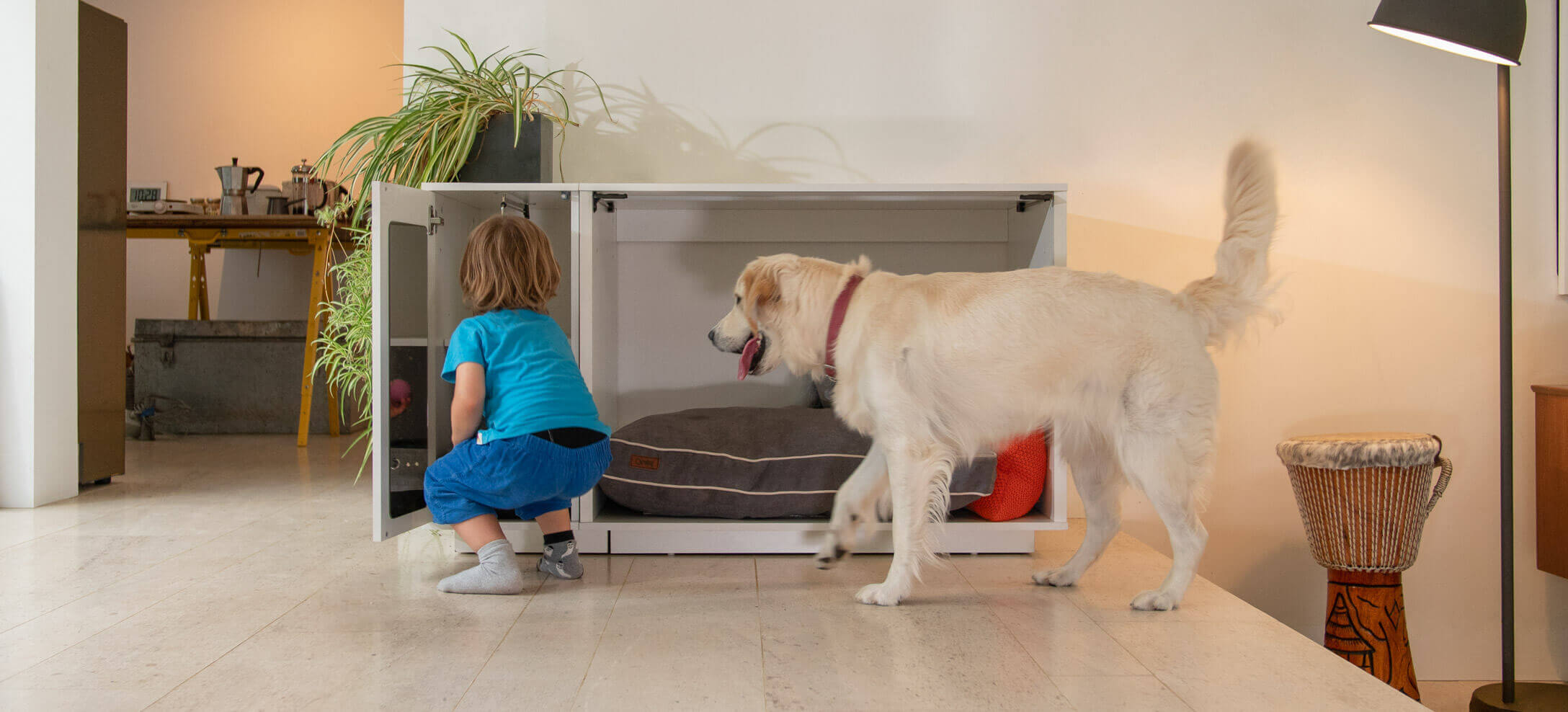
Dogs for People Allergic to Dogs!
Don’t despair! Your pet-induced sneezing and asthma doesn’t mean you can never be a dog owner. The thing you’re allergic to is a protein found on animals’ skin, and/or shed hairs. Although no breed is officially hypoallergenic, the commonest ones in families where allergies are a problem are:
- Poodle (both full size and Toy)
- Schnauzer
- Basenji
- Bichon Frise
- Samojed
- Shih Tzu
This is not a precise science, and some people are definitely more “allergic” than others. Many people who sneeze and wheeze at most dogs find that they are okay with Yorkies and Westies, even though these have longer hair than the average hound. At the same time, the short-haired Boxer can cause strong allergic reactions in many sufferers.
The key here is to spend some time with the breed before making the decision to bring one home.
The takeaway message is clear – there are many dog breeds out there, with many different personalities and requirements. Matching those traits to your own lifestyle and circumstances is the sure path to finding the perfect pet.
This entry was posted in Dogs
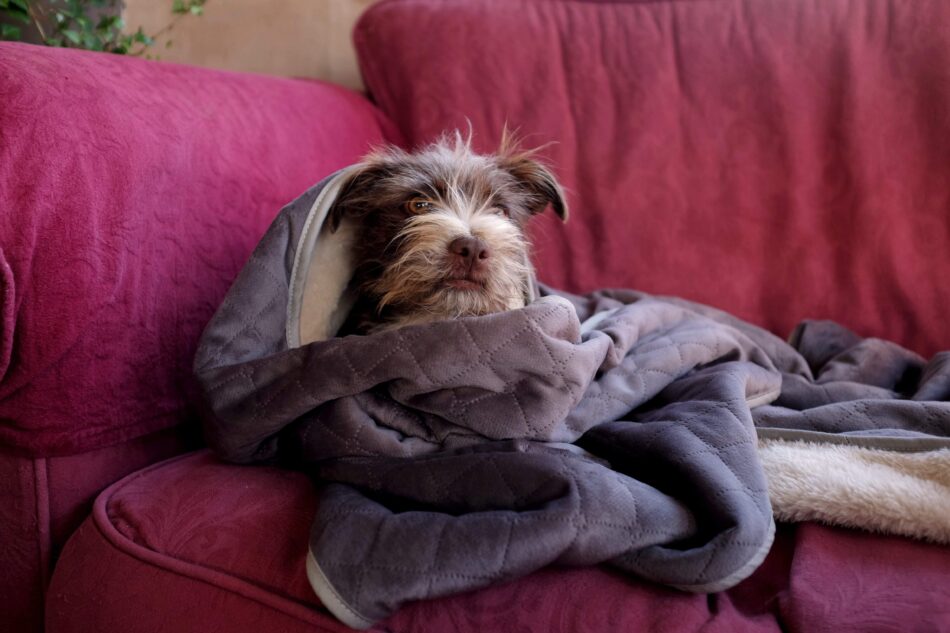
Whether it’s homemade treats, new toys or a long game of fetch that makes you late for work, there are many ways to show your dog how much you love them. But are you spoiling them? Probably. Does it matter? Probably not.
These are 20 tell-tale signs that suggest you’re spoiling your furry friend.
1.
There’s nothing in the snack cupboard except dog treats. That’s good, as it means you’re not feeding all the treats at once; but it’s not so good if you were looking for a crafty snack of your own…
2.
You’ve gone to the pet shop with your dog, and you’re letting them ‘choose’ the toys and chews they want. So far, you have a very full basket!
3.
You buy a bigger, better sprinkler for the garden just because your dog had such fun with the old one. The lawn doesn’t actually need the extra water at the moment, but your dog does!
4.
You buy a new squeaky toy to play tug-of-war with, even though the old ones are still in good shape. After all, this is the first time your pet has had a toy shaped like a lobster…
5.
You realise you’re looking forward to your dog’s day at the Puppy Spa next week as much as you’re looking forward to your romantic stay in a spa hotel the following weekend.
6.
Your bags of dog treats have healthier ingredients than your own treats – all organic, sustainably sourced, and packed with vitamins and minerals.
7.
Your afternoon dedicated to DIY has disappeared, dedicated instead to giving belly rubs, playing with sticks and balls, and going for a long, leisurely walk in the park to say hello to the ducks.
8.
The freezer has lots of yummy frozen doggy treats, but no ice creams or lollies for you and the kids.
9.
You’ve spent two hours in the kitchen baking. The result? Several trays of dog biscuits for your pet and all his doggy friends in the neighbourhood.
10.
You’re sitting on the not-very-comfy chair, because your dog is curled up on the comfier one.
11.
You’re not particularly enjoying the show on TV, but you keep it on because it’s your dog’s favourite.
12.
You buy toys and treats for your dog’s birthday or for their Christmas stocking – and hide them away on a high shelf to keep them secret until the big day.
13.
You phone home on a business trip, and your first question is “How’s the dog?”
14.
You’re an expert in dog massage and essential oils for dogs, but don’t know much about massage and essential oils for humans.
15.
You give your dog its dinner slightly early so that you can both sit down and watch the new Scooby Doo or Lassie film together later.
16.
Your dog’s annual hairdresser bill is bigger than yours.
17.
You have a list of all the local dog-friendly restaurants in your neighbourhood, and compile one for all the places you visit with your pet.
18.
Your dog’s ‘room’ under the stairs was planned and decorated with more care than your living room.
19.
You decide not to offload your bad day on the dog, because you don’t want them to worry.
20.
You’ve taken a trip to the seaside with your dog yet again. You hadn’t intended coming back so soon, but the dog insisted…
As long as it doesn’t involve overeating, over-fussing or over-exercising, there are all kinds of ways to spoil your dog. And the great thing is, the dog won’t feel spoilt at all, just loved.
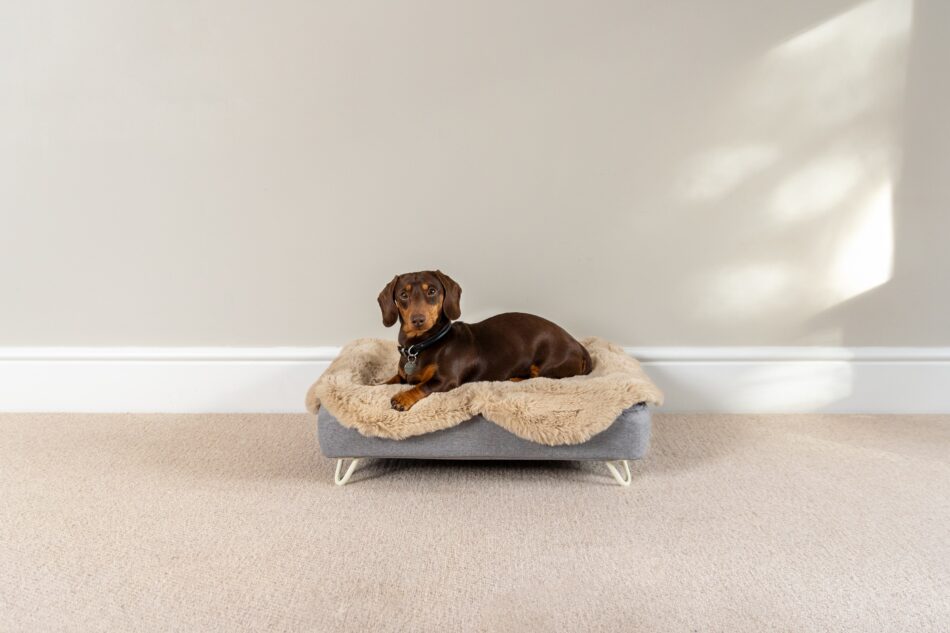
This entry was posted in Dogs
 Einfach Tierschutz: Einfach Tierschutz e.V. is the owner and operator of two animal shelters in Braila, Romania. In our “Phoenix Shelter”, where we take care of about 400 street dogs, just recently also cats, and try to find them a new home. They get medically treated and socialized every day in our spacious sanctuary.
Einfach Tierschutz: Einfach Tierschutz e.V. is the owner and operator of two animal shelters in Braila, Romania. In our “Phoenix Shelter”, where we take care of about 400 street dogs, just recently also cats, and try to find them a new home. They get medically treated and socialized every day in our spacious sanctuary. Since spring 2020, we have been running our second shelter specifically for puppies, the “Phoenix Puppy Shelter”, where up to 50 puppies and young dogs are fostered, cared for and prepared for placement in a family on an area of 2,000 m≤. In addition, we were able to move forward with a long-time wish in 2020 with the construction of the cat house on our premises. With the completion of this product, we can also provide our cats with safe and species-appropriate accommodations.
Since spring 2020, we have been running our second shelter specifically for puppies, the “Phoenix Puppy Shelter”, where up to 50 puppies and young dogs are fostered, cared for and prepared for placement in a family on an area of 2,000 m≤. In addition, we were able to move forward with a long-time wish in 2020 with the construction of the cat house on our premises. With the completion of this product, we can also provide our cats with safe and species-appropriate accommodations.














 Ethan, Natalie’s son, was diagnosed with Autism and ADHD aged four. Natalie gave up her job as a teacher to become Ethan’s full-time carer. She always had dogs as a child and, naturally, wanted Ethan to experience the same positive companionship. They went to a local farm and had the pick of three puppies. One was fast and furious, one was quiet and sleepy, and one was in-between. They picked the inbetweener and called him Buster.
Ethan, Natalie’s son, was diagnosed with Autism and ADHD aged four. Natalie gave up her job as a teacher to become Ethan’s full-time carer. She always had dogs as a child and, naturally, wanted Ethan to experience the same positive companionship. They went to a local farm and had the pick of three puppies. One was fast and furious, one was quiet and sleepy, and one was in-between. They picked the inbetweener and called him Buster.


 If you were to meet a species of animal for the first time and had to make an accurate guess about its diet, you would get lots of clues by looking at its teeth. The teeth of a dog, like the teeth of a bear, proclaim loud and clear that this animal is an omnivore – that is, one that eats both meat and vegetables. If you think of your dog as a domesticated wolf, you get a good idea of its natural diet.
If you were to meet a species of animal for the first time and had to make an accurate guess about its diet, you would get lots of clues by looking at its teeth. The teeth of a dog, like the teeth of a bear, proclaim loud and clear that this animal is an omnivore – that is, one that eats both meat and vegetables. If you think of your dog as a domesticated wolf, you get a good idea of its natural diet.
 1. Rabbits
1. Rabbits





 Mipit’s a Jug like Lottie, who Henley chose for his rebellious nature, but despite wayward first appearances, he’s proven to be intelligent, loving and loyal. Within a few weeks, Mipit was doing things that Lottie had taken months to learn, and Henley decided to focus her assistance dog training with Mipit.
Mipit’s a Jug like Lottie, who Henley chose for his rebellious nature, but despite wayward first appearances, he’s proven to be intelligent, loving and loyal. Within a few weeks, Mipit was doing things that Lottie had taken months to learn, and Henley decided to focus her assistance dog training with Mipit.
 It can be tricky to decide whether or not your dog should wear a collar or a harness for walks. A lot of it depends on your dog himself, from the breed to his age and activity level. No matter what type of breed you have, one thing’s for sure, they all need to go out on walks! The main two types of leash attachments that you can use for your dog are harnesses or collars.
It can be tricky to decide whether or not your dog should wear a collar or a harness for walks. A lot of it depends on your dog himself, from the breed to his age and activity level. No matter what type of breed you have, one thing’s for sure, they all need to go out on walks! The main two types of leash attachments that you can use for your dog are harnesses or collars. 













 Ingredients for the cake batter (for a ÿ25 cm cake tin):
Ingredients for the cake batter (for a ÿ25 cm cake tin):























 Don’t Drink the Water
Don’t Drink the Water
 What can I do to help my dog in old age?
What can I do to help my dog in old age? 






